How To Visit The Pyramids Of Giza & Sphinx In Egypt
What kind of bucket list doesn’t include the Great Pyramids of Giza in Egypt? Believe it or not, the Giza pyramids are fairly easy to visit on a day trip from Cairo, the capital of Egypt.
Built in 2560 BC, the Great Pyramid of Giza was the tallest man-made object in the world for 3,800 years. It’s the oldest of the Seven Wonders Of The Ancient World, and the only one still standing today.
Visiting the Egypt pyramids is a pretty simple experience, and there’s not a whole lot to do there except gaze at the big piles of rock, but it’s still a profound and unique experience that every traveler should check off their list.
This travel guide will explain how you can visit the Egyptian pyramids on your own, with or without a tour, and with a very modest budget and minimal planning!
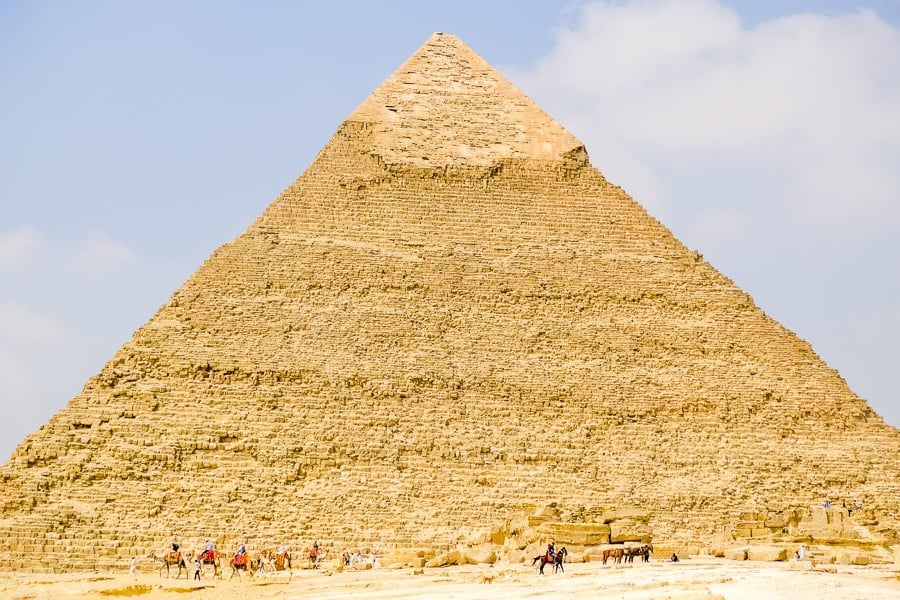

Quick Facts (Main Pyramid)
- Date: 2560 BC
- Height: 150 meters (500 ft)
- Base Length: 150 meters (500 ft)
- Weight: 6 million tons
- No. of Blocks: 2.3 million
- Builders: 200,000+
Best Day Tours To The Egypt Pyramids
First of all, if you’re on a tight schedule and want to skip the extra steps involved in arranging your own trip to the pyramids, or if you’d rather travel in a tour group for safety or convenience, there are options for doing that.
There are a number of companies that offer prearranged day tours to the Pyramids of Giza and the Sphinx for as low as $45 USD, complete with hotel transfer, optional camel ride, and same day return to Cairo.
If you’d rather make your own arrangements and go without a group, that’s covered next.

How To Get To The Giza Pyramids
The Great Pyramids are located on the outskirts of Giza , a suburb of Cairo, Egypt.
The nearest airport is the Cairo International Airport (CAI), which is served by a bunch of international airlines. You can shop for flights to Cairo at Skyscanner.
From the Cairo airport, it’s a 1 hour drive to Giza. The arrivals zone has plenty of taxis you can take, but I used Uber and I would highly recommend this because it’s much cheaper and probably safer too.
Do not rent a car in Egypt unless you are familiar with driving in the Middle East! Traffic in Arab countries is dangerous and chaotic, and you’ll be much better off going with a driver who’s familiar with how the traffic works here.
Besides, the drivers in Egypt are pretty affordable — as of 2020, the price for an Uber ride from Cairo to Giza is less than 200 EGP ($10 USD).

Giza Pyramids: What To Expect
If you’re staying at least one night in Giza, which I’d recommend, then you can drop off your luggage first at your hotel and then easily walk to the entrance of the pyramids and sphinx.
There are a bunch of hotels in Giza that are within a 5 minute walk to the main entrance for the pyramids, and they usually have great rooftop views to boot. More on that later.
If you’re ready to visit the pyramids, then just head up to the main ticket office and buy your tickets. The scammers and touts will already be trying to chat you up at this point, but you should ignore them.
As of 2020, the general ticket price is 120 EGP ($7 USD) and that gives you admission to the sphinx and the whole area surrounding the pyramids.
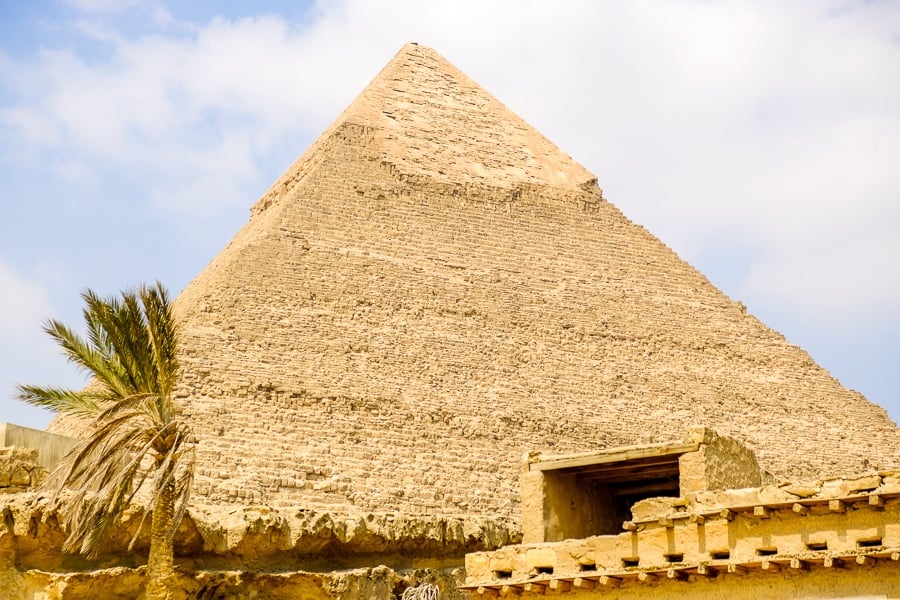
Camel Rides At The Egypt Pyramids
If you do go on a horse or camel ride, which I think is a great idea, then be sure to negotiate your price and terms BEFORE hopping on.
It’s common for the touts to try to come up with ridiculous prices after you’re already in the saddle and feeling obliged.
Do not pay before your ride either, handle the payment after your ride — no matter what they say!
As of 2020, the government of Egypt has a fixed price for the camel rides of 50 EGP (~$3 USD) for 30 minutes. There’s a sign near the entrance that says so, and you can always point to it if you’re having a hard time getting a fair price from the touts.

The Great Sphinx of Giza
Don’t forget to stop at the Great Sphinx too.
This mythical creature, with the body of a lion and the head of a pharaoh, is the oldest surviving sculpture in Egypt.
It’s also included in the same 120 EGP ticket you bought at the entrance for the pyramids, so just show your ticket at the doorway to the sphinx and you can walk up to it.

Hotels Near The Egyptian Pyramids
There are a bunch of neat hotels in Giza that are within a 5 minute walk to the main entrance for the pyramids, and they usually have awesome rooftop views of the whole area.
I would highly recommend staying at least one night in Giza, because it allows you to go at a relaxed pace and make the most of your time there.
It also makes it easy to do the Sound & Light Show, or just sit back and watch the sunset at Giza.

I stayed at Marvel Stone Hotel

I stayed at Marvel Stone Hotel for $32 USD/night, and it had a great rooftop terrace with views of the pyramids and sphinx, complete with easy chairs and even a pool table.
This was actually one of the highlights of my trip to Giza, because I was able to sit back and admire the pyramids and the camels running around in the distance — without being harassed by sellers and touts.
In the evening I watched the sunset over the Pyramid of Khafre and took some photos from the rooftop.

When Is The Best Time To Visit The Giza Pyramids?
Egypt has an arid climate, so it’s hot and dry year round.
The coolest months are from December to March, and this is probably the most popular time to visit the pyramids, but honestly any month in the spring or fall would also be fine.
I visited Egypt in September, and the heat was bad at times (mostly in Luxor), but I didn’t think it was too much of a problem in Giza. Northern Egypt is not nearly as hot as nearby Middle Eastern countries like Qatar or the United Arab Emirates.
You can take photos of the pyramids in the morning, but the dust will obscure the colors a bit. The best time of day for taking photos at the pyramids is around noon, when the dust clears up and the blue sky can be seen in the background.

- Egypt Travel Guide - Tips, Info & Photos
- Best Things To Do In Egypt
You may also like
How to visit tanjung puting national park in indonesia, coron vs el nido: which is better all differences explained, banggai islands travel guide & itinerary for sulawesi, paisu pok lake in banggai: bluest lake in indonesia, samet nangshe viewpoint: best sunrise spot in thailand, 13 best traditional shrines & temples to visit in japan.
What a great article! We’re currently dreaming of going to Egypt again – we’ve been there before and we love, love love it! Here’s to a year with loads of travel plans and new experiences!

Indeed, thanks!
I love the article
Fantastic guide! Planning my trip to the Pyramids of Giza, and your tips on day tours, getting there, and the camel rides are super helpful. Excited to tick this off my bucket list, thanks for the insights!
Nice! Have a great trip.
Leave a Comment Cancel Reply
Save my name, email, and website in this browser for the next time I comment.
Visiting the Nile Delta
Luxor Guide
Valley of the Kings
Visiting Alexandria
Traditional Food to Try
What to Drink in Egypt
Best Time to Visit
Weather & Climate
One Week in Egypt
Things to Do in Egypt
Must-See Ancient Sights
Guide to the Pyramids of Giza
Pyramids of Giza, Egypt: The Complete Guide
:max_bytes(150000):strip_icc():format(webp)/DSC00412-5b73daf7c9e77c0057ca2198.jpg)
Travelpix Ltd / Getty Images
The Great Pyramid of Giza
On the west bank of the River Nile lies Egypt’s most iconic ancient sight : the Pyramids of Giza. The site is made up of three separate pyramid complexes, including the Great Pyramid of Giza (also known as the Pyramid of Khufu), the Pyramid of Khafre and the Pyramid of Menkaure. The Great Sphinx of Giza stands sentinel over them all. All three pyramids were constructed by Fourth Dynasty pharaohs, making them over 4,500 years old. Together, they form part of the ancient Memphis necropolis and stand as a testament to the astonishing wealth, power and architectural prowess of the Ancient Egyptians. Find out how to visit the Pyramids with this guide.
Great Pyramid of Giza
The Great Pyramid of Giza is both the largest and the oldest of the Giza pyramids. It was constructed as a tomb and monument for the pharaoh Khufu, and completed around 2560 B.C. Like the other pyramids, it is built out of vast blocks of granite and limestone that would have been quarried, transported and assembled by hand. In total, around 2.3 million blocks of stone were used to create the pyramid, which was originally encased in smooth white limestone. According to the Greek historian Herodotus, this architectural feat required a workforce of 100,000 men and took 20 years to complete.
In its heyday, the pyramid would have stood 481 feet (146.5 meters) tall. It was the world’s tallest man-made structure for more than 3,800 years. The entrance is located on the north face and leads via a series of corridors to the Queen’s and King’s chambers. The pyramid was opened and looted by the pharaohs of the Middle and New Kingdoms, who may have used its contents to furnish their own tombs at the Valley of the Kings near Luxor . In Hellenistic times, the Great Pyramid was named as one of the Seven Wonders of the World. Despite being the oldest of the ancient wonders, it is also the only one that still exists today.
Pyramid of Khafre
The second-tallest of the Giza pyramids, the Pyramid of Khafre was built as the burial place of Khufu’s son and successor. The exact dates of its completion are not certain, although Khafre ruled from around 2558 to 2532 BC. Some of this pyramid’s original limestone casing remains around the apex, although the rest was removed at various times throughout its history – including during the Nineteenth Dynasty when Ramesses II looted the limestone for one of his temples at Heliopolis. This pyramid has two entrances which lead to a single burial chamber and a subsidiary chamber that may have been used for storage purposes.
Pyramid of Menkaure
The Pyramid of Menkaure is the smallest and most recent of the three and was likely completed at the beginning of the 25th century B.C. Unlike the other two pyramids, only the upper portion was encased in limestone and parts of the granite exterior appear unfinished. It’s likely that construction was interrupted by Menkaure's death and never completed. The pyramid has a single entrance leading to a subterranean burial chamber. At the end of the 12th century, it was the first victim of Sultan Al-Aziz Uthman 's attempt to demolish the pyramids. Fortunately the task proved too difficult and was abandoned; however, damage to the pyramid’s north face remains as proof of the vandalism.
Great Sphinx of Giza
The Great Sphinx of Giza is a mythical creature with the body of a lion and the head of a man. Egyptologists generally agree that its face was carved in Khafre’s likeness; which makes sense given the fact that it dates back to his reign. It is the oldest-known monumental sculpture in Egypt and is especially impressive when one considers that it was carved out of a single chunk of the plateau’s limestone bedrock. Layers of different density in the rock account for the accelerated erosion in the middle part of the sphinx’s body while theories abound as to the reason for its missing nose. It measures 240 feet (73 meters) in length and stands 66 feet (20 meters) high.
Modern Explorations
The Giza pyramids have been the subject of exploration and research for almost as long as they have existed. In the early 1800s, French archaeologist Auguste Mariette began clearance work on the Giza site. The first modern archaeologists to explore inside the pyramids included Giovanni Belzoni, John Perring and Richard Vyse, and Karl Richard Lepsius. In 1880, British archaeologist Sir William Matthew Flinders Petrie traveled to Giza to make the first scientific survey of the pyramids. His drawings and measurements were so accurate that much of our understanding of how they were built is still based on his findings.
Excavations continued throughout the 20th century and into the 21st. In 2010, Egyptian archaeologists discovered a worker’s burial ground that proved the pyramids were built by paid artisans rather than slaves. Most recently, in May 2019, a new cemetery and sarcophagi were uncovered that are believed to be over 4,500 years old. In 1979, the Pyramids of Giza were inscribed as a UNESCO World Heritage Site along with the rest of the Memphis necropolis .
Things to See & Do
Today, the three main pyramids and the sphinx are the main attractions; but there’s much more to see at Giza including a series of smaller, subsidiary pyramids, mastaba tombs, and temples. You can also view the ruins of the workers’ village, located to the southeast of the Khafre and Menkaure pyramids; and the Solar Boat Museum . The latter houses a boat that was found buried at the foot of the Great Pyramid and painstakingly reconstructed by experts over the course of 14 years. If you stay after dark, you can also watch as the pyramids are illuminated by the nightly Sound & Light Show .
General tickets include a tour inside one of the three satellite pyramids of the Queen of Cheops. If you want to view inside the three main pyramids, it’s possible to do so with the purchase of an additional ticket. There isn’t too much to see inside as the mummies and their treasures have been removed (either by looters, or to the safety of the Egyptian Museum ). Old Kingdom pharaohs also didn't decorate their burial chambers with hieroglyphs as later rulers did. However, the experience of venturing deep inside such ancient structures is worth it for many visitors—although claustrophobics should opt out. Climbing the pyramids is illegal.
How to Visit
Some people choose to join an organized tour . Benefits include a hotel pick-up, transfers from Cairo, included entry fees and an English-speaking Egyptologist guide; however, you’ll be traveling in a large group at the time when the pyramids are most crowded. Alternatively, it’s easy to explore the pyramids independently. Taxi or Uber rides from central Cairo take approximately an hour (depending on traffic) and are amazingly affordable. Public buses also travel from outside the Egyptian Museum to the pyramids.
When you get there, you can choose to wander the complex on foot or hire a camel or horse. The latter is a popular option for those that want to venture into the desert to get a panoramic view of the pyramids; however, many of the animals are poorly treated or underfed. The best views are from the dunes behind the Pyramid of Menkaure, and include all three temples juxtaposed against the modern Cairo skyline in the distant background. Sturdy footwear, ample sun protection and plenty of water are all must-haves for your Giza adventure.
If you want to avoid the crowds, try visiting a little later in the day after the majority of the tour buses have been and gone (most arrive between 9:30 a.m. and 10:30 a.m.).
Hours & Admission Fees
According to the official Egyptian tourism website , the site opens at 9 a.m. every day and closes at 5 p.m. Ticket prices are listed as 60 Egyptian pounds for general admission, 100 Egyptian pounds for entry into the Great Pyramid, 30 Egyptian pounds for entry into the Pyramid of Khafre and 25 Egyptian pounds for entry into the Pyramid of Menkaure. The Sound & Light Show costs US$15 and should be booked in advance.
Pyramid of Djoser, Egypt: The Complete Guide
One Week in Egypt: The Ultimate Itinerary
10 Destinations to Top Your Africa Bucket List
Cairo Guide: Planning Your Trip
How to Visit Saqqara, Egypt: The Complete Guide
Egypt's Top 10 Ancient Sites
48 Hours in Cairo: The Ultimate Itinerary
The 12 Best Day Trips From Cairo
Top 10 Destinations in North Africa
Temple of Horus at Edfu, Egypt: The Complete Guide
The Valley of the Kings, Egypt: The Complete Guide
Your Trip to Egypt: The Complete Guide
25 Top Things to Do in Egypt
Lake Nasser, Egypt: The Complete Guide
The 18 Best Things to Do in Cairo, Egypt
Currency in Egypt: Everything You Need to Know

Pyramids of Giza: Attractions
Written by Jess Lee Updated Dec 25, 2023 We may earn a commission from affiliate links ( )
You'll have seen a thousand photographs of the Pyramids of Giza by the time you finally get here, but nothing beats getting up close and personal with these ancient monuments.
Egypt's most famed and feted structures, these ancient tombs of kings guarded by the serene Sphinx have wowed spectators for centuries.
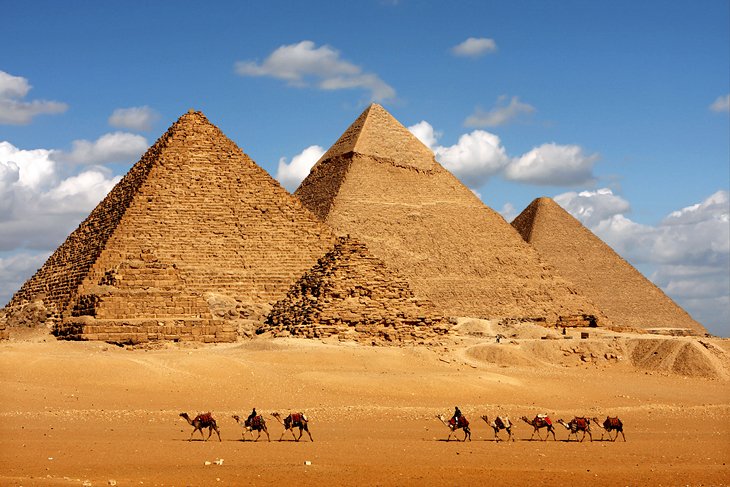
Today, the Pyramids of Giza continue to work their magic on all who visit. No trip to Egypt is complete without time spent here at one of the world's most famous tourist attractions .
Towering incongruously over the edge of Cairo's suburban sprawl, these mighty monuments are a tribute to the power and ambition of Egypt's Pharaonic rulers.
See also: Where to Stay near the Pyramids of Giza
1. Great Pyramid (Pyramid of Cheops or Pyramid of Khufu)
2. eastern cemetery, 3. western cemetery, 4. pyramid of chephren (pyramid of khafre), 5. pyramid of mycerinus (pyramid of menkaure), 7. camel & horse rides at the pyramids, 8. pyramids sound & light show, 9. the grand egyptian museum (gem), history of the pyramids of giza: the only surviving wonder of the ancient world, where to stay near the pyramids of giza, tips and tours: how to make the most of your visit to the pyramids of giza, getting to the pyramids of giza.
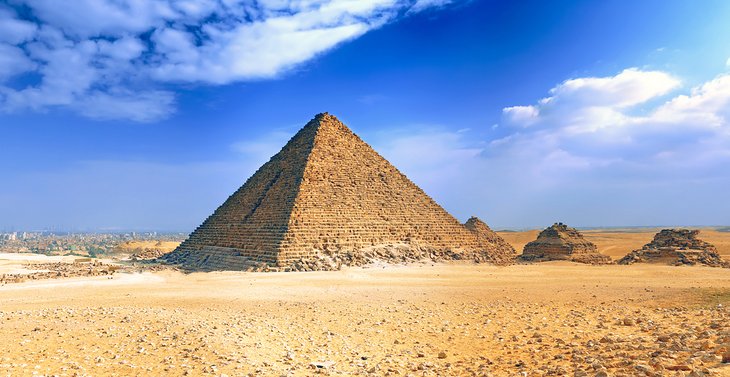
Giza's Great Pyramid (also called the Pyramid of Cheops) is not only this ancient site's most famous monument but one of the most well-known monuments in the world .
It was built by the Pharaoh Khufu (commonly called by its Greek transliteration of Cheops) and was known to the ancient Egyptians as Ekhet Khufu ("Horizon of Khufu"). According to Herodotus, 100,000 men worked on its construction for three months every year.
This mammoth structure's cubic content is staggering. Excluding the rock foundation and the interior chambers, the Great Pyramid is 2.3 million cubic meters. The base measurement is 227.5 meters, and the vertical height is 137.2 meters.
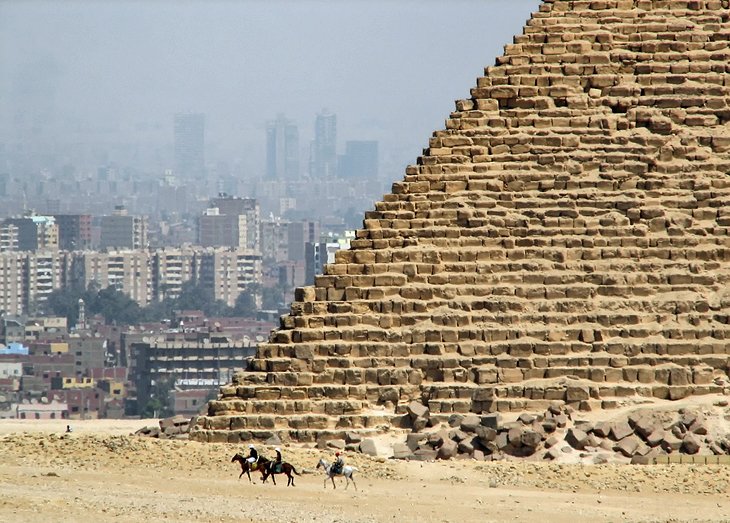
The non-claustrophobic can venture into the pyramid's bowels, although there isn't much to see once inside the dank, narrow corridors.
The entrance is by a passage that was cut by tomb robbers some 15 meters below the original entrance. This narrow tunnel leads into the Grand Gallery, a long passage that is a marvel of skillful masonry.
Beyond this is the tomb chamber containing the open, empty, granite sarcophagus, which once would have contained Khufu's mummy.
Excavations on the south and east sides of the Great Pyramid in 1954 brought to light five long cavities for boats, with a 4,500-year-old cedar wood solar barque broken into more than a thousand pieces as a votive offering.
Up until 2021, the painstakingly restored boat was exhibited in a small one-room museum just beside the Great Pyramid, but has now been moved to form part of the collection inside the new (as yet unopened) Grand Egyptian Museum.
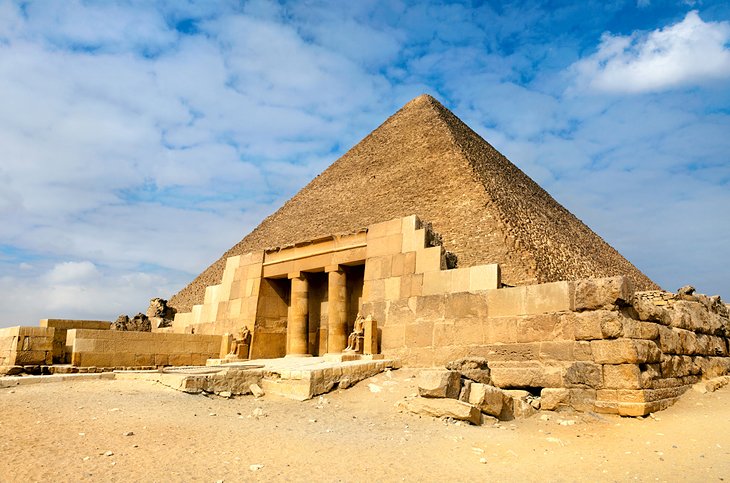
On the eastern side of the Pyramid of Cheops are three smaller pyramids, made as tombs for queens and a daughter of the Pharaoh , and a large cemetery for other relatives.
On the south side is a row of large mastabas (tombs) belonging to high dignitaries.
Two mastabas are open for visitors in the eastern cemetery.
The Mastaba of Meresankh III (wife of Pharaoh Khafre) has intricate and colorful reliefs on the interior walls depicting scenes from daily life.
The Mastaba of Seshemnufer IV has an ornate columned entranceway, though is plainer inside.
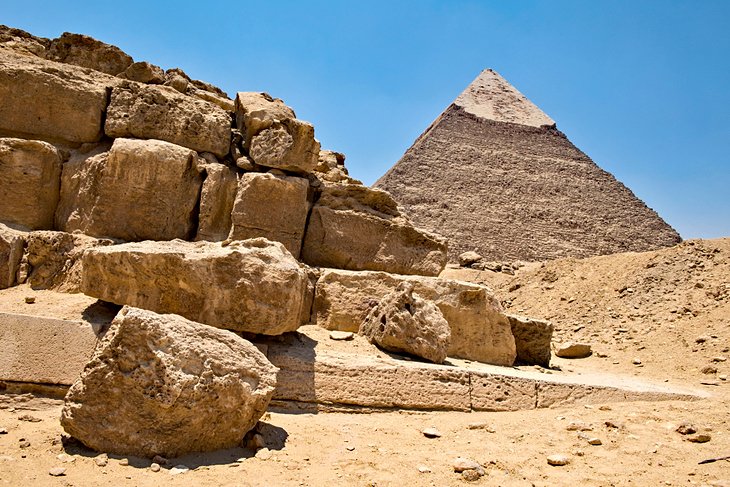
To the west of the Pyramid of Cheops is the extensive royal cemetery for members of the Royal House and high state officials, established during the fourth Dynasty and used until the sixth.
Here, you'll find the small, columned entry of the Tomb of Senegemib-Inti, which contains some interesting wall carvings.
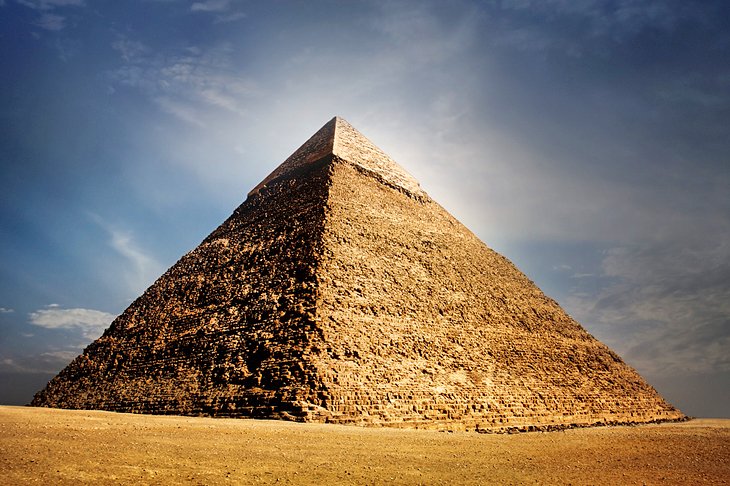
The Pyramid of Chephren (Pyramid of Khafre) sits 160 meters to the southwest from the Great Pyramid.
Built by Khufu's son Khafre, it at first appears to be larger than his father's earlier pyramid as it stands on a higher piece of land.
A considerable section of the original limestone casing has managed to be preserved on the apex of the pyramid, and the layout of the mortuary temple on the east side can be clearly distinguished.
The pyramid has a height of 135.5 meters and a base measurement of 210.5 meters.
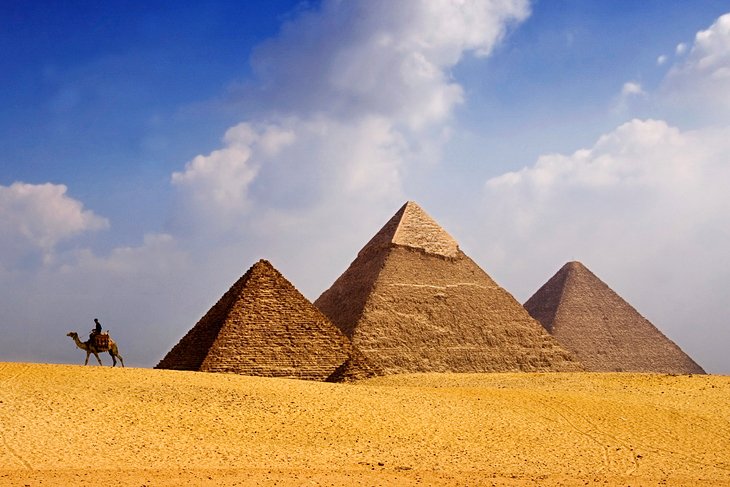
The smallest of the three main Giza pyramids is the Pyramid of Mycerinus (Pyramid of Menkaure), made of unusually large limestone blocks.
It has a vertical height of 62 meters and a base measurement of 108 meters.
On the south side of the pyramid are three smaller pyramids, left unfinished, for relatives of the Pharaoh.
The best panoramic pyramid views of the entire site are from the rocky escarpment four kilometers south of the Pyramid of Mycerinus.
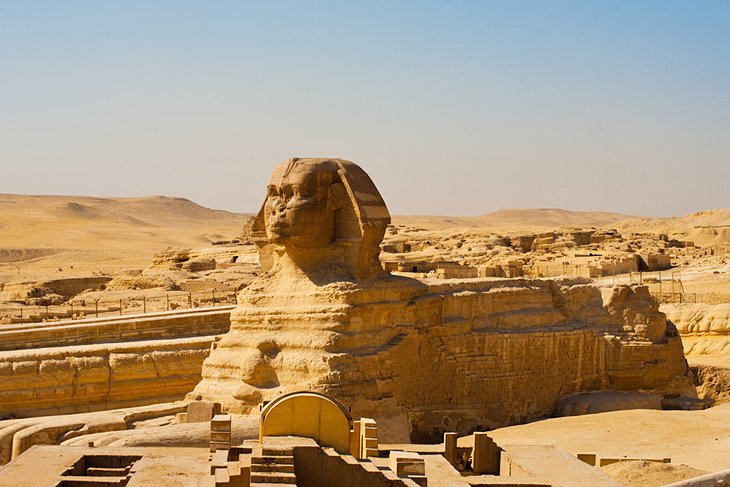
Perhaps the most celebrated monument in Egypt after the Great Pyramid itself, the enigmatic Sphinx is a simple but finely built granite structure shaped like a recumbent lion that sits immediately east of the pyramids.
Hewn from the natural rock, it has the head of a pharaoh (commonly thought to be Chephren) and wears the royal head-cloth and cobra.
Weathering and deliberate mutilation have wrought much damage over the course of the centuries, but in spite of this, the Sphinx still conveys a powerful impression of majesty and artistic achievement.
The total length of the figure is 73.5 meters, and its height is 20 meters.
Despite what some tour guides still insist on telling visitors, Napoleon is not responsible for the missing nose on the Sphinx's face.
According to Arab historians, the nose is thought to have been destroyed at some stage in the Islamic Empires era.
One 14th-century story tells of a pious Muslim, being so upset that locals still made offerings to the Sphinx in the hope that this practice would control the annual Nile flood and hence bring a good harvest, that he hammered off the Sphinx's nose.
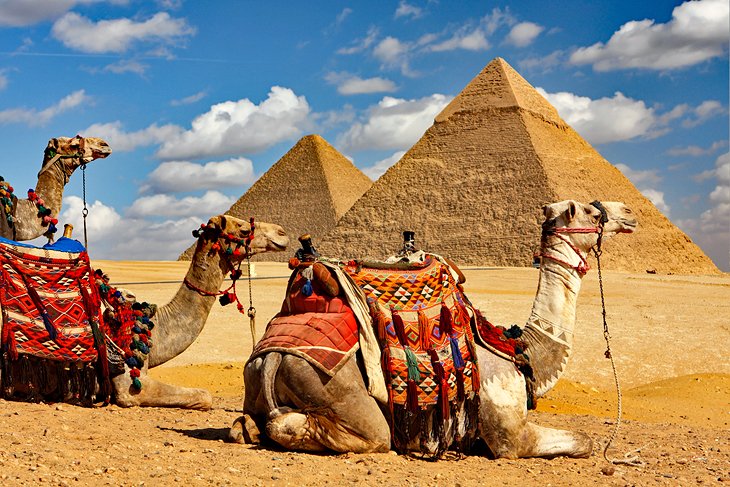
If you want to horse ride at the pyramids, it is well worth heading to the village stables (by the Sphinx car park), where the guides are recommended and the horses are kept in good condition.
The best time to go for a horse ride in the pyramid area is sunset , when you can head out into the surrounding desert for views of the monuments as the sun sinks.
Although it's something of a cliché, a camel ride in front of the pyramids is one of those tick-the-list Egyptian things to do. If you're going to get on a camel once during your trip, it should be here.
Unfortunately, many of the camels are not kept in good condition, so it's of the utmost importance that you choose your operator carefully and make sure the camel is healthy and well-fed.
The overly-aggressive camel-touts who hang out on the roadside just before the main entrance ticket office are best avoided.
Prepare to bargain. There's an "official" price of EGP 50 per 30 minutes, but no one keeps to it, and you are expected to cheerfully haggle instead.
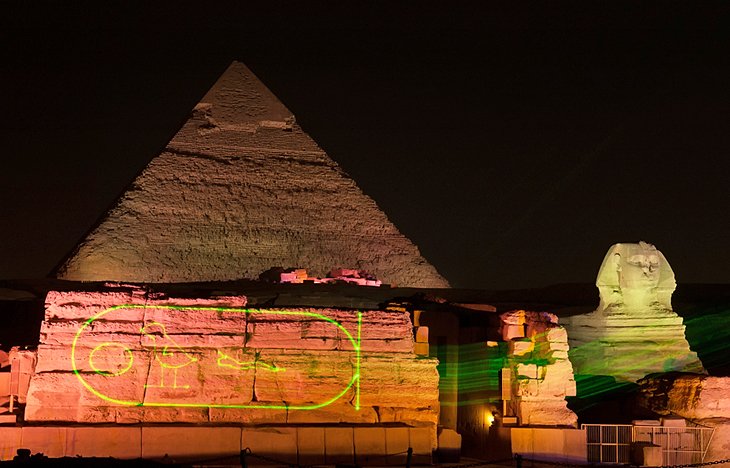
The Sound and Light Show at the Giza Pyramids allows you to see these ancient monuments lit up under the night sky with a narrative soundtrack provided by the Sphinx.
This Pyramids Sound and Light Show tour includes tickets to the show, as well as pickup and drop-off from your Cairo hotel.
Currently nearing completion, The Grand Egyptian Museum (GEM), when opened, will be the largest museum in the world devoted to one civilization .
The museum is situated on the Giza Plateau, about 2.5 kilometers northwest of the main entrance into the pyramids complex, and when opened, will take the place of the Egyptian Museum (in Downtown Cairo) as the city's main Egyptology museum.
In the museum, the full cache of Tutankhamun's funerary treasure will be on permanent display for the first time since his tomb was discovered in 1922, as well as many other pharaonic artifacts and riches that have never been displayed before due to lack of space.
Opening is pegged for November 2022. Once open, expect tour itinerary offerings to change to reflect this; with the museum just a hop away from the pyramids, most tours will bundle the two together.
Independent travelers with an interest in Egypt's rich history will most likely want to devote an entire day to Giza's tourist attractions once the museum is open.
There is also talk of connecting the museum and pyramids complex by a pedestrian walkway so that visitors who want to walk between the two don't have to use the busy main road.
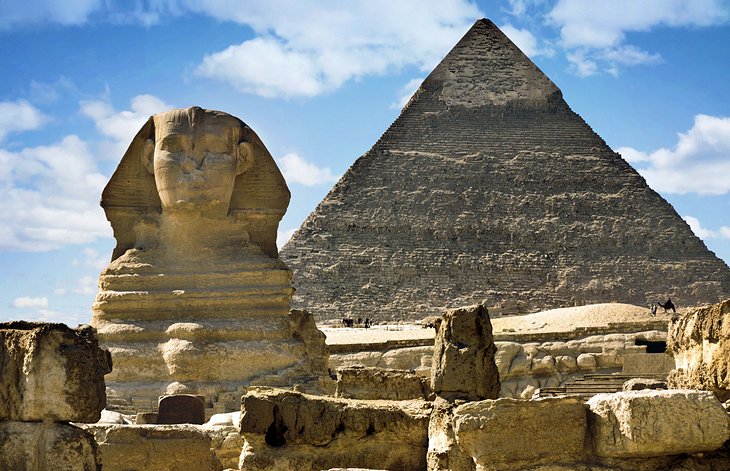
Built by the rulers of Egypt's Fourth Dynasty (c. 2600-2500) the Pyramids of Giza rank among the oldest surviving man-made structures in the world.
During the Greek and Roman eras, they were marveled at as the first of the Seven Wonders of the World, and they still exert a powerful fascination, both as an extraordinary technical achievement and as a demonstration of the power of the pharaohs, who could marshal tens of thousands of subjects to construct these colossal monuments.
The question of the relationship between the size of a pyramid and the ruler for whom it was built is still unsettled.
It seems probable, however, that the size depended on the pharaoh's personal inclination, power, and economic resources.
It has not been possible to prove an alternative theory that the size of a pyramid might have been increased in stages during the course of a lengthy reign.
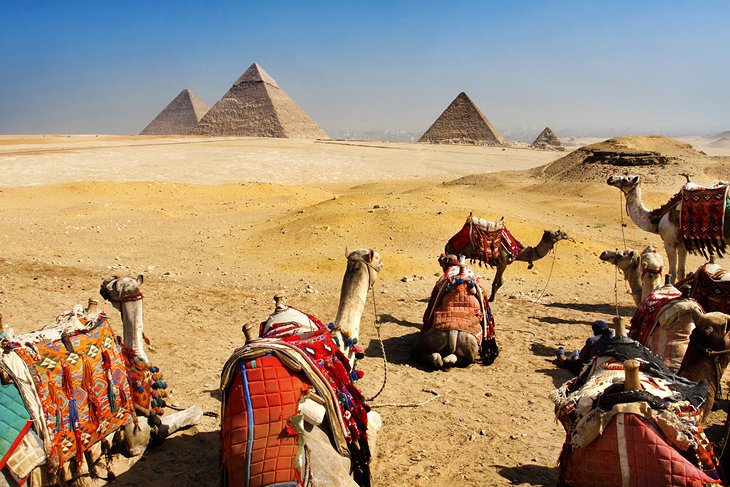
Features common to all the pyramids are their situation on the edge of the desert to the west of the Nile and their structure, which was built up from huge blocks of the local limestone and enclosed in a casing, originally polished, of fine-grained white limestone or granite.
Concealed within the great bulk of the pyramid (in the later period) or underground beneath its base (in the earlier period) were the relatively small tomb chamber, a chamber for the cult of the dead pharaoh, and other chambers for the grave goods.
Also common to all pyramids were the entrance on the north side and the mortuary temple on the east side, with a causeway (originally open, later frequently covered) leading up to it from a valley temple on the edge of the Nile Depression.
Luxury Hotels:
- Just steps away from the main entrance to the Pyramids, the historic Marriott Mena House, Cairo has hosted royalty and celebrities amid its 40-acre grounds. There's an outdoor pool amid sprawling lush gardens, and the interior spaces are scattered with antiques.
- The Four Seasons Hotel Cairo at the First Residence is on the Nile's west bank. There are five restaurants and lounges, a pool, and holistic spa, and the large rooms are elegantly attired.
Mid-Range Hotels:
- Sitting just under two kilometers from the main entrance to the Pyramids, the Steigenberger Pyramids Cairo is a five-star resort with mid-range rates. Spacious rooms all have balconies (some with Pyramid views), there is a choice of dining options on-site, and the grounds contain two outdoor swimming pools.
Budget Hotels:
- In the Giza area, with views of the Pyramids from some rooms, Pyramids View Inn has a rooftop with panoramic vistas, a complimentary breakfast, and friendly staff.
Anyone with a decent fitness level can easily walk between the pyramids and the Sphinx (as long as it's not too hot), but if you want to go up to the panoramic viewpoint, you'll need transport within the site. The easiest way to do this is to arrange an organized tour of the area, which means you'll have an air-conditioned vehicle at your disposal. A good tour guide can also help you understand the baffling, long history on display here and help you cope with the many camel and souvenir touts, which can make all the difference to enjoying your visit in the desert heat.
- Full-Day Tour : History lovers will appreciate the Giza Pyramids, Sphinx, Memphis and Saqqara Private Tour , which includes a full day of exploring all the ancient sites in Giza, and beyond to even older Saqqara and Memphis, with an Egyptologist guide. If you want to pack all your pharaonic sightseeing in Cairo into one day, this is an excellent choice, with transport provided from your hotel door.
- Half-Day Tour: If you want to take your sightseeing at a more mellow pace, the Giza Pyramids and Sphinx Private Tour is a half-day trip of the attractions of the Giza Plateau with an Egyptologist guide. It includes pickup and drop-off from your hotel.
- Camel or Horse Riding Tour: For views of the Pyramids and desert beyond, this Sunset Camel or Horse Riding Tour is a great option. It includes pickup and drop-off from your Cairo hotel and your choice of either riding a camel or horse in the desert plains surrounding the Pyramids as the sun sets.
Admission and Visiting
- Timing Your Visit: To escape the crowds and the worst of the desert heat, the earlier you can get here, the better. If you want to enter the interior of the Great Pyramid, also be aware that limited numbers of Great Pyramid entry tickets are sold on a first-come-first-served basis twice a day, at 8am and again at 1pm.
- Tickets: If you miss out on Great Pyramid interior tickets don't fret. Tickets for the interior of the Pyramid of Chephren are sold throughout the day with no limit on numbers.
- By Private Taxi: The easiest, and most popular, way of getting here for independent travelers is by hiring a taxi for a half-day trip in Cairo. The taxi can then shuttle you around the site (if you wish) and return you back to the central city afterwards. If you hire a taxi one way, you can find a return taxi by the Sphinx entrance to take you back into town.
- By Local Transport: You can get to the pyramids using a combination of the Cairo Metro and minibus. Take the metro to Giza and then take a minibus (right outside the Giza metro station exit) or taxi to the pyramids.
More Related Articles on PlanetWare.com
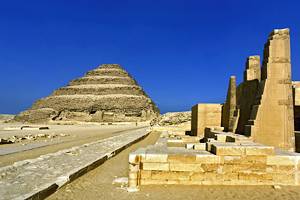
Around the Pyramids: Be sure to schedule plenty of time into your Egypt itinerary to see some of the countries cities and other wonderful sites. Check out our articles on things to in Cairo , exploring Saqqara , and visiting the attractions of Alexandria .
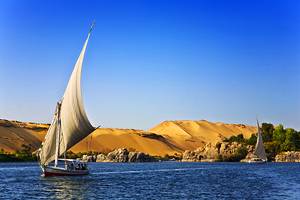
Heading up the Nile: See our articles on Luxor and Aswan if you want to delve into more pharaonic sights. These beautiful cities on the Nile are fun places to visit and are packed with incredible sites, including Abu Simbel , easily visited from Aswan .

More on Egypt
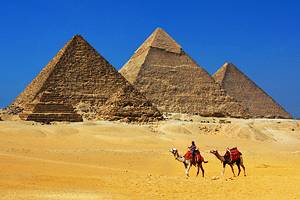
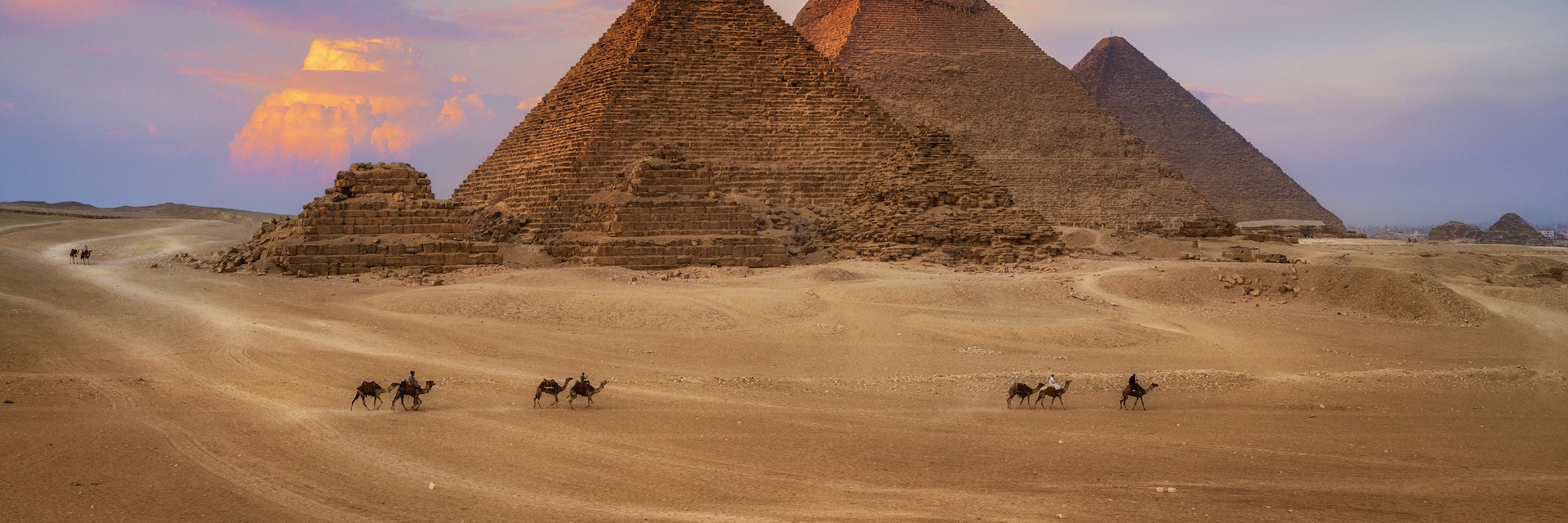
© Ratnakorn Piyasirisorost / Getty Images
Pyramids of Giza
Top choice in Giza
The last remaining wonder of the ancient world; for nearly 4000 years, the extraordinary shape, impeccable geometry and sheer bulk of the Giza Pyramids have invited the obvious questions: ‘How were we built, and why?’. Centuries of research have given us parts of the answer. Built as massive tombs on the orders of the pharaohs, they were constructed by teams of workers tens-of-thousands strong. Today they stand as an awe-inspiring tribute to the might, organisation and achievements of ancient Egypt.
Ongoing excavations on the Giza Plateau, along with the discovery of a pyramid-builders' settlement, complete with areas for large-scale food production and medical facilities, have provided more evidence that the workers were not the slaves of Hollywood tradition, but an organised workforce of Egyptian farmers. During the flood season, when the Nile covered their fields, the same farmers could have been redeployed by the highly structured bureaucracy to work on the pharaoh’s tomb. In this way, the Pyramids can almost be seen as an ancient job-creation scheme. And the flood waters made it easier to transport building stone to the site.
But despite the evidence, some still won’t accept that the ancient Egyptians were capable of such achievements. So-called pyramidologists point to the carving and placement of the stones, precise to the millimetre, and argue the numerological significance of the structures’ dimensions as evidence that the Pyramids were constructed by angels or aliens. It’s easy to laugh at these out-there ideas, but when you see the monuments up close, especially inside, you’ll better understand why so many people believe such awesome structures must have unearthly origins.
Most visitors will make a beeline straight to the four most famous sights; the Great Pyramid of Khufu , the Pyramid of Khafre , the Pyramid of Menkaure and the Sphinx . But for those who want to explore further, the desert plateau surrounding the pyramids is littered with tombs, temple ruins and smaller satellite pyramids.
Suggest an edit to this attraction
Lonely Planet's must-see attractions
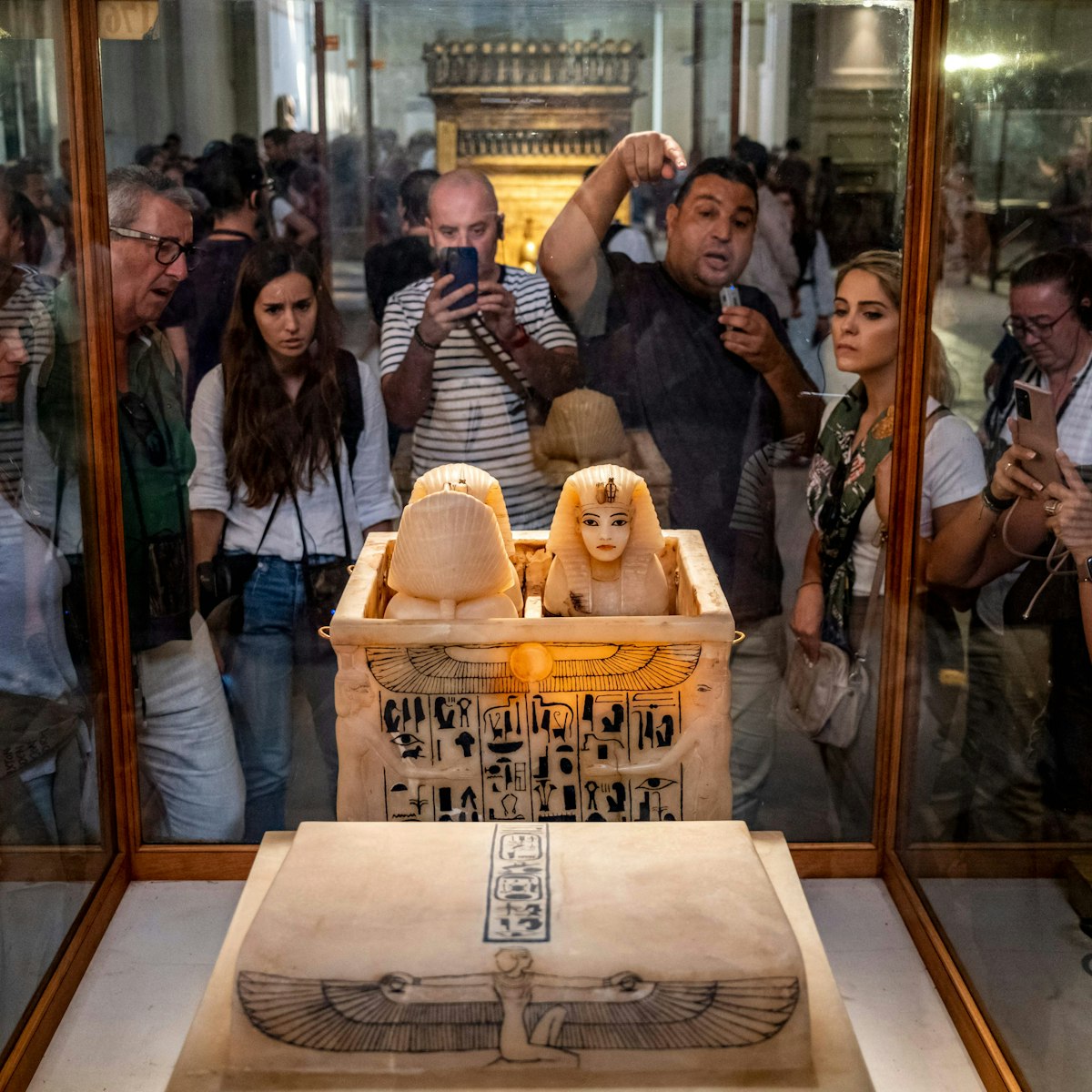
Egyptian Museum
One of the world’s most important collections of ancient artefacts, the Egyptian Museum takes pride of place in Downtown Cairo, on the north side of Midan…
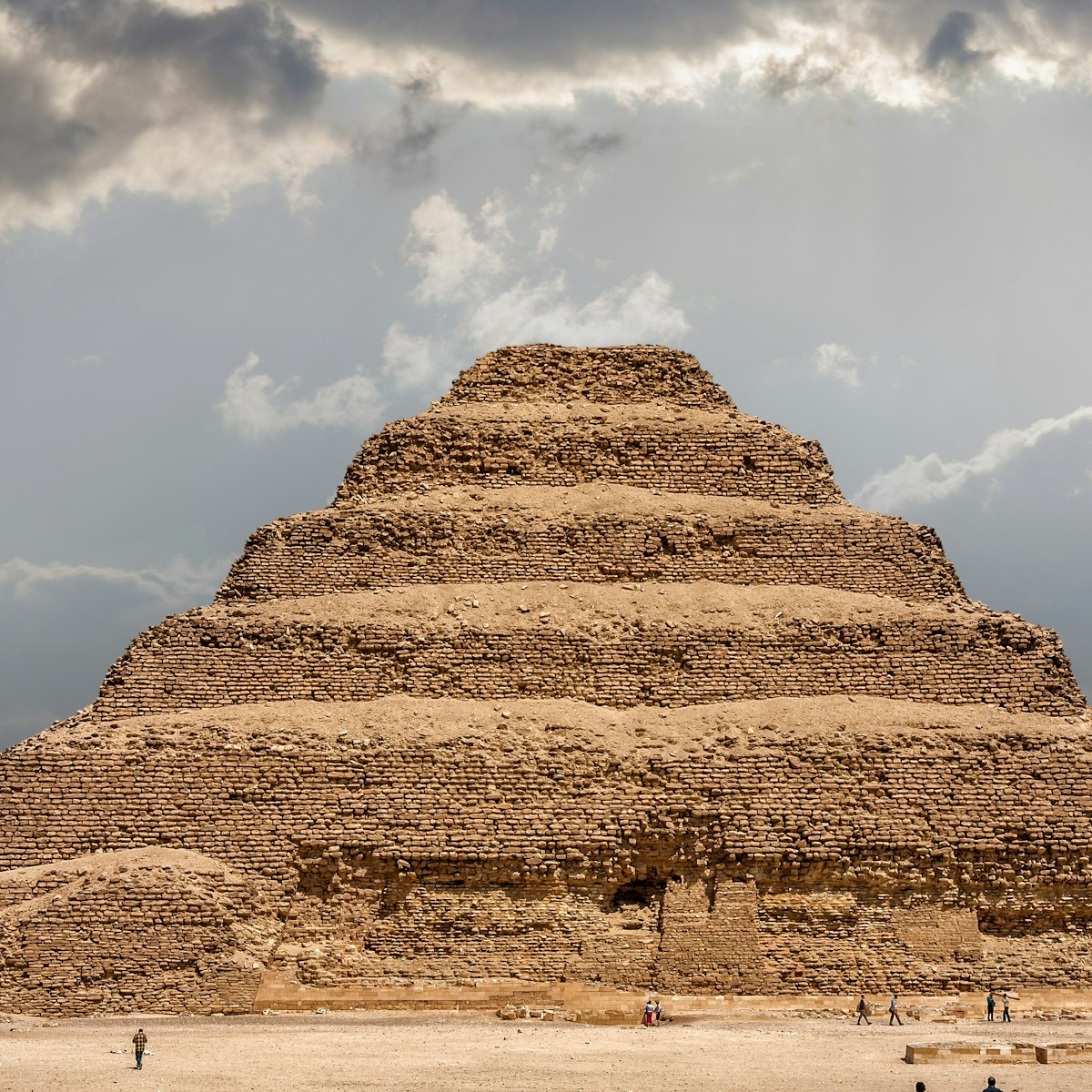
Covering a 7km stretch of the Western Desert, Saqqara, the huge cemetery of ancient Memphis, was an active burial ground for more than 3500 years and is…
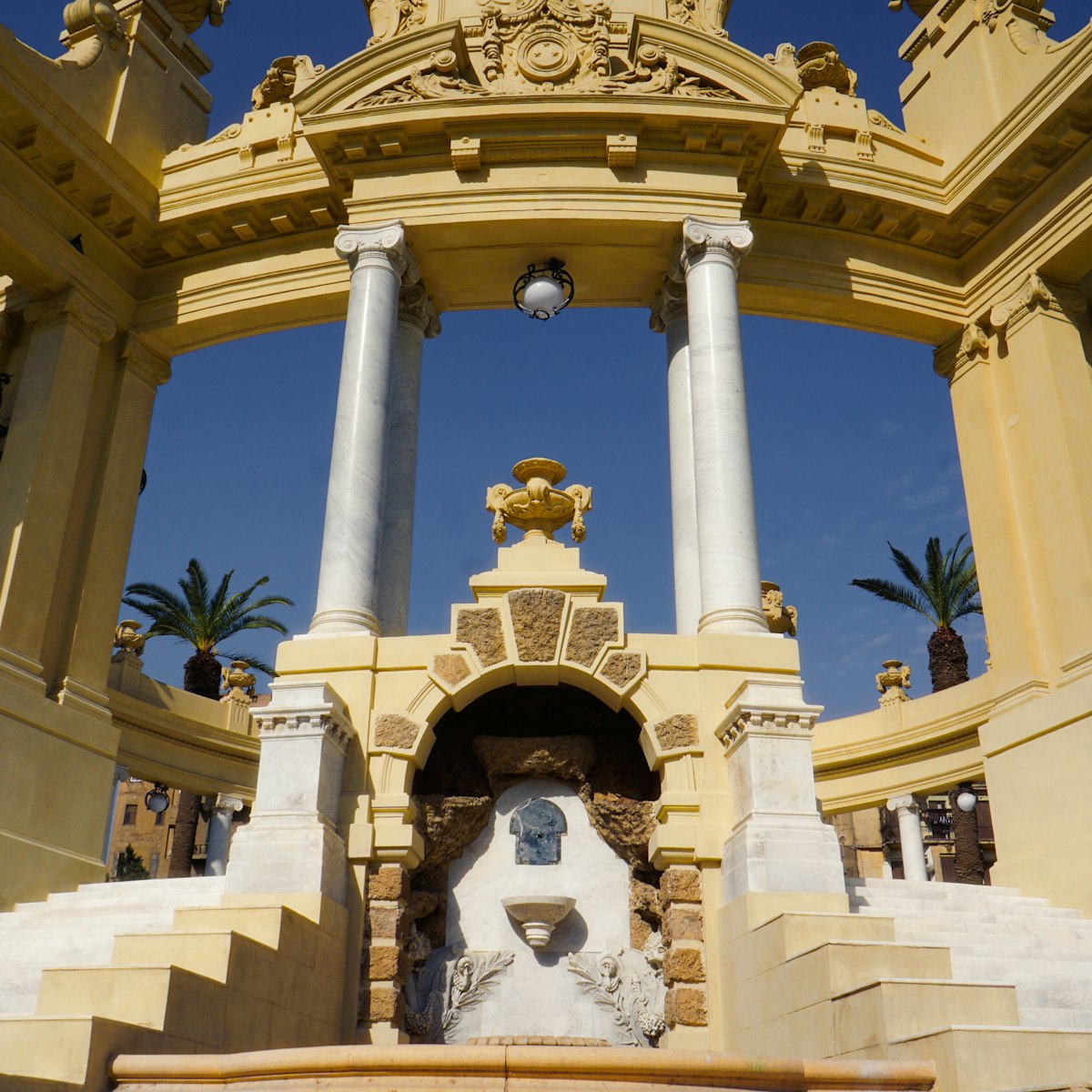
Museum of Islamic Art
This museum, on the edge of Islamic Cairo, holds one of the world’s finest collections of Islamic art and is Egypt's (and one of the entire Middle East's)…
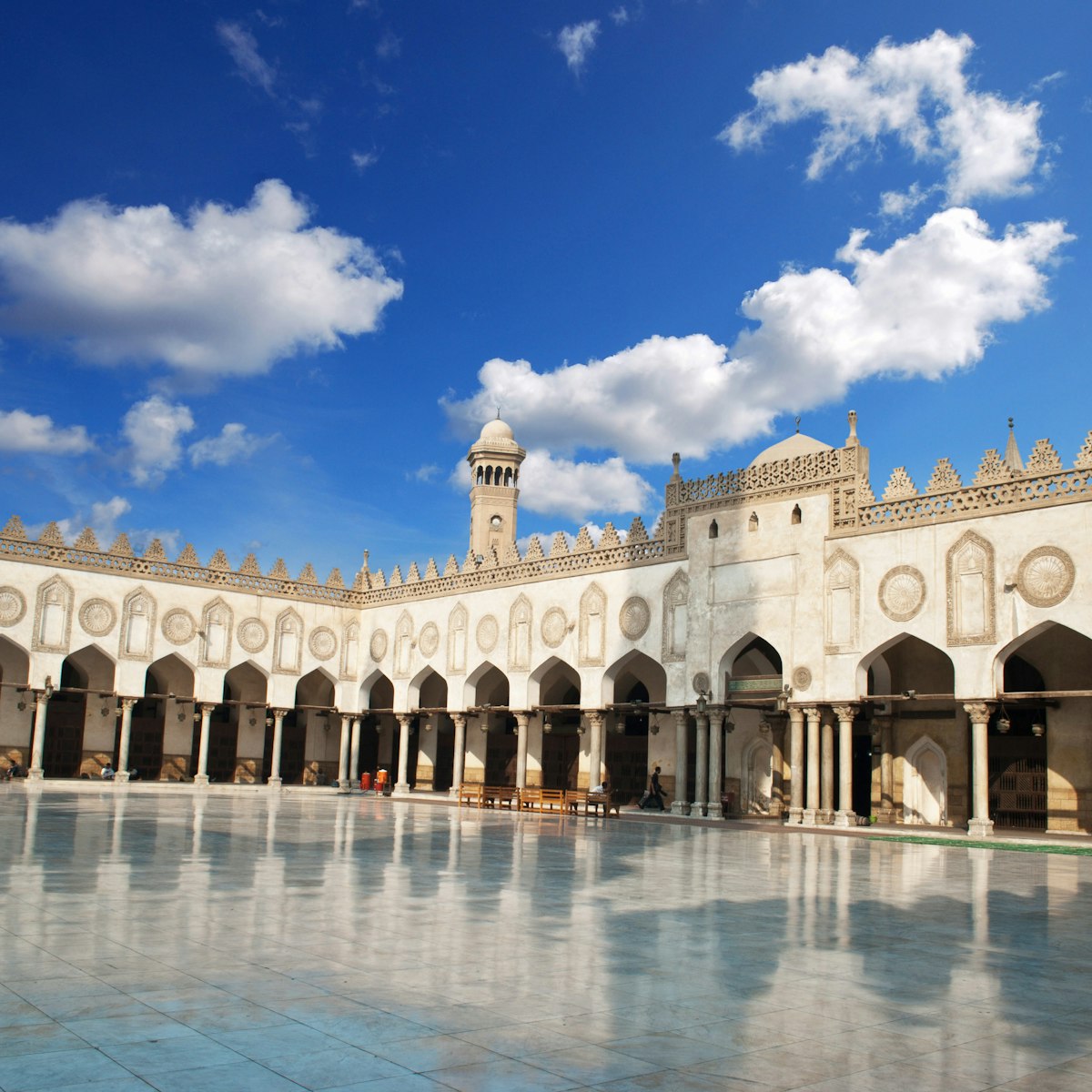
Al Azhar Mosque
Founded in AD 970 as the centrepiece of the newly created Fatimid city, Al Azhar is one of Cairo’s earlier mosques, and its sheikh is considered the…
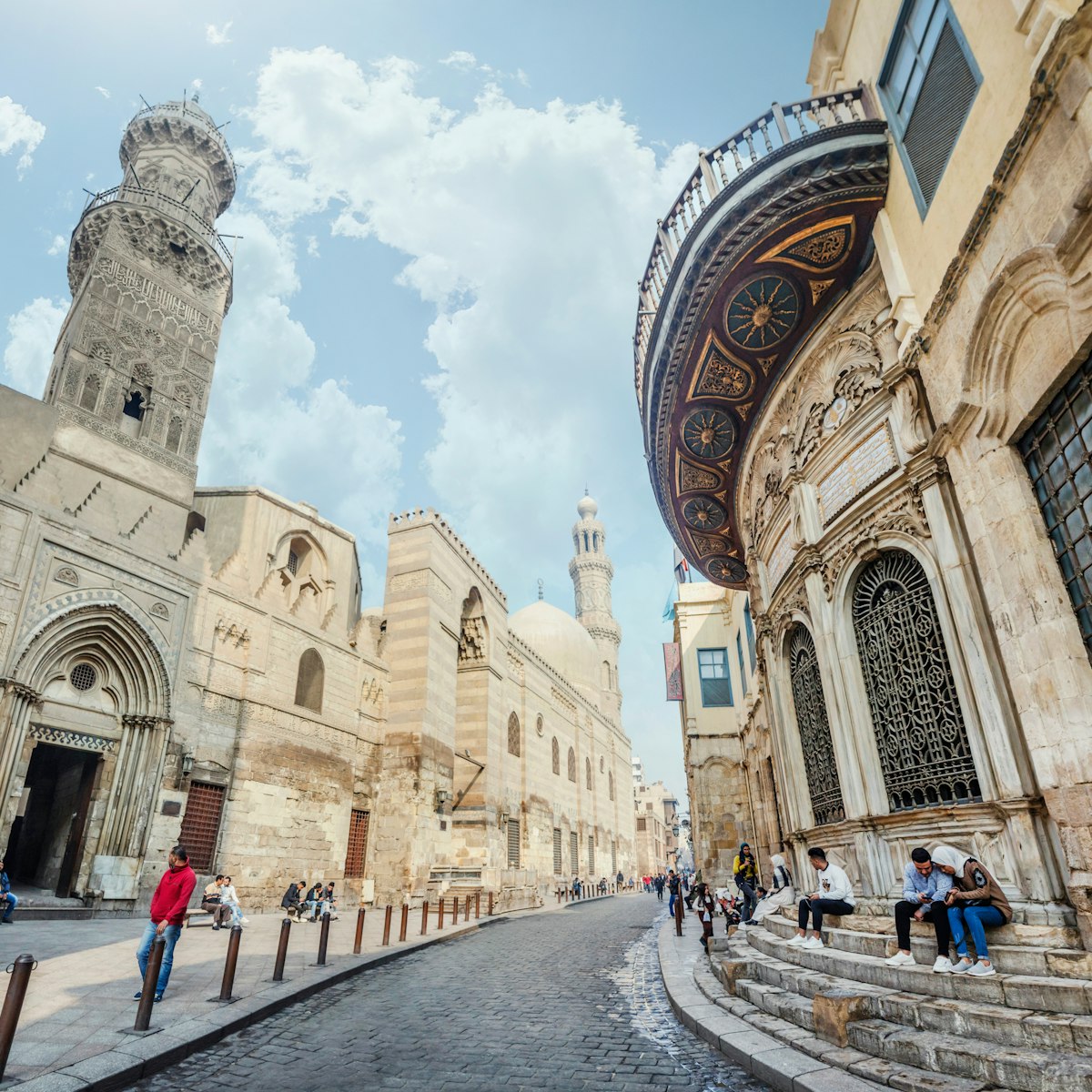
Sharia Al Muizz Li Din Allah
Sharia Al Muizz, as it’s usually called, named after the Fatimid caliph who conquered Cairo in AD 969, was Cairo's grand thoroughfare, once chock-a-block…

Coptic Museum
This museum, founded in 1908, houses Coptic art from the earliest days of Christianity in Egypt right through to early Islam. It is a beautiful place, as…
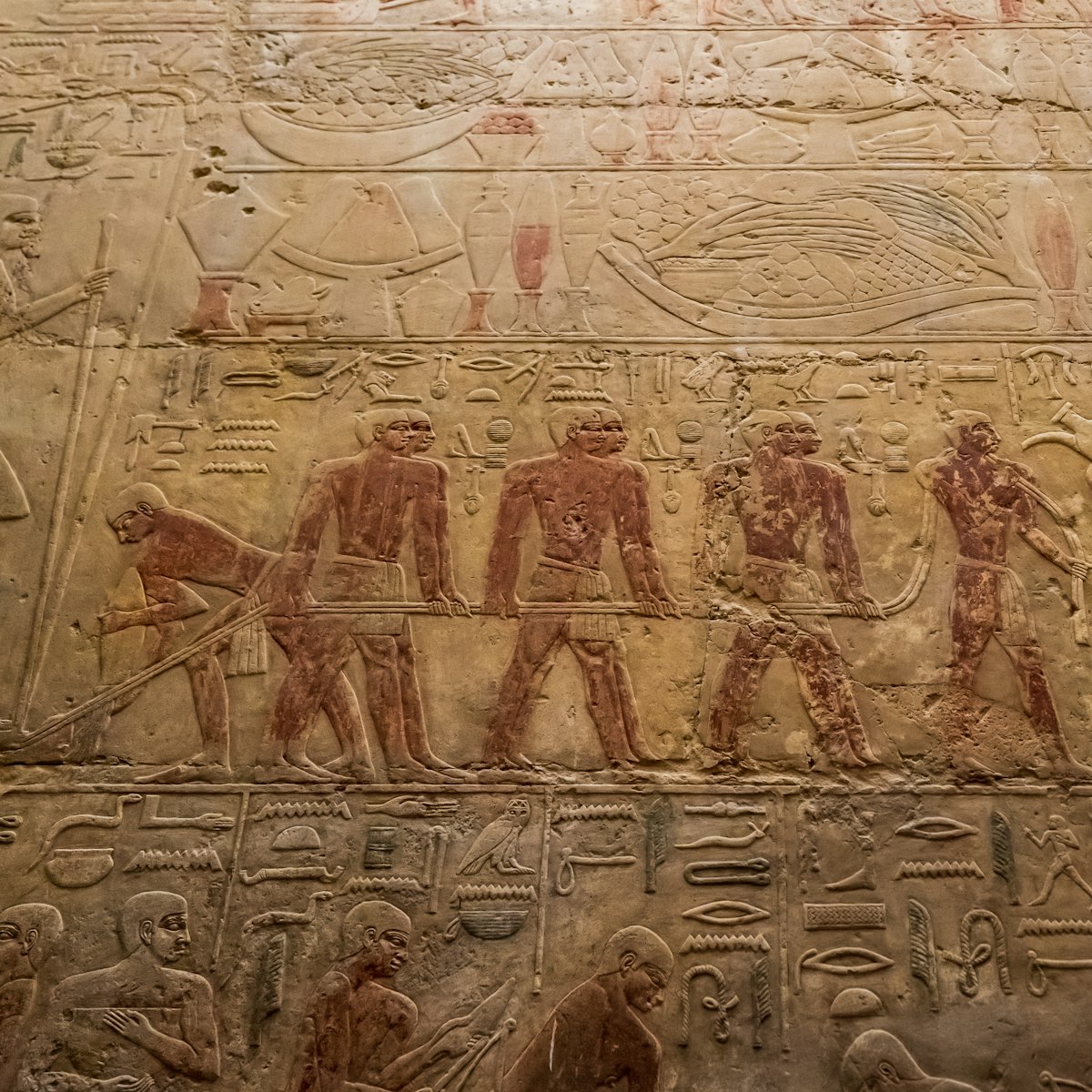
Mastaba of Ti
The Mastaba of Ti was discovered by Auguste Mariette in 1865. This grand and detailed private tomb is not only Old Kingdom art at its best but also one of…
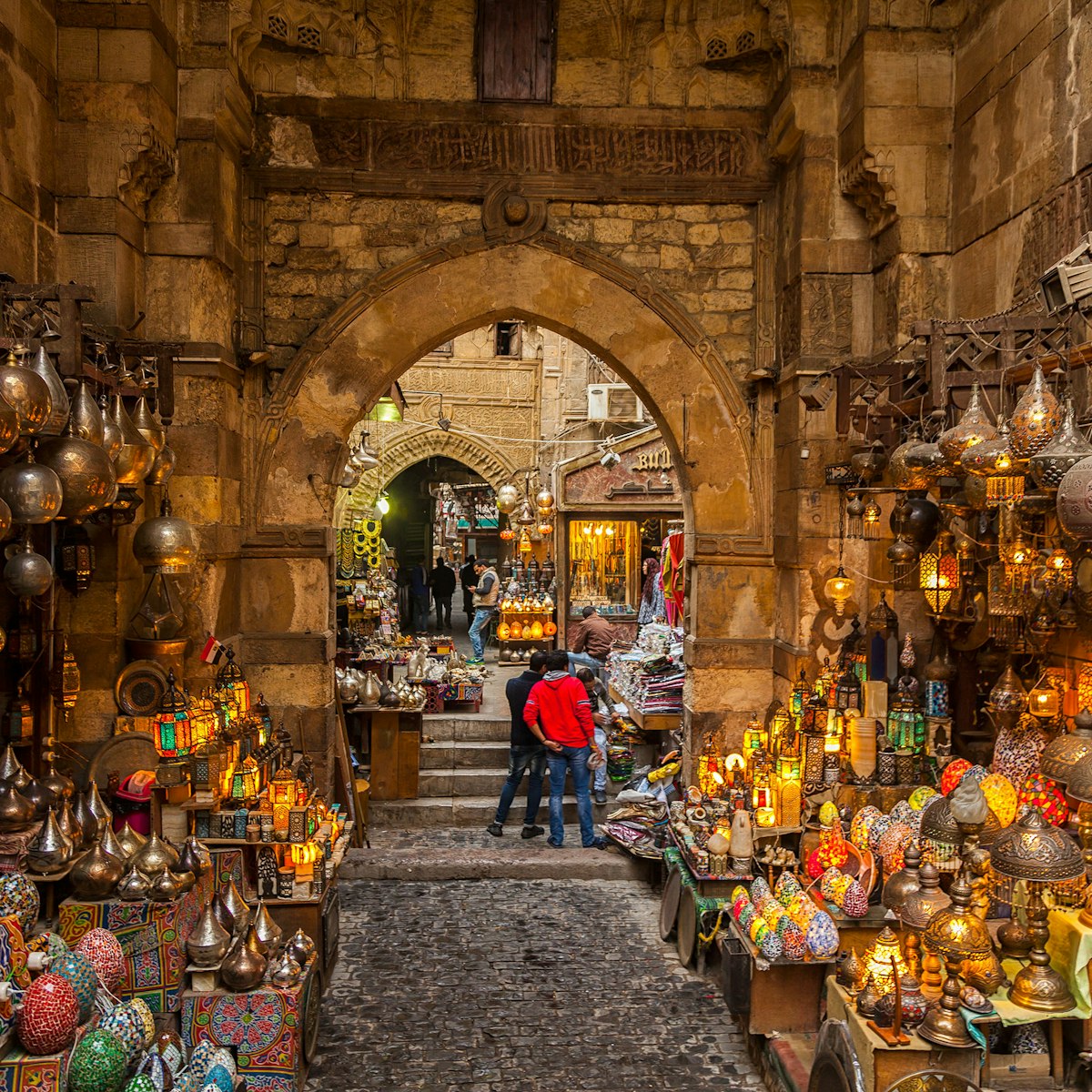
Khan Al Khalili
The skinny lanes of Khan Al Khalili are basically a medieval-style mall. This agglomeration of shops – many arranged around small courtyards – stocks…
Nearby Giza attractions
1 . Cheops Boat Museum
Immediately south of the Great Pyramid is this fascinating museum with exactly one object on display: one of Cheops' five solar barques (boats), buried…
2 . Great Pyramid of Khufu
The oldest pyramid in Giza and the largest in Egypt, Khufu’s Great Pyramid stood 146m high when it was completed around 2570 BC. After 46 windy centuries,…
3 . Western Cemetery
Private cemeteries are tucked into the hill alongside the causeways, as well as arrayed in neat rows around the Pyramids in a grid pattern. Only a few of…
4 . Tomb of Senegemib-Inti
At the north end of the Western Cemetery, the Tomb of Senegemib-Inti contains interesting inscriptions, including a rather vicious-looking hippopotamus,…
5 . Pyramid of Khafre
Khafre, the second pyramid, seems larger than that of Khafre's father, Khufu. At just 136m high, it’s not, but it stands on higher ground and its peak is…
6 . Tomb of Seshemnufer IV
The Tomb of Seshemnufer IV, just southeast of the Great Pyramid, is almost always open. There are carved deer on the entrance room walls and a burial…
7 . Solar Barque Pits
On the east side of the Great Pyramid of Khufu note the solar barque pits that housed the giant ritual boats buried with the pharaoh.
8 . Queens' Pyramids
Along the Great Pyramid of Khufu's east face, three small structures some 20m high resemble piles of rubble. These are the Queens’ Pyramids, the tombs of…

Pyramids of Giza
The Pyramids of Giza are without a doubt Egypt’s most iconic destination. The Pyramids are a remnant of Ancient Egypt, built almost five thousand years ago, and the oldest of the Seven Wonders of the World. These ancient structures are not only one of the world’s greatest wonders, but one of its biggest mysteries, too: historians still don’t fully understand why Giza’s three Pyramids and Sphinx have been so well preserved throughout the millennia. Inside these grand structures which were created by the Pharaohs of Ancient Egypt, you’ll marvel at the hieroglyphics that tell the story of life in the ancient world. See the Great Pyramid, the Pyramid of Khafre, the Pyramid of Menkaure, and the Great Sphinx at the Giza Pyramid Complex, which is located just minutes from modern-day Cairo . With daily tours departing from Cairo, Sinai, and other cities around Egypt, you can be sure to experience the wonder of the Pyramids on your Egypt tour. Read all about the Pyramids of Giza and Ancient Egypt below.
Pyramids Tours
Tours of the pyramids of giza.

Best of Ancient Cairo Tour

Best of Cairo 2 Day Tour from Sinai

Best of Cairo Tour from Sinai

4 Day Highlights of Cairo & Alexandria Tour

Cairo and Highlights of Egypt 4 Day Tour
Pyramids and ancient egypt travel guide.

Finding the Best Pyramids Tour in Egypt

How to Get to The Pyramids of Giza

The Best Travel Experiences in Egypt

7 Day Egypt Itinerary
Guide to egyptian culture and customs.

2 Days in Cairo

10 Best Things to Do in Cairo
- Destinations
15 Essential Tips for Visiting the Pyramids of Giza (Ace Your Adventure!)
This site uses affiliate links, meaning that if you make a purchase through our links, we may earn an affiliate commission.
Step into the realm of antiquity and prepare for an extraordinary adventure as we unveil 15 Travel-Tested Tips for Visiting the Pyramids of Giza .
These monumental structures have stood proudly for millennia, drawing travelers from around the world to witness their enigmatic allure.
In this guide, we will take you on a journey through the sands of time, revealing insider insights and invaluable advice to help you make the most of your visit to this iconic archaeological wonder. Our tips will ensure that your trip to the Pyramids of Giza is nothing short of extraordinary.
Join us as we uncover the secrets of these ancient giants and embark on a quest to create lasting memories amidst the sands of Egypt!
PRO TIP: You might also like: 10 Epic Things to See and Do at the Pyramids of Giza (Unlock Giza’s Gems!)
Learn More About Egypt:
14 Egypt Travel Tips to Save You Time, Money, and Keep You Safe
Perfect 7-Day Egypt Itinerary for First Vist (Cairo, Aswan, Luxor, Abu Simbel)
Perfect 2-Day Itinerary in Luxor (7 Things You Can’t Miss)
7 Best Tombs to Visit in the Valley of the Kings
- 1. 15 Essential Tips for Visiting the Pyramids of Giza (Ace Your Giza Agventure!)
- 1.1. Captivating Reasons to Explore the Great Pyramids of Giza
- 1.2. Discovering the Pyramids of Giza: Location and Travel Route to Get There
- 1.3. Essential Things to Know About the Pyramids of Giza Complex
- 1.4. Who Built the Pyramids
- 1.5. Why Were the Pyramids of Giza Built
- 1.6. How Were the Pyramids Built
- 1.7. What Are the Most Fascinating Facts About the Pyramids
- 1.8. What to See and Do at the Pyramids of Giza: 10 Epic Things You Can't Miss
- 1.9. Can You Climb on the Pyramids
- 1.10. What to Wear When Visiting the Pyramids of Giza
- 1.11. How Much Does it Cost to Visit the Pyramids
- 1.12. What Are the Opening Hours of the Pyramids of Giza
- 1.13. How Long Does it Take to Visit the Pyramids of Giza Complex
- 1.14. What Is the Best Time to Visit the Pyramids
- 1.15. Where to Stay When Visiting the Pyramids of Giza
- 2. Intrepid Scout's Most important Tips for Visiting the Pyramids of Giza
15 Essential Tips for Visiting the Pyramids of Giza (Ace Your Giza Agventure!)
Captivating reasons to explore the great pyramids of giza.
- Ancient Wonder of the World: The Pyramids of Giza hold a special place in history as one of the last remaining wonders from the ancient world . Visiting them allows you to connect with the past and witness an achievement that has fascinated humanity for centuries.
- Architectural Marvels: These pyramids are architectural marvels, showcasing the advanced engineering skills of the ancient Egyptians. Their precise construction techniques, alignment with the cardinal points, and massive scale continue to intrigue architects and historians.
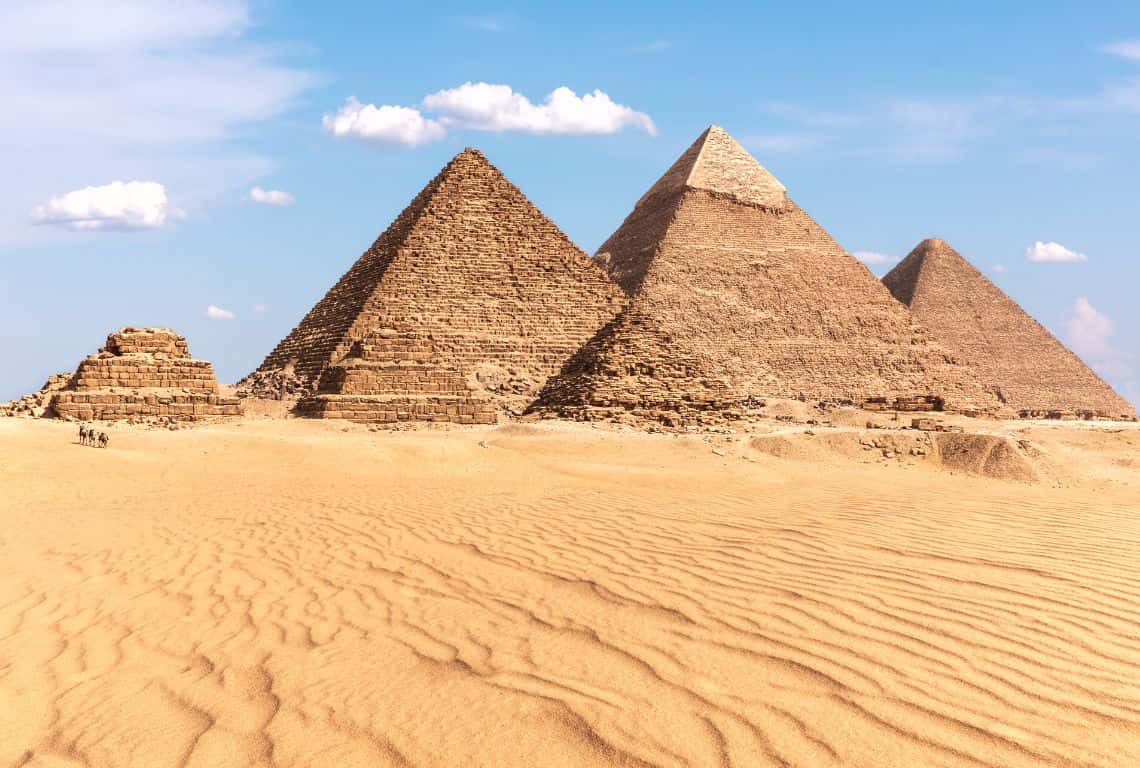
Tips for Visiting the Pyramids of Giza / Captivating Reasons to Explore the Great Pyramids of Giza
- Historical Significance: Beyond their awe-inspiring presence, the pyramids serve as tombs for pharaohs, offering a glimpse into the profound cultural and religious beliefs of ancient Egypt. Exploring their chambers and hieroglyphics provides a window into this ancient civilization.
- Sphinx Encounter: Adjacent to the pyramids stands the Great Sphinx of Giza , a colossal statue with the body of a lion and the head of a pharaoh. It guards the pyramids and adds an air of mystery and symbolism to the site.
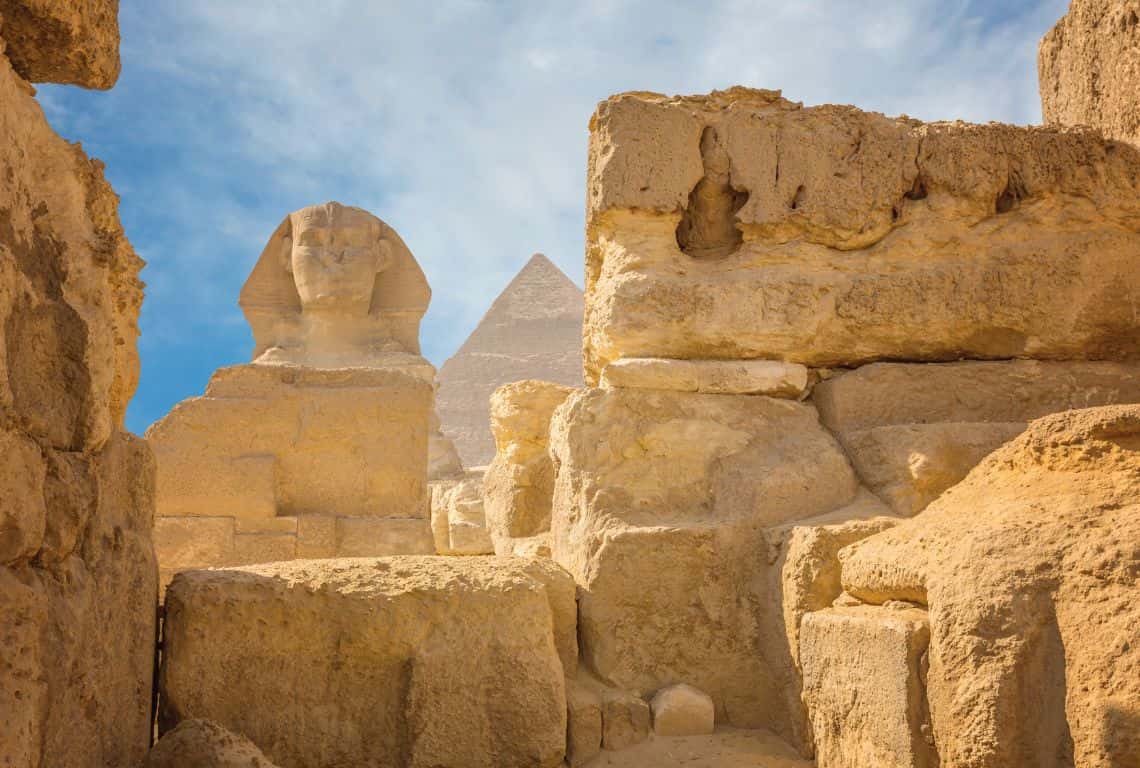
- Astrological Alignment: The pyramids’ alignment with celestial bodies, particularly with the stars, has fascinated astronomers and scholars for centuries. You can learn about these celestial connections and the significance they held for the ancient Egyptians.
- Photo Opportunities: The pyramids offer an array of breathtaking photo opportunities. Whether capturing their majesty from a distance or exploring their intricate details up close, you will create lasting memories through photography.
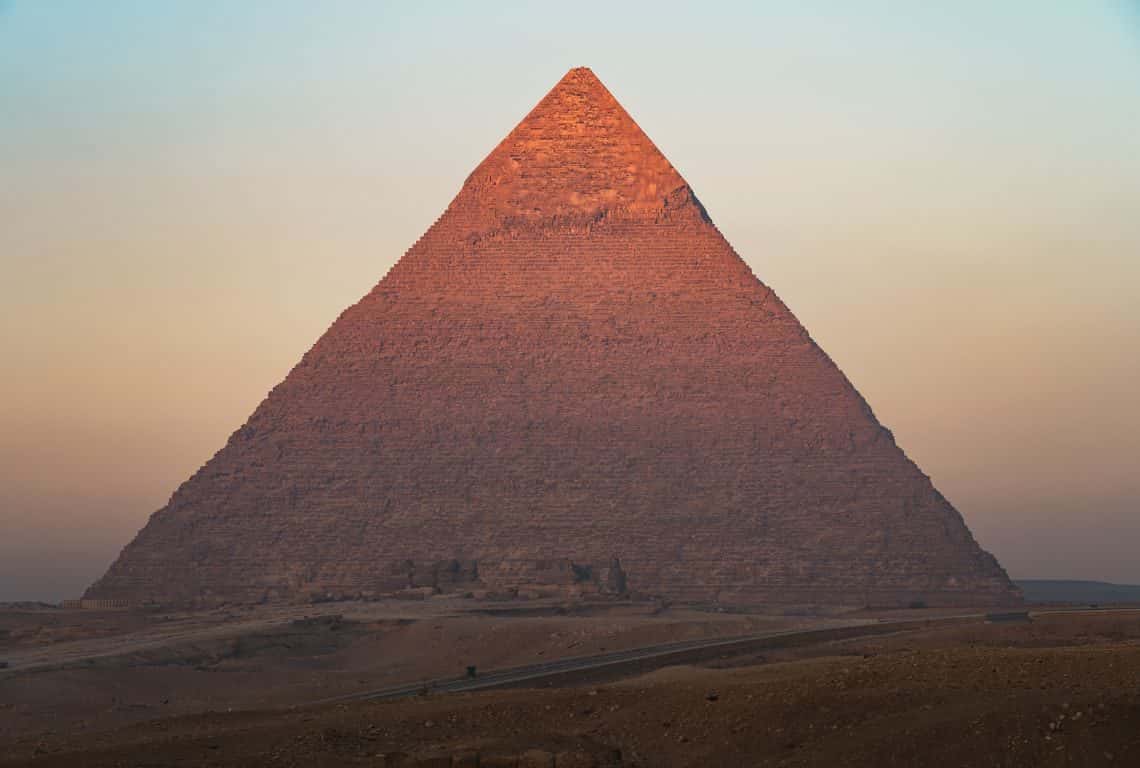
Tips for Visiting the Pyramids of Giza / Pyramids of Giza at Sunrise
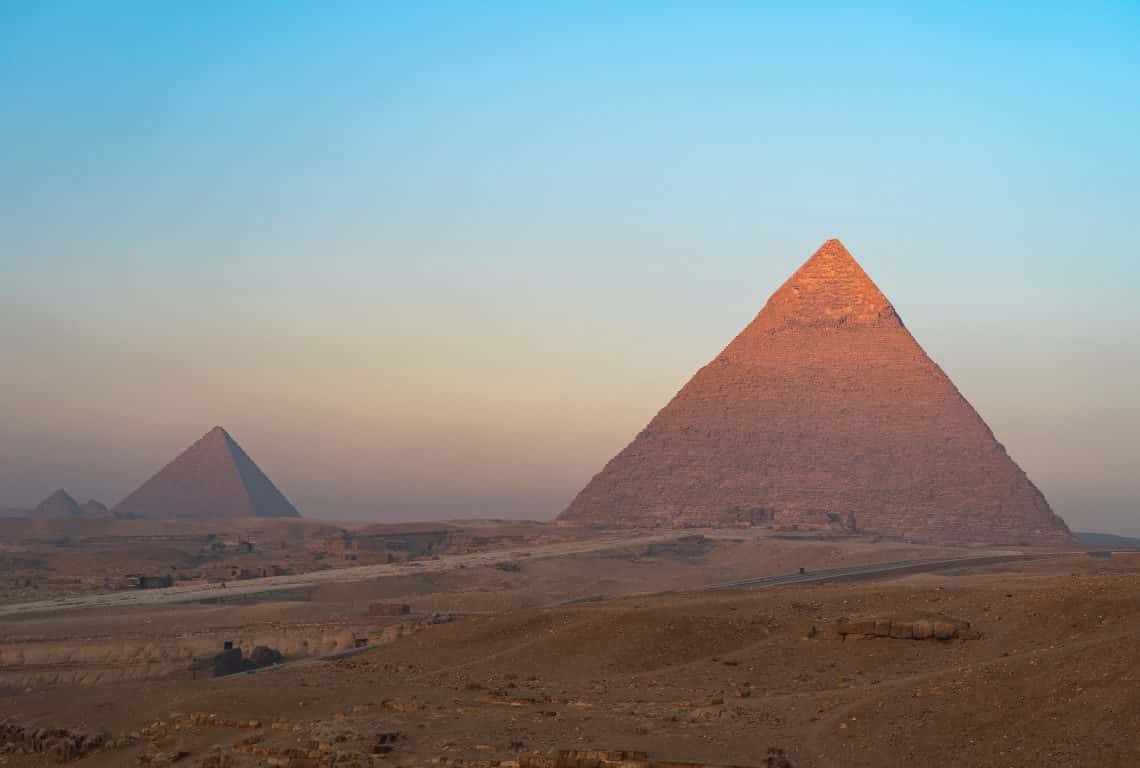
Tips for Visiting the Pyramids of Giza / Pyramids of Giza at Sunrise
- Mysterious Legends: The pyramids are surrounded by intriguing legends and mysteries, from the search for hidden chambers to theories about their construction methods.
- Sunset and Sunrise Spectacle: Witnessing the pyramids during sunrise or sunset is a magical experience . The warm, golden light transforms these ancient structures into ethereal wonders, creating a truly memorable sight.
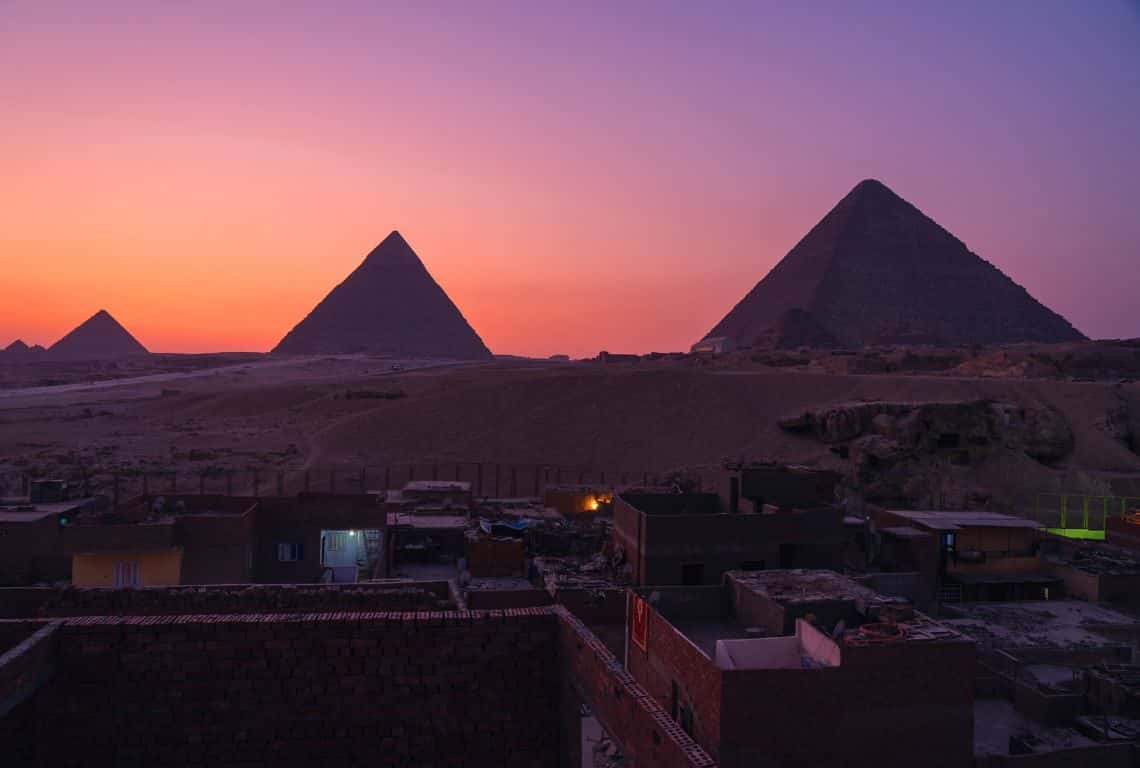
Tips for Visiting the Pyramids of Giza / Pyramids of Giza at Sunset
- Timeless Symbolism: Reflect on the timeless symbolism of the pyramids, which represent human ambition, achievement, and the pursuit of immortality. These enduring structures continue to inspire and captivate people worldwide.
- Bucket List Destination: For many, a visit to the Pyramids of Giza is a lifelong dream. Checking it off your bucket list provides a sense of accomplishment and a deep connection with history.
- Global Heritage: Recognize the global significance of the pyramids as a UNESCO World Heritage Site. They stand as a testament to human achievement and serve as a shared cultural heritage for people of all backgrounds.
Discovering the Pyramids of Giza: Location and Travel Route to Get There
The Great Pyramids of Giza sit on the Giza Plateau , which is located on the edges of the Western Desert. Specifically, they are positioned approximately 9 km (5 mi) west of the Nile River in the city of Giza and about 13 km (8 mi) southwest of Cairo.
The best way to get to the Pyramids of Giza is by having a driver and a guide . This option gives you total flexibility. You can decide how much time you need to see everything at the Pyramids of Giza. Plus, having a knowledgeable guide by your side is priceless!
You can ask your hotel for a bus tour that stops at all major attractions in Cairo. It is probably one of the least expensive options. But, it does not give you much flexibility.
Another option is to just book a taxi and head to the Pyramids of Giza. You will always be able to hire a guide right at the entrance.
Image Source: Map data ©2020 ORION-ME
Essential Things to Know About the Pyramids of Giza Complex
The Great Pyramids of Giza are part of the Giza Pyramid Complex , which is also called the Giza Necropolis . The Giza Pyramid Complex consists of:
1. The Great Pyramid of Giza, also known as the Pyramid of Khufu or the Pyramid of Cheops
2. Pyramid of Khafre
3. Pyramid of Menkaure
4. Great Sphinx of Giza
5. Queens Pyramids
6. Solar Boat Museum
In addition, there are causeways, valley pyramids, several cemeteries, and the remains of a workers’ village
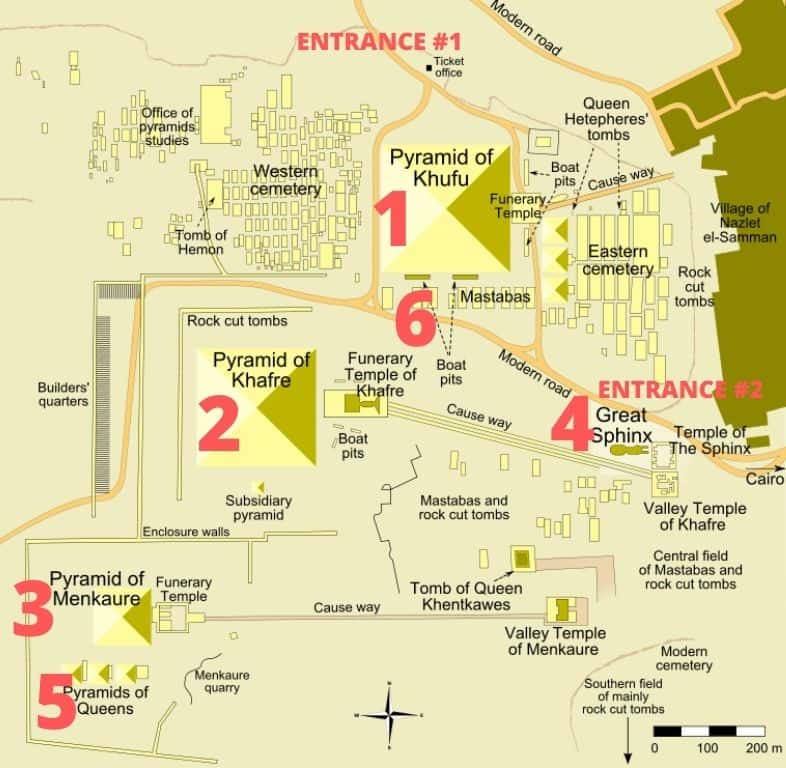
Map of the Pyramids of Giza Complex / Tips for Visiting the Pyramids of Giza / Image Source: Wikipedia
Who Built the Pyramids
The pyramids were constructed during the period of the Old Kingdom , also known as the “Age of the Pyramids” or the “Age of Pyramid Builders (c. 2686-2181 BC). Specifically, they were built during the reign of the Fourth Dynasty Pharaohs.
The Pharaohs: Khufu, Khafre , and Menkaure erected the Pyramids of Giza.
Interestingly, the pyramid building project was started with the Step Pyramid in Saqqara during the reign of the Third Dynasty Pharaohs. Specifically, the Step Pyramid was built for the burial of Pharoah Djoser.
In addition, King Sneferu , the founding pharaoh of the Fourth Dynasty of Egypt, was the first one who attempted to build smooth-sided pyramids at Dahshur.
A Quick Read:
Were the Pyramids of Giza built by slaves?
The ancient Greeks believed the pyramids were built with a massive slave labor force.
However, Miroslav Verner , in his book The Pyramids: The Mystery, Culture, and Science of Egypt’s Great Monuments , argues that the pyramids were not only built by humans—instead of aliens or gods—but they were constructed by tradesmen and artisans whose skills were in high demand and who were paid wages and organized under a complex bureaucracy. Source: Open Culture
In addition, Egyptologists Mark Lehner and Zahi Hawass claim that 20,000-30,000 skilled laborers, including stone masons, engineers, architects, surveyors, builders, and other craftsmen, were conscripted to construct Khufu’s temple, while a more significant force of workers was summoned during the summer months when the Nile flooded the surrounding valley and integrated with the permanent labor force.
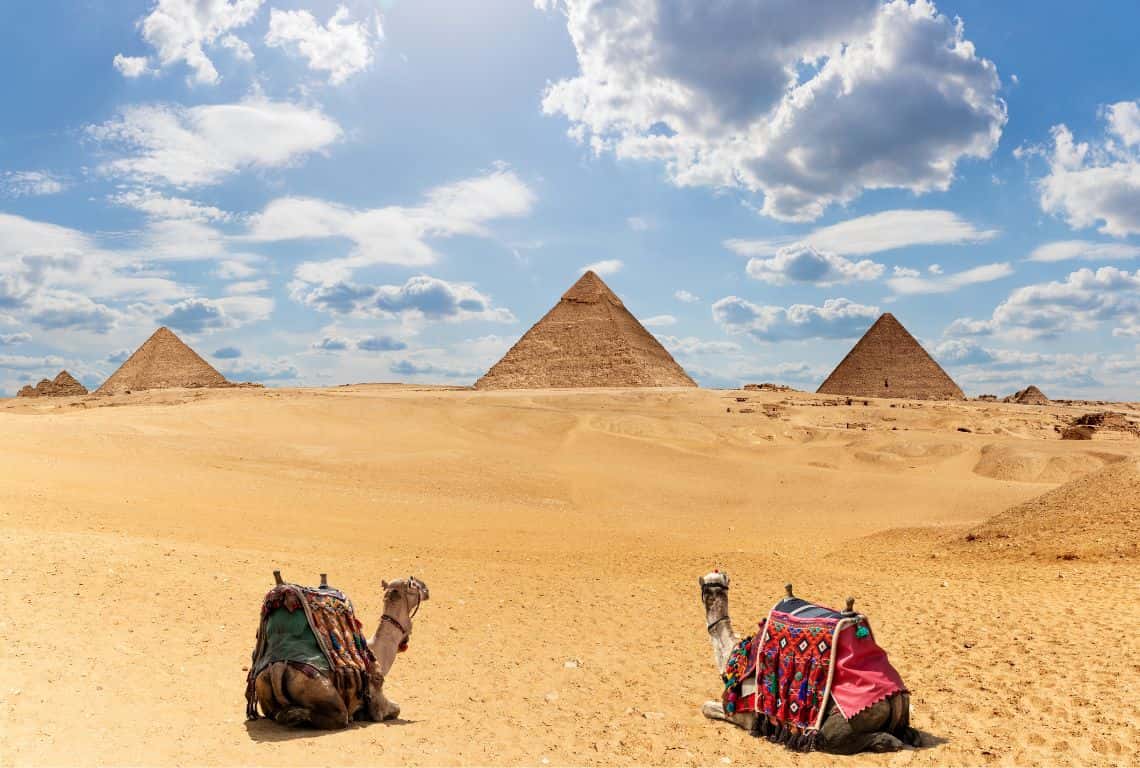
Who Built the Pyramids of Giza / Tips for Visiting the Pyramids of Giza
Why Were the Pyramids of Giza Built
Pharaohs held a special position in Egyptian society. It was a status of a being that combined both human and divine characteristics . As a result, this godlike status was held even after death
First of all, the pharaoh’s body was mummified and then buried in elaborate tombs, like pyramids.
Mummification was a necessary process since the Egyptians believed that the mummified body served as a home of the three spirits : ka, ba, and akh.
Ka was essentially a person’s double. It was the life force and at death it was separated from the body. However, it was important that after the pharaoh’s death ka had a home as well as be properly nourished and cared for. It was important that the deceased body would resemble the living body as much as possible so that ka, which was free to roam around and then return, could recognize his body.
That is the reason why each tomb would contain absolutely anything that they might need and what would help them in their afterlife.
Interestingly, if the body was destroyed, or the name of the pharaoh was erased, like in the case of a sad story of Pharaoh Hatshepsut , then ka would be lost.
How Were the Pyramids Built
There are many theories on how the Pyramids of Giza were built.
- Some reports claim that the pyramids were built by either dragging , rolling , and then lifting the huge blocks into place.
- Some theories suggest that a system of ramps had to have been constructed for maneuvering the huge blocks.
- Finally, there are theories that suggest that wooden and bronze levers were used to intricately position the stones into their place. These are all speculations.
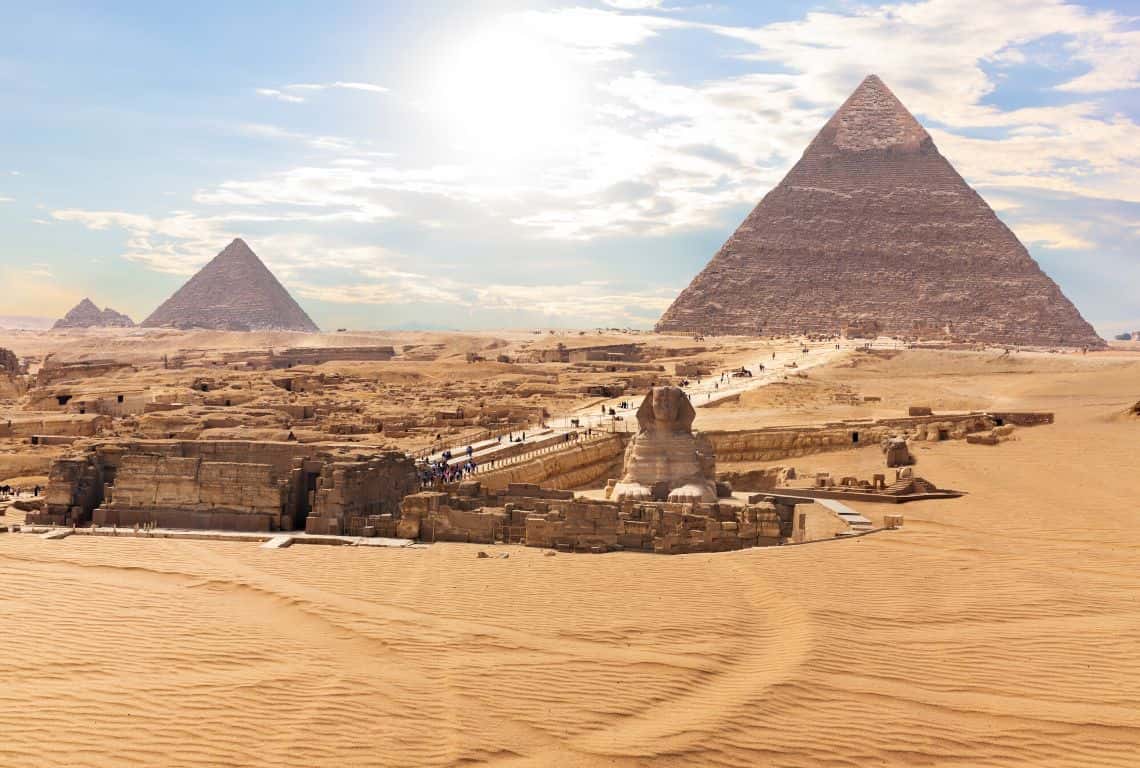
How Were the Pyramids of Giza Built / Tips for Visiting the Pyramids of Giza
What Are the Most Fascinating Facts About the Pyramids
- I think that the most fascinating fact that I came across was made by Robert Bauval in his book Orion Correlation Theory:
Bauval claimed that the three Pyramids of Giza are aligned exactly like the three stars of the Orion Belt: Alnilam (Epsilon Orionis), Alnitak (Zeta Orionis), and Mintaka (Delta Orionis). He reported that the layout of the pyramids and their relative sizes were a deliberate design plan.
It is a controversial theory and has been criticized by Ed Krupp of Griffith Observatory in Los Angeles, and Anthony Fairall , an astronomy professor at the University of Cape Town, South Africa.
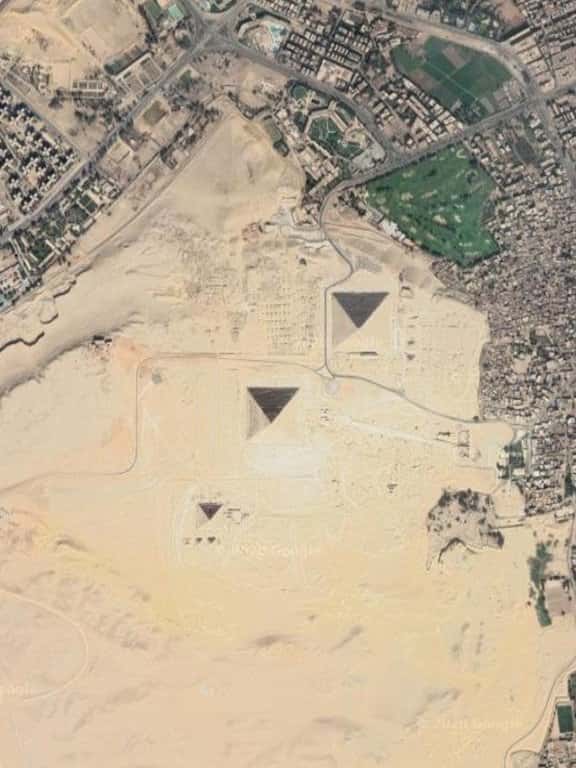
Fascinating theories about the Pyramids of Giza / Tips for Visiting the Pyramids of Giza

- Another interesting observation that I came across was the fact that the Great Pyramid at Giza’s latitude , 29.9792458°N, perfectly matches up to the speed of light, which is 299,792,458 meters per second. It is a fascinating fact!
Some claim that the ancient Egyptians had some greater knowledge of the speed of light, space travel, and, potentially, advanced alien spaceships.
- The mystery that still puzzles the scientists is whether or not mortar was used to attach the stones to each other.
How is it possible that some of the blocks are so perfectly matched that not even human hair can be inserted between them? Why, despite the existence of millions of tons of stone, carved presumably with copper chisels, has not one copper chisel ever been found on the Giza Plateau?
- Another interesting theory that I read about suggested that the Pyramids of Giza were once covered in a white casing made of highly polished limestone blocks which reflected the sun’s rays.
The pyramid’s angled sides symbolized the rays of the sun and were designed to help the pharaoh’s soul ascend to heaven and join the sun god Ra. The theory goes on and claim that the casings slowly disappeared after becoming loosened by earthquakes and crumbling to rubble or being cut loose and taken to build other structures.
- Another fascinating discovery that you should be aware of is that although at first sight, the Great Pyramid of Giza appears to have four sides, in reality, it has eight sides .
Each of the four sides of the pyramids is evenly split from base to tip. The discovery goes back to 1940 when a pilot named Robert Marsland Groves while flying over it noticed the indentations.
These are all interesting speculations and it is fun to read about them. It just shows how little we know about the ancient Egyptians and how much more we still need to learn about them.
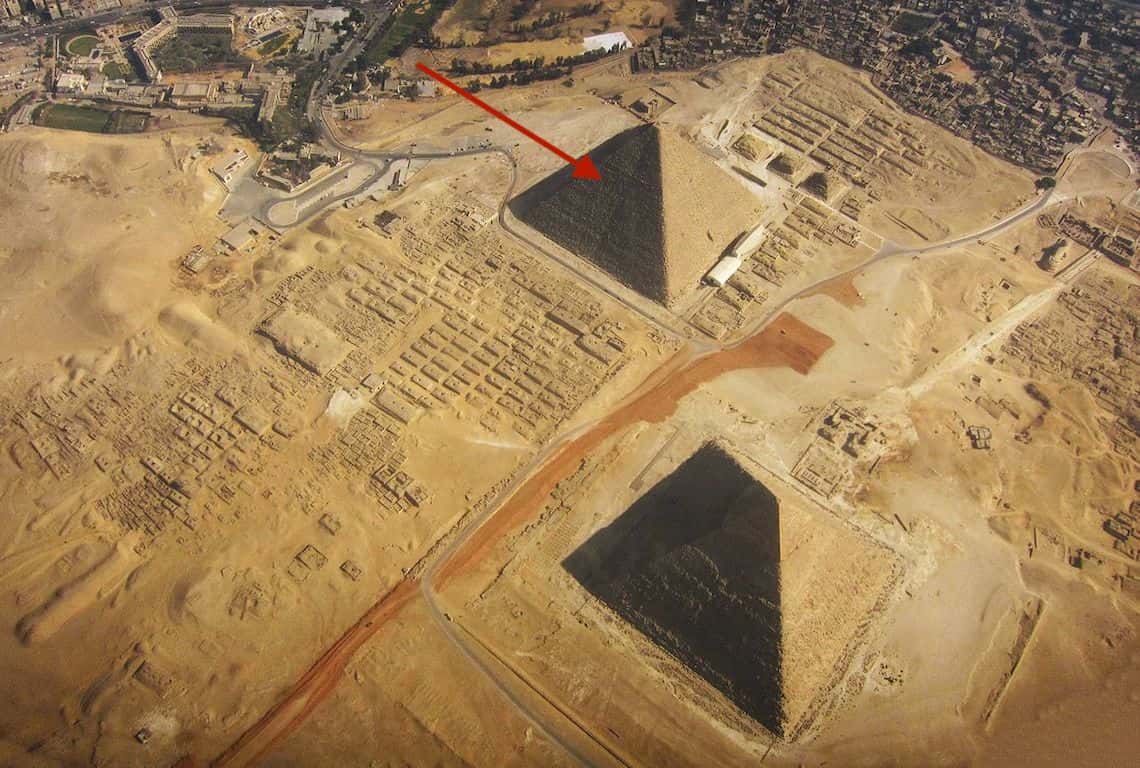
Fascinating facts about the Pyramids of Giza / Tips for Visiting the Pyramids of Giza / Image Source: Wikimedia Commons
What to See and Do at the Pyramids of Giza: 10 Epic Things You Can't Miss
How do you decide what to see and do at the Great Pyramids of Giza?
Make sure to read my post 10 Epic Things to See and Do at the Pyramids of Giza to find out all the details. This bucket list contains 10 of the best experiences you can have at the Giza Pyramid Complex. It will help you to get a sense of this incredible place and all the treasures it holds.
Following is a short list to get you started:
- See the Great Pyramid of Giza – The Great Pyramid of Giza, also known as the Pyramid of Khufu or the Pyramid of Cheops, is the oldest and the largest of the three pyramids in the Giza Pyramid Complex.
- Go Inside the Great Pyramid of Giza – for an additional fee, on top of the entrance ticket to the Great Pyramid Complex, you can go inside either the Great Pyramid of Giza, the Pyramid of Khafre, and/or the Pyramid of Menkaure.
- See the Pyramid of Khafre – the Pyramid of Khafre is the second tallest and second largest of the Pyramids of Giza. However, if you look at it, it appears to be taller than the Great Pyramid.
- See the Pyramid of Menkaure – The Pyramid of Menkaure is the smallest of the three main Pyramids of Giza. Did you know that at the end of the twelfth century al-Malek al-Aziz Othman ben Yusuf , Saladin ‘s son and heir, attempted to demolish the pyramids , starting with that of Menkaure? Despite their efforts, workmen were only able to damage the pyramid to the extent of leaving a large vertical gash at its northern face.
- Be Amazed by the Great Sphinx of Giza – I have to honestly say that when I saw the Great Sphinx of Giza, it literally took my breath away! Did you know that a sphinx is a mythical creature with the head of a human, a cat, or a sheep, with the body of a lion with the wings of an eagle?
- Go on a Camel Ride – hands down, go on a camel ride. It is part of the experience! Negotiate the prices before you get on the camel. I suggest that you ask to ride the camel to the Panoramic Spot and have your pictures taken there. Read all about it here.
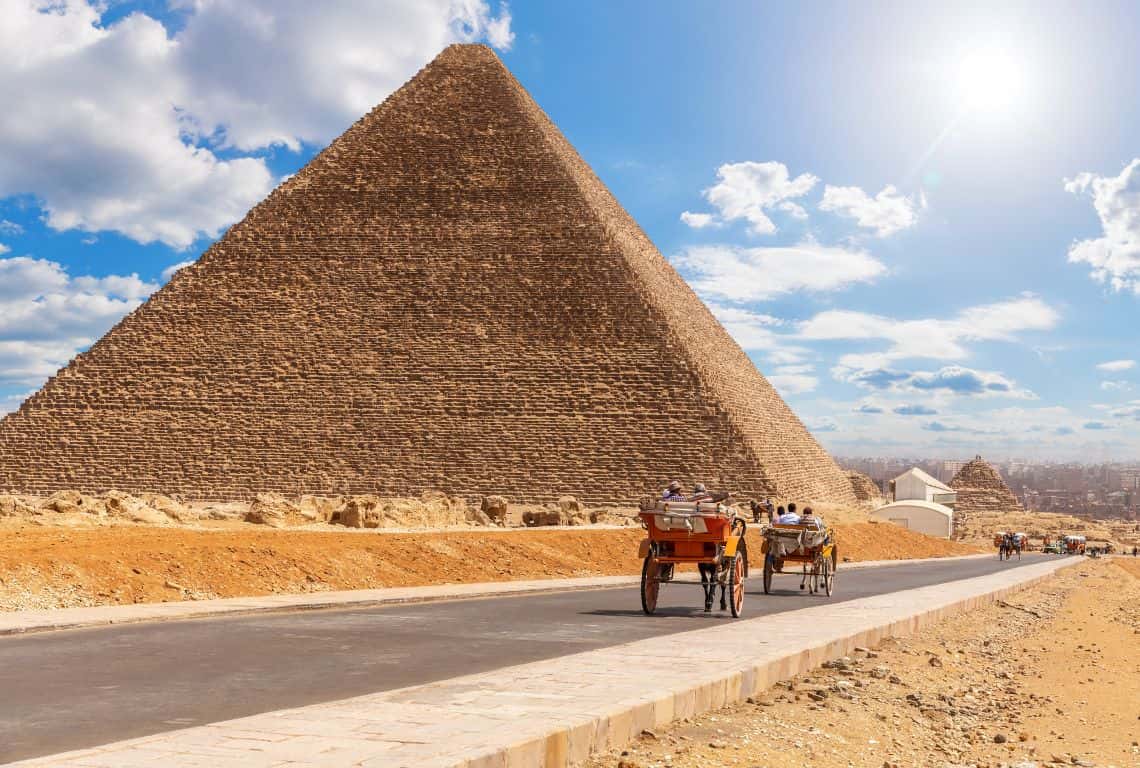
What to See at the Pyramids of Giza / Tips for Visiting the Pyramids of Giza
Can You Climb on the Pyramids
You cannot climb the pyramids. However, I saw tourists tipping the guards and climbing on the pyramids.
Please do not do it. Let’s make as little of an impact as possible and save the pyramids for future generations.
What to Wear When Visiting the Pyramids of Giza
- There is no set dress code or specific restrictions on what you can or cannot wear while visiting the Pyramids of Giza. The bottom line, is you can wear whatever you want. However, keep in mind that Egypt is a conservative country. So, with that being the case, cover up your body and be respectful . Skip tank tops or tube tops and short shorts.
- In addition, since you will be outside most of the time, I would suggest that you wear a hat and a sun shirt to protect yourself.
- Needless to say, wear comfortable and sturdy shoes . You will be doing a lot of walking.
- Finally, keep in mind that you will be in an open area that gets very windy and it is very dusty! It is a good idea to bring a scarf and cover up your nose and mouth. Each year, around April and May, the Khamsin winds loaded with sand hit Egypt. The winds take a toll on the Great Pyramids of Giza, but especially weathered is the body of the Great Sphinx of Giza which is carved out of a softer layer of limestone.
How Much Does it Cost to Visit the Pyramids
- The entrance ticket to the Giza Plateau costs 200 EGP per adult and 100 EGP for a student (with a valid ID).
- The entrance ticket to go inside the Great Pyramid of Giza costs 400 EGP, the Pyramid of Khafre costs 100 EGP, and the Pyramid of Menkaure is also 100 EGP.
- The entrance ticket to the Solar Boat Museum costs 100 EGP.
- Consider buying the combo ticket , which includes the entrance to the Giza Plateau, the entrance to the Great Pyramid of Giza, and the entrance to the Solar Boat Museum. The combo ticket costs 600 EGP.
- Included in your ticket is a free visit to the middle pyramid of the three satellite pyramids of the Queen of Cheops.
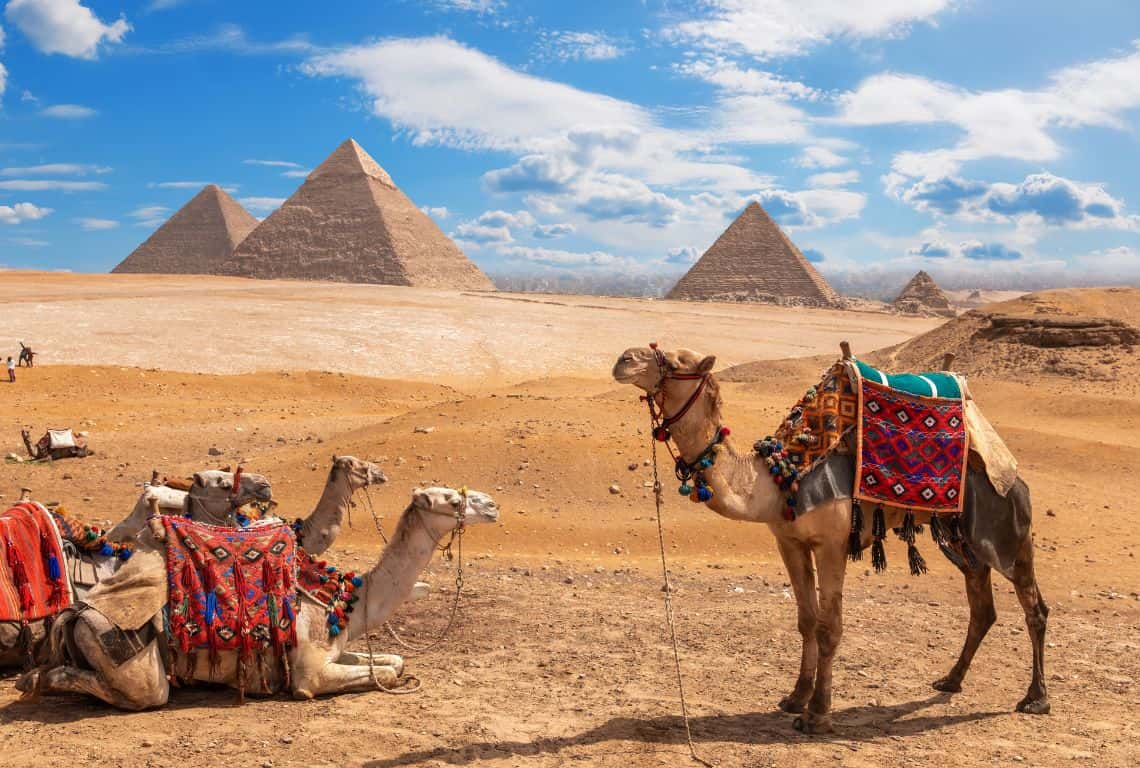
How Much Does It Cost to Visit the Pyramids of Giza / Tips for Visiting the Pyramids of Giza
What Are the Opening Hours of the Pyramids of Giza
The Giza Plateau Archaeological Site opens every day between 8 am and 5 pm from October to March, and from 7 am to 7 pm every day between April and September.
My recommendation is to get there as early as possible . The tour buses start arriving between 9:30 am and 10 am and needless to say, it gets very crowded. You will get lucky if you manage to take a picture without any tourists in them.
How Long Does it Take to Visit the Pyramids of Giza Complex
My recommendation is to reserve a minimum of 3-4 hours . It is a bare minimum.
First of all, it is a huge site. It takes time to walk from pyramid to pyramid. Next, if you decide to go inside the Great Pyramid of Giza, you will need at least an hour to do it.
Moreover, if you are going to visit the Solar Boat Museum, then you need at least an hour to see the boat. Finally, if you go on a camel ride, then add another hour. Plus, you need time to take a ton of pictures!
So, do not rush it. Take your time. Find a quiet spot and soak it all in! Who knows when you are going to be back?
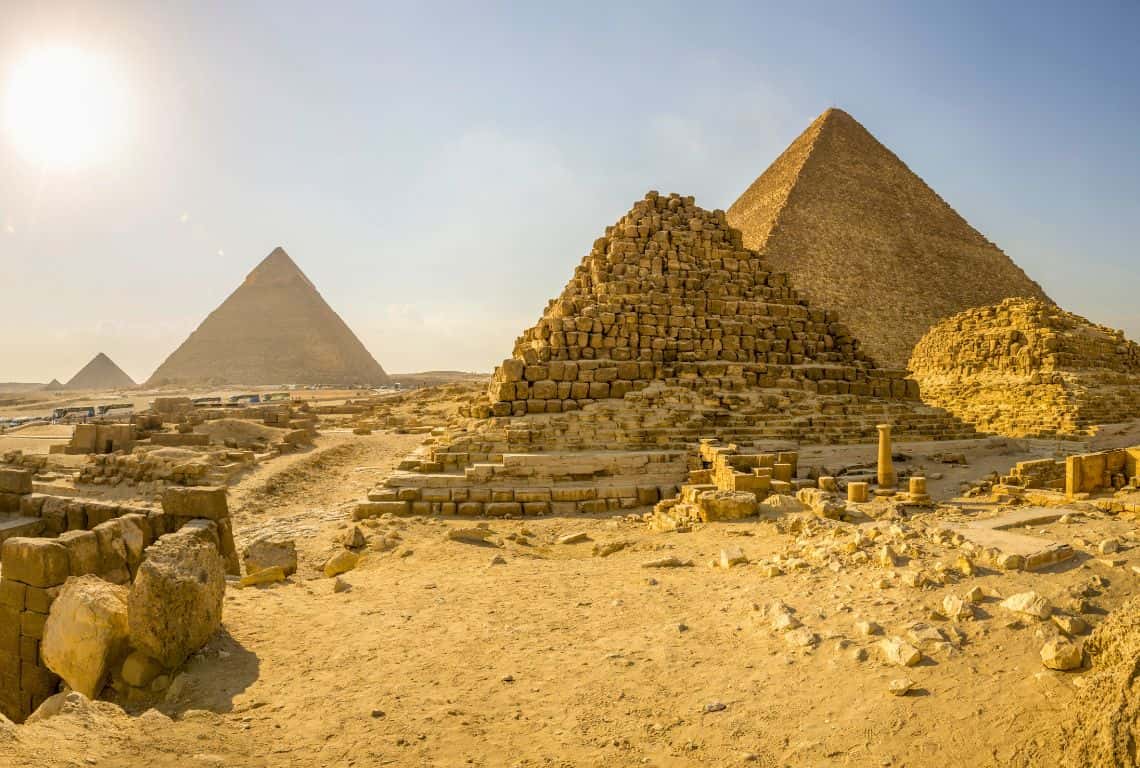
How Long Does It Take to Visit the Pyramids of Giza / Tips for Visiting the Pyramids of Giza
What Is the Best Time to Visit the Pyramids
Get to the Giza Pyramid Complex as early as possible . First of all, you will avoid the crowds that usually swarm the place by about 9:30 am.
Second, if you are visiting during the summer months , then getting to Giza early will save you from the scorching heat.
If you are visiting during the winter months then make sure to go in the afternoon. There is usually a pretty dense fog that has a tendency to linger on in the morning during winter months and obscures the views.
Where to Stay When Visiting the Pyramids of Giza
I stayed at Marriot Mena House in Giza and it was fabulous!
Unfortunately, at the time of my stay, all the rooms with views of the pyramids were going through renovation. I was hoping that each morning I would be waking up to the sight of the Great Pyramid of Giza, but no such luck. However, the minute I stepped out of my room, I was greeted with the most amazing views of the pyramids.
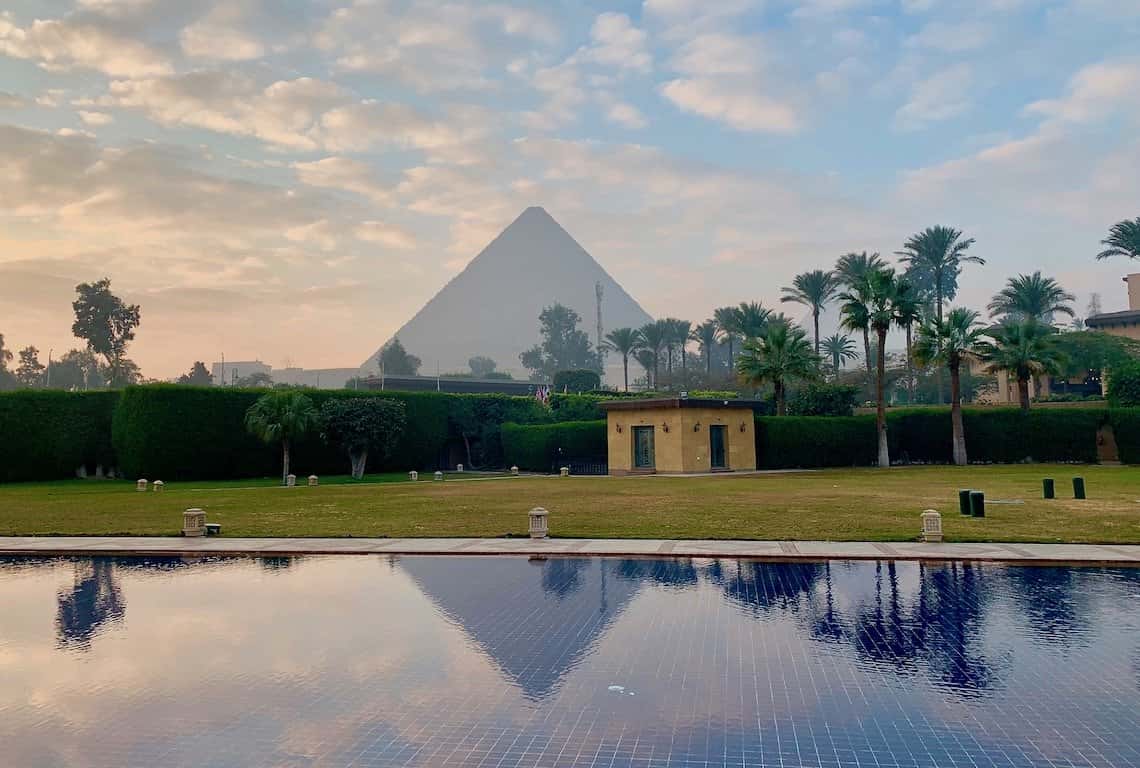
Where to Stay When Visiting the Pyramids of Giza / Tips for Visiting the Pyramids of Giza
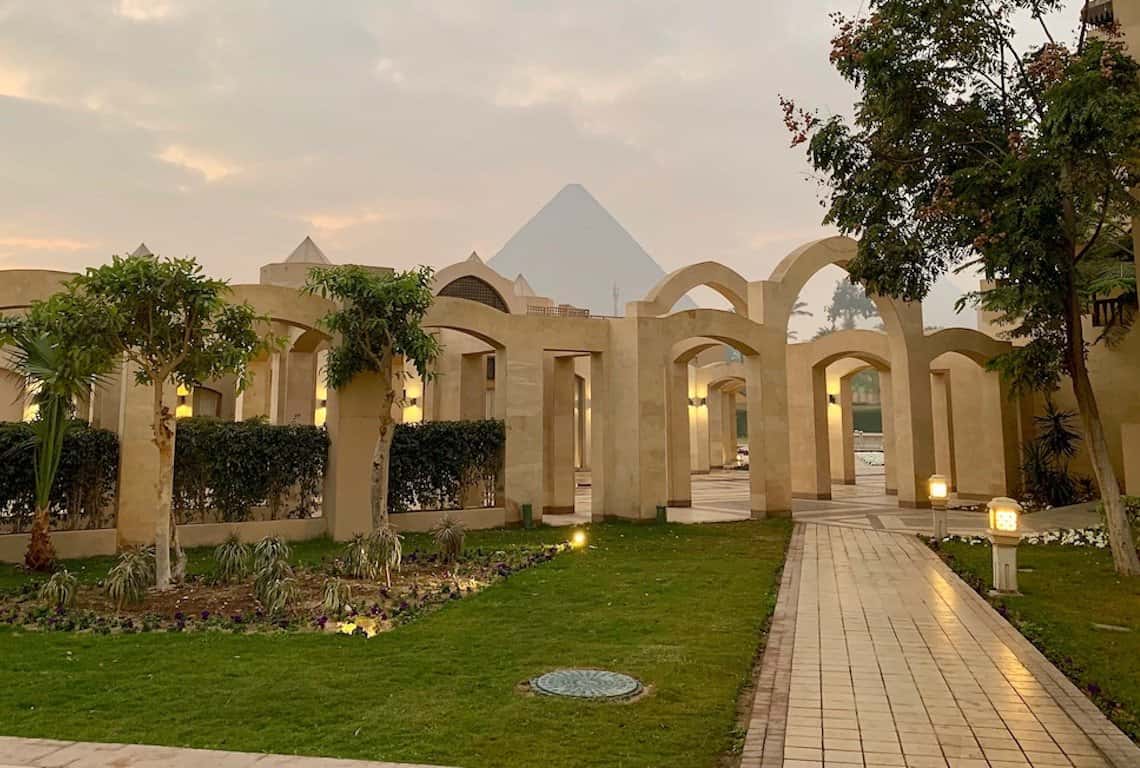
The buffet breakfast, which I enjoyed every morning, offered endless possibilities and the food presentation was top-notch. By the way, after you have your breakfast, get your cup of coffee and go to the outdoor patio area and enjoy your coffee there while admiring the views.
I honestly have to say that the rooms are fair size, clean, and nicely decorated. Above all, the customer service is outstanding! They will absolutely go out of their way to make your stay perfect.

Intrepid Scout's Most important Tips for Visiting the Pyramids of Giza
- If you are visiting the Pyramids of Giza during the summer months, get to the Pyramid Complex as early as possible or late in the afternoon to escape the crowds. The tour buses arrive at about 9:30 a.m. and leave at about 3 p.m. If you are visiting during the winter months, make sure to schedule your tour in the afternoon. There is usually a dense fog or haze in the morning which obscures the view.
- Use entrance # 1 as marked on the map. Entrance # 2 is very narrow and always jam-packed with tourists and locals.
- Do not skip the Solar Boat Museum . The reconstructed boat is a sight to see!
- Go on a camel ride . It is part of the experience.
- Take the time and walk to the Panoramic Spot . You will be able to take amazing pictures.
Find out how to get to the Panoramic Spot at the Pyramids of Giza here .
Traveling in Egypt can be challenging , even for the most seasoned nomad. There’s so much to know about Egypt and consider before planning a trip, however, make sure to read 14 Egypt travel tips , to help you make the most of your time, avoid possible challenges, and ensure you have a safe and enjoyable stay in Egypt.
You Might Also Like:
How to Visit and What to See at KHAN EL-KHALILI BAZAAR in Cairo
Perfect 7-Day Egypt Itinerary for First Visit (Cairo, Aswan, Luxor, Abu Simbel)
What to See at the TEMPLE of HORUS at EDFU (5 Things You Can’t Miss)
What to See at the TEMPLE of KOM OMBO, Egypt (9 Things You Can’t Miss)
How to Visit Abu Simbel: Everything You Need to Know to Plan Your Visit
How to Visit and What to See at the TEMPLE of PHILAE in Aswan
Best Day Trip from Cairo – Dahshur, Memphis, and Saqqara (Maps+Photos)
19 Must-See Things at Egyptian Museum in Cairo (+Practical Tips)
What to See at the Temple of Horus at Edfu
What to See in Memphis, Egypt – Guide to Visiting Memphis
Read All the Posts About Egypt in:
Egypt Travel Guide
Did You Find This Useful?
Why not save tips for visiting the pyramids of giza to your pinterest board.
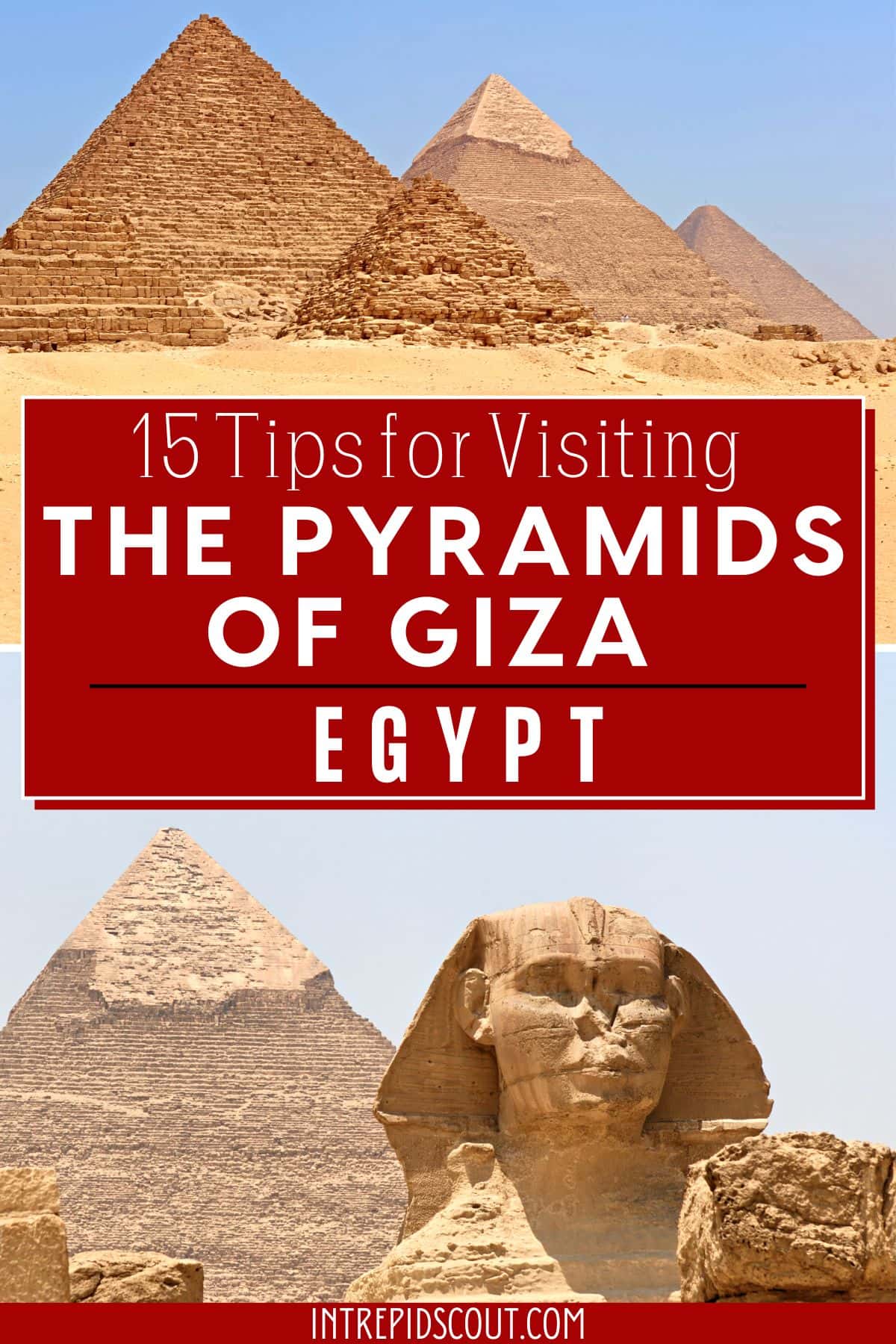
Now, It Is Your Turn, I Would Like to Hear Back from You!
Are you planning a visit to the Pyramids of Giza?
Please let me know! Drop me a quick comment right below!
Click on any of the images below to get inspired and to help you with the planning process for your trip to Egypt!
- alert('URL copied to clipboard.')).catch(err => console.error('Unable to copy to clipboard.', err))">
Share via Email
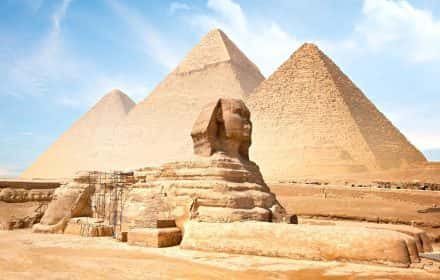
10 Epic Things to See and Do at the Pyramids of Giza (Unlock Giza's Gems!)
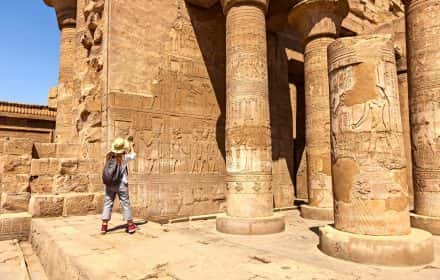
14 EGYPT TIPS for FIRST TIMERS (How to Save Time, Money, and Be Safe)
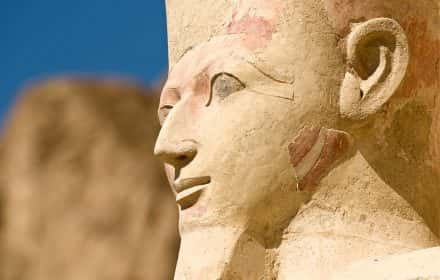
Perfect 7-Day Egypt Itinerary (Cairo, Memphis, Saqqara, Giza, Aswan, Luxor, Abu Simbel)
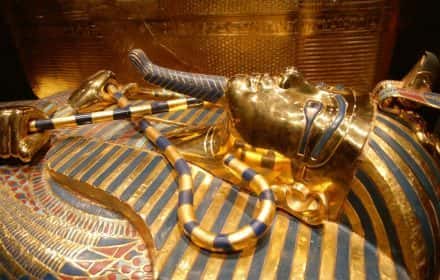
Amazing 19 Must-See Things at EGYPTIAN MUSEUM, Cairo (+BEST Practical Tips)
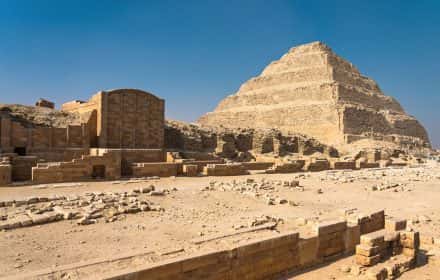
How to Visit and What to See in Saqqara, Egypt (Guide to Visiting Saqqara)
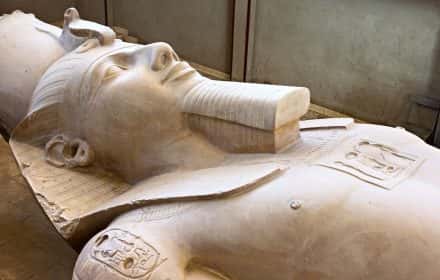
How to Visit and What to See in MEMPHIS, Egypt (Guide to Visiting Memphis)
@intrepid.scout
Leave an answer Cancel reply
Your email address will not be published. Required fields are marked *
The company processes your data to facilitate the publication and management of comments. You can exercise your rights of access, rectification, deletion and objection, among others, according to our Privacy policy .

- Historical Periods
- Places & Collections
- What's On
- Stories & Media
- Children’s World
- World Heritage
- Explore Egypt's Map
- Privacy Policy
- Terms and Conditions
- Related links
- Predynastic Period
- Early Dynastic Period
- Old Kingdom
- First Intermediate Period
- Archaeological Sites
- Collections
- Sunken Monuments
- Stories Hub
- Child Media Hub
- Child Story Hub
- The Coloring Game
- Pharaoh's Quiz
The Great Pyramid

Giza Plateau
The Great Pyramid, the tomb of King Khufu (c.2589–2566 BC), with its original height of 146.5 meters, was the tallest structure in the world for 3,800 years. It remains the last surviving member of the Seven Wonders of the Ancient World, and took an estimated 10 to 20 years to build. To this day, it is not entirely certain how this was done.
The Great Pyramid is made of local limestone, but its exterior was once entirely covered with high quality limestone. These casing stones were brought from Turah, south of Maadi, by ship. On the inside, the pyramid has three chambers, one cut into the bedrock underneath, and two high up within the masonry itself, a feature that no other pyramid possesses. The sarcophagus in which Khufu was once laid to rest can still be seen in the upper of these two rooms, the King’s Chamber. This room is accessed through the Grand Gallery, a majestic corbelled ascending passage, and a masterpiece of ancient engineering and architecture.
Two large and impressive ships were discovered in pits on the south side of the pyramid in a dismantled state. These are believed to have been used to transport the royal mummy and burial equipment to the tomb.
Opening Hours
Winter is here! Check out the winter wonderlands at these 5 amazing winter destinations in Montana
- Travel Destinations
- Africa & Middle East
The Ultimate Guide To Visiting The Pyramids Of Giza
Published: October 14, 2023
Modified: December 28, 2023
by Catlaina Word
- Plan Your Trip
- Travel Guide
- Travel Tips
Introduction
Welcome to the ultimate guide to visiting the Pyramids of Giza, one of the most iconic ancient wonders of the world. Located on the outskirts of Cairo, Egypt, the Pyramids of Giza are an architectural marvel and a testament to the skill and ingenuity of the ancient Egyptians. This ancient necropolis holds the Great Pyramid of Khufu, the Pyramid of Khafre, the Pyramid of Menkaure, and the enigmatic Sphinx, all of which have been captivating visitors for centuries.
Stepping foot on the Giza Plateau, you’ll be transported back in time to a civilization that existed thousands of years ago. The Pyramids of Giza are not only a UNESCO World Heritage site but are also Egypt’s most visited tourist attraction, drawing millions of visitors each year who come in awe of these ancient structures.
In this guide, we will delve into the fascinating history of the Pyramids of Giza, explore their remarkable features, provide practical information on how to get there, and offer tips for an unforgettable visit. Whether you’re a history enthusiast, an archaeology buff, or simply intrigued by ancient civilizations, the Pyramids of Giza are a must-see destination that will leave you awe-inspired.
So, get ready to embark on a journey through time as we uncover the mysteries of the Pyramids of Giza and provide you with all the information you need to make the most of your visit.
A Brief History of the Pyramids of Giza
The Pyramids of Giza have stood the test of time, silently witnessing the rise and fall of civilizations for over 4,500 years. These ancient structures were built during the Old Kingdom period of ancient Egypt, primarily as burial complexes for the pharaohs and their families.
The most renowned of the Pyramids of Giza is the Great Pyramid of Khufu, also known as the Pyramid of Cheops. Built as the tomb for Pharaoh Khufu, it is the largest and oldest pyramid among the three main pyramids. Constructed around 2580-2560 BC, it stood as the tallest man-made structure in the world for over 3,800 years.
The second pyramid is the Pyramid of Khafre, built by Pharaoh Khafre, the son of Khufu. It is slightly smaller than the Great Pyramid but appears taller due to its location on higher ground. The Pyramid of Khafre is notable for having some of its original casing stones at the top intact, offering a glimpse into the grandeur of these structures during ancient times.
The smallest of the three main pyramids is the Pyramid of Menkaure, built by Pharaoh Menkaure, the grandson of Khufu. Though it may be smaller in size, it still carries great significance and impresses visitors with its intricate design.
Surrounding these pyramids is the enigmatic Sphinx, a majestic creature with the body of a lion and the head of a human. The Sphinx is believed to represent Pharaoh Khafre and serves as a guardian of the pyramids.
The construction of these pyramids required immense manpower, engineering prowess, and meticulous planning. Thousands of workers, including skilled craftsmen and laborers, were employed for many years to quarry the limestone blocks and assemble them into these colossal structures.
Throughout history, the pyramids were subject to looting and gradual decay, but their significance never diminished. Over the centuries, they have been studied by scholars, excavated by archaeologists, and admired by visitors from all over the world. Today, they stand as a symbol of human achievement and a testament to the advancement of ancient Egyptian civilization.
Join us as we explore the Pyramids of Giza in detail, uncovering their architectural marvels and unraveling the mysteries of the ancient Egyptians.
Location and How to Get There
The Pyramids of Giza are conveniently located on the outskirts of Cairo, making them easily accessible for visitors. The Giza Plateau, where the pyramids are located, is situated approximately 20 kilometers southwest of Cairo’s city center.
If you are flying into Cairo, the most convenient way to reach the pyramids is by hiring a taxi or using a ridesharing service. It is advisable to negotiate the fare or ensure the meter is used before starting the journey. The taxi ride usually takes around 30 to 45 minutes, depending on traffic conditions.
For those who prefer public transportation, Cairo has an extensive network of buses and mini-buses that connect to various parts of the city. You can take a bus from downtown Cairo to the Giza Plateau. Look for buses that are heading to “Giza” or “Pyramids”. Be sure to check the bus schedules and plan your trip accordingly.
If you’re staying in Giza or near the pyramids, you can even opt for a leisurely stroll to the site. Many hotels and guesthouses are located within walking distance, allowing you to enjoy a pleasant walk while taking in the views of the pyramids along the way.
Once you arrive at the Giza Plateau, you will find the entrance gate where you can purchase your tickets. It is recommended to buy tickets in advance or arrive early in the morning to avoid long queues. Additionally, consider hiring a local tour guide who can provide in-depth insights into the history and significance of the pyramids.
While visiting the Pyramids of Giza, it’s important to wear comfortable shoes and bring sunscreen, as the plateau can get quite hot, especially during the summer months. Don’t forget to carry a bottle of water to stay hydrated throughout your visit.
As you approach the Pyramids of Giza, you’ll be greeted by the sheer magnitude and majesty of these ancient structures. Prepare to be awestruck as you step foot onto this historic site and embark on an unforgettable journey back in time.
The Great Pyramid of Khufu
The Great Pyramid of Khufu, also known as the Pyramid of Cheops, is the largest and most iconic pyramid in the Giza complex. Built over 4,500 years ago, it was constructed as a tomb for Pharaoh Khufu, who ruled during the Fourth Dynasty of the Old Kingdom of Egypt.
Standing at a staggering height of approximately 138 meters (or 455 feet), the Great Pyramid was once the tallest man-made structure in the world. Its base covers an area of around 13 acres, and it is estimated to consist of over 2 million limestone blocks, each weighing several tons.
Exploring the interior of the Great Pyramid is an awe-inspiring experience. Inside, visitors can discover the intricate passageways and chambers that were once reserved for the pharaoh and his burial rituals. The most notable chamber is the King’s Chamber, which is located in the heart of the pyramid. It contains the granite sarcophagus, although no evidence of a mummy or treasures has been found.
Venturing further into the pyramid, visitors can climb the narrow Grand Gallery, an impressive ascending passage lined with towering walls that leads to the Queen’s Chamber. While the Queen’s Chamber is smaller and less ornate compared to the King’s Chamber, it still showcases the remarkable craftsmanship and engineering skills of the ancient Egyptians.
One of the mysteries surrounding the Great Pyramid is how it was constructed with such precision and without modern technology. Theories suggest that a combination of ramps, clever pulley systems, and the coordination of a vast workforce were used to accomplish this architectural feat.
As you stand in the shadow of the Great Pyramid, you can’t help but be amazed at the sheer magnitude and precise construction of this ancient wonder. Its impressive scale and captivating history make it a must-visit attraction for anyone interested in ancient civilizations and archaeological marvels.
Don’t forget to capture the breathtaking view of the Great Pyramid from different angles, as it stands against the backdrop of the desert and the bustling city of Cairo. The sight of this monumental structure will leave an indelible impression on your memory.
The Pyramid of Khafre
The Pyramid of Khafre, located in the Giza complex, is the second-largest pyramid among the three main pyramids and is dedicated to Pharaoh Khafre, who was the son of Khufu and the successor to the throne. Built around 2520-2494 BC, the Pyramid of Khafre stands at a height of approximately 136 meters (448 feet) and is known for its distinctive feature of retaining some of its original casing stones at the top.
Similar to the Great Pyramid, the Pyramid of Khafre also served as a funerary complex, housing the pharaoh’s tomb and various chambers. The layout and internal structure of Khafre’s pyramid closely resemble that of his father’s pyramid. As you explore the pyramid, you can witness the grandeur and architectural precision that the ancient Egyptians were capable of achieving.
One of the distinguishing features of the Pyramid of Khafre is the entrance located on the north face, which leads visitors into a descending passage leading to the burial chamber. Although the original sarcophagus is no longer present, visitors can still appreciate the intricate design and engineering marvels found within the chambers.
The Pyramid of Khafre is also notable for its intact limestone casing at the upper levels, showcasing the ancient grandeur that these pyramids once possessed. These casing stones, originally smooth and polished, give visitors a glimpse of how majestic these structures must have appeared when they were first constructed.
Adjacent to the Pyramid of Khafre is the Great Sphinx, which is believed to depict the face of Pharaoh Khafre himself. The Sphinx stands as a guardian and symbol of power, adding to the enigmatic allure of the pyramid complex.
When visiting the Pyramid of Khafre, be sure to take a moment to marvel at the intricate stonework and imagine the significance and prestige it held during ancient times. The Pyramid of Khafre is an architectural masterpiece that provides a unique insight into the fascinating world of the ancient Egyptians.
Don’t forget your camera, as the Pyramid of Khafre offers a mesmerizing backdrop for capturing memorable photographs and creating lasting memories of your visit to this ancient wonder.
The Pyramid of Menkaure
The Pyramid of Menkaure, also known as the Pyramid of Mykerinos, is the smallest of the three main pyramids in the Giza complex. Built in approximately 2510-2460 BC, it was constructed as the final resting place for Pharaoh Menkaure, the grandson of Khufu.
Although smaller in size compared to the other two pyramids, the Pyramid of Menkaure still holds tremendous historical and architectural significance. It stands at a height of about 66 meters (216 feet) and is surrounded by three smaller satellite pyramids, believed to be tombs for queens or family members.
Unlike the other pyramids, the Pyramid of Menkaure features a unique outer casing of red granite at its base. This added aesthetic detail distinguishes it from its neighboring structures and showcases the skill and craftsmanship of the ancient Egyptian builders.
Visitors have the opportunity to explore the interior of the Pyramid of Menkaure. Though the burial chamber is relatively plain, it provides insight into the burial practices and rituals of ancient Egypt. The pyramid’s corridors and chambers offer an intimate glimpse into the pharaoh’s journey to the afterlife.
As you stand before the Pyramid of Menkaure, you can marvel at its symmetrical design and intricate masonry. The pyramid’s summit offers a panoramic view of the Giza Plateau, allowing you to appreciate the strategic positioning of these monumental structures in relation to one another.
As you venture around the Pyramid of Menkaure, take the time to explore the nearby Valley Temple, which lies at the base of the pyramid. This temple served as a crucial part of the burial complex, providing a place for the mummification and purification rituals of the pharaoh.
The Pyramid of Menkaure, though smaller in scale, carries immense historical and architectural significance. Visiting this pyramid allows you to immerse yourself in the world of ancient Egypt, learning about the customs, traditions, and spiritual beliefs of this ancient civilization.
Whether you’re an avid history enthusiast or simply drawn to the allure of ancient wonders, the Pyramid of Menkaure is sure to captivate and leave you with a profound appreciation for the ingenuity and artistry of the ancient Egyptians.
The Sphinx, located in the Giza complex, is an iconic and enigmatic symbol of ancient Egypt. This colossal statue, with the body of a lion and the head of a human, is believed to depict Pharaoh Khafre, the builder of the second largest pyramid in the complex.
Standing at about 20 meters (65 feet) in height and 73 meters (240 feet) in length, the Sphinx is an awe-inspiring sight to behold. Its presence adds an air of mystery and intrigue to the pyramid complex, drawing visitors from around the world.
As you approach the Sphinx, you’ll be struck by its imposing size and remarkable preservation. The face of the Sphinx exhibits intricate details, including the pharaoh’s headdress and the serene, enigmatic expression that has captivated people for centuries.
While the body of the Sphinx has suffered erosion over time, the Sphinx still maintains its grandeur and power. The lion’s body symbolizes strength and protection, while the human face represents wisdom and divine authority.
Exploring the area around the Sphinx, you’ll find a small temple known as the Sphinx Temple. This temple was originally used for purification and rituals associated with the Sphinx. Marvel at the beautiful remnants of the temple and imagine the religious practices that took place in its heyday.
The Sphinx has long fascinated archaeologists, historians, and enthusiasts alike. Its true purpose and significance continue to be debated, with theories ranging from it being a guardian of the tombs to it holding secret chambers beneath its paws.
Visiting the Sphinx is an opportunity to experience the allure and mystique of ancient Egypt. Be sure to capture photographs from different angles, as the Sphinx creates a breathtaking backdrop against the desert landscape. Sunset and sunrise are particularly magical times to witness the Sphinx, as the changing light casts captivating shadows.
Whether you’re intrigued by its history, fascinated by its symbolism, or simply awe-inspired by its colossal size, the Sphinx is a must-see attraction that will leave a lasting impression and a deep appreciation for the wonders of ancient Egypt.
Exploring the Pyramids: Inside and Outside
Exploring the Pyramids of Giza is a remarkable journey that takes you back in time to the ancient world of the pharaohs. Beyond their awe-inspiring exteriors, these pyramids contain hidden chambers, intricate passageways, and intriguing mysteries waiting to be discovered.
As you approach the pyramids, you’ll first be struck by their enormity and the meticulous craftsmanship evident in their construction. The outer casing stones, now weathered and eroded, once created a smooth and polished facade that shimmered in the sunlight.
Stepping inside the pyramids is like entering a secret world. Venture through narrow passageways and marvel at the architectural precision that has allowed these structures to withstand the test of time. As you climb or descend the passageways, you’ll feel a sense of wonder and amazement at the sheer scale of the pyramids and the ingenuity of their design.
Inside the pyramids, you’ll encounter different chambers, including the burial chambers where the pharaohs were laid to rest. Though devoid of their original treasures, the chambers offer a glimpse into the sacred rituals and beliefs of the ancient Egyptians.
Each pyramid has its own unique features and exploration opportunities. The Great Pyramid of Khufu, for example, offers the chance to venture into the grand gallery and the King’s Chamber, while the Pyramid of Khafre allows you to witness well-preserved corridors and chambers.
Outside the pyramids, take a moment to soak in the panoramic views of the Giza Plateau. Witness the sprawling desert landscape that surrounds these magnificent structures and appreciate the strategic location chosen by the ancient Egyptians.
Be sure to explore the satellite pyramids and temple complexes that accompany the main pyramids. These structures were intended for the pharaoh’s family members and for offering rituals, adding another layer of intrigue and significance to the pyramidal complex.
While exploring the pyramids, it is important to respect the historical sites and adhere to any guidelines provided by the authorities. Touching or climbing on the walls is strictly prohibited to preserve the integrity of these ancient structures for future generations to appreciate.
Exploring the Pyramids of Giza is a once-in-a-lifetime experience that offers a rare glimpse into the ancient world. It’s an opportunity to witness the ingenuity and skill of the ancient Egyptians and to be a part of the enduring legacy of these architectural wonders.
Important Information for Visitors
When planning your visit to the Pyramids of Giza, it’s essential to be well-prepared to make the most of your experience. Here are some important pieces of information to keep in mind:
- Ticket Information: Entry tickets to the Giza complex are required and can be purchased at the entrance gate. It is recommended to buy tickets in advance or arrive early to avoid long queues. Prices may vary for different areas within the complex, including the pyramids’ interiors and the Sphinx enclosure.
- Opening Hours: The Giza complex is typically open daily from early morning until late afternoon. Check the official websites or local sources for the most up-to-date information regarding opening hours and any temporary closures.
- Photography: Photography is allowed at the Giza complex, including inside the pyramids. Capture the stunning views, but be respectful of other visitors and avoid using flash photography in confined spaces.
- Attire and Comfort: Wear comfortable shoes and dress appropriately for the weather, as the Giza Plateau can get hot during the day. Consider wearing a hat, sunscreen, and loose-fitting clothing to stay comfortable while exploring.
- Guided Tours: Hiring a local tour guide can greatly enhance your visit by providing insightful information and historical context. It’s recommended to book a licensed guide to ensure a knowledgeable and authentic experience.
- Respect the Historical Site: The Pyramids of Giza are not only tourist attractions but also important archaeological sites. Respect the rules and signage in place, and avoid touching or climbing on the pyramids to preserve them for future generations.
- Hydration: Stay hydrated throughout your visit by carrying a water bottle. There are often vendors selling bottled water near the entrance, but it’s a good idea to bring your own to ensure availability.
- Souvenir and Food Stalls: There are various souvenir and food stalls surrounding the pyramids. Exercise caution and be prepared to negotiate prices if you wish to purchase any items. It’s also advisable to bring your own snacks or have a meal before or after your visit.
By keeping these important points in mind, you can have a smooth and enjoyable visit to the Pyramids of Giza while honoring their historical and cultural significance.
Best Time to Visit
The best time to visit the Pyramids of Giza is during the cooler months of the year, typically between October and April. During this time, the temperatures are more moderate, making it more comfortable for exploring the site.
While Egypt enjoys warm weather year-round, the summer months from May to September can be extremely hot, with temperatures soaring above 40°C (104°F). The intense heat can make visiting the pyramids during this time challenging, especially if you plan to venture inside the structures.
In addition to the weather, another consideration is the crowds. The Pyramids of Giza attract visitors from around the world, and the high season typically runs from November to February when the weather is mild. If you prefer to avoid crowds, consider visiting during the shoulder seasons of October or April when tourist numbers tend to be lower.
It’s also worth noting that early mornings and late afternoons are often the best times to visit the pyramids. Arriving early allows you to beat the crowds and have a more peaceful experience. Additionally, the soft morning light or the warm hues of the setting sun create a beautiful ambiance, making for stunning photographs.
It’s important to keep in mind that the Pyramids of Giza are a popular tourist attraction, and regardless of the time you choose to visit, there may still be a moderate level of visitors. To make the most of your visit, plan ahead, purchase tickets in advance, and consider hiring a local guide to help navigate the site and provide insightful information.
Ultimately, the best time to visit the Pyramids of Giza is when the weather is pleasant and comfortable for exploration. Whether you choose the cooler months of winter or the milder months of spring and fall, your visit to these ancient wonders is sure to leave a lasting impression.
Safety Tips
When visiting the Pyramids of Giza, it’s important to prioritize your safety to ensure a smooth and enjoyable experience. Here are some safety tips to keep in mind:
- Stay Hydrated: Egypt’s climate can be hot, especially during the summer months. It’s important to drink plenty of water throughout your visit to stay hydrated. Carry a bottle of water with you and take regular breaks in shaded areas.
- Protect Yourself from the Sun: Shield yourself from the intense sunlight by wearing a hat, sunglasses, and sunscreen. Opt for light, breathable clothing that covers your skin to minimize sunburn and the risk of heatstroke.
- Secure Your Valuables: Keep your valuables, such as passport, wallet, and smartphone, in a secure and concealed place. Avoid displaying large sums of money or wearing expensive jewelry that could attract unwanted attention.
- Be Aware of Your Surroundings: Stay vigilant and aware of your surroundings, especially in crowded areas. Keep an eye on your belongings and be cautious of pickpockets. If something feels suspicious or unsafe, trust your instincts and move to a more secure location.
- Follow Guided Paths: Stick to designated paths and follow the guidance of official signs and guides. Avoid venturing into restricted or prohibited areas as they may pose safety risks or damage the historical site.
- Use Reliable Transportation: If you choose to hire a taxi or ridesharing service, use reputable and licensed providers. Negotiate fares in advance or insist on using a meter to avoid potential disputes. Be cautious when crossing busy streets and adhere to traffic regulations.
- Stay Informed: Prior to your visit, check for any travel advisories or updates regarding the pyramids’ accessibility or safety. Stay informed about local customs and cultural norms to ensure respectful behavior during your visit.
- Travel Insurance: It’s always advisable to have travel insurance that covers medical emergencies, trip cancellations, and lost belongings. Check with your insurance provider to ensure you have adequate coverage for your trip to Egypt.
By following these safety tips, you can enjoy a worry-free visit to the Pyramids of Giza and focus on immersing yourself in the rich history and awe-inspiring wonders of ancient Egypt.
Nearby Attractions
While the Pyramids of Giza steal the spotlight, there are several other notable attractions in the vicinity that offer a deeper exploration of ancient Egypt and its cultural heritage. Here are some nearby attractions to consider visiting:
- The Egyptian Museum: Located in downtown Cairo, the Egyptian Museum is a treasure trove of ancient artifacts and the largest collection of Egyptian antiquities in the world. Explore its vast halls to see iconic artifacts like the golden mask of Tutankhamun and the Royal Mummies.
- Saqqara: Venture to the Saqqara necropolis, just south of Giza, to discover the Step Pyramid of Djoser, considered the earliest colossal stone structure in Egypt. This ancient burial complex offers insights into the evolution of pyramid design and architecture.
- Old Cairo: Take a journey through time in the historic neighborhood of Old Cairo, also known as Coptic Cairo. Visit the Coptic Museum, explore ancient churches like the Hanging Church and the Church of St. Sergius, and wander through the narrow streets to soak in the rich Christian heritage of Egypt.
- Khan El Khalili Bazaar: Immerse yourself in the vibrant ambiance of Cairo’s oldest and most famous souk, Khan El Khalili. Dive into a bustling maze of narrow streets filled with shops selling spices, jewelry, textiles, and a wide array of souvenirs. Don’t forget to haggle for the best prices!
- Nile River Cruises: Embark on a relaxing Nile River cruise to witness Egypt’s beauty from a different perspective. Glide along the legendary river and take in stunning views of Cairo’s skyline, historic landmarks, and lush landscapes while enjoying onboard entertainment and delicious cuisine.
- Memphis and Mit Rahina: Visit the ancient capital of Memphis, located near Saqqara, to explore the open-air museum showcasing colossal statues, temples, and artifacts from ancient times. Adjacent to Memphis is the archaeological site of Mit Rahina, where you can marvel at the ruins of the Temple of Ptah.
These nearby attractions provide a well-rounded experience that complements the visit to the Pyramids of Giza, allowing you to delve deeper into Egypt’s rich history, diverse culture, and archaeological wonders.
Take the opportunity to explore these sites and create a more comprehensive itinerary that showcases the captivating legacy of ancient Egypt.
Recommended Tours and Guides
Exploring the Pyramids of Giza can be a once-in-a-lifetime experience, and having a knowledgeable tour guide can greatly enhance your visit. Here are some recommendations for tours and guides to consider:
- Official Tour Guides: Hiring a licensed tour guide is highly recommended, as they are knowledgeable about the history, architecture, and mysteries of the pyramids. They can provide valuable insights, answer your questions, and ensure you make the most of your time at the site. Look for certified guides who are familiar with the Giza complex and its surrounding attractions.
- Private Tours: Consider booking a private tour that allows you to customize your itinerary and explore the pyramids at your own pace. This option offers personalized attention and flexibility, ensuring a more intimate and tailored experience. Private tours also provide ample opportunity for in-depth discussions and exploration of specific areas of interest.
- Group Tours: Joining a group tour is a popular choice for many visitors, as it offers a cost-effective way to explore the pyramids while enjoying the company of fellow travelers. Group tours often include transportation, entrance fees, and a knowledgeable guide who can provide commentary and insights throughout the visit.
- Sunset Tours: Consider taking a sunset tour, which allows you to witness the pyramids in a different light. The warm hues of the setting sun create a magical ambiance, and you can enjoy breathtaking panoramic views of the pyramids bathed in the golden glow of twilight. Many tour operators offer these specialized tours, providing a unique and memorable experience.
- Combo Tours: For a comprehensive experience, opt for combo tours that include visits to other nearby attractions, such as the Egyptian Museum, Saqqara, or Old Cairo. These tours allow you to explore multiple sites in one day, providing a well-rounded understanding of Egypt’s rich historical and cultural heritage.
When choosing a tour or guide, read reviews, check their credentials, and verify their reputation before making a booking. You can consult travel websites, online forums, or seek recommendations from fellow travelers who have visited the Pyramids of Giza.
Having a knowledgeable guide by your side can deepen your appreciation of the pyramids, enrich your understanding of ancient Egypt, and ensure a memorable and insightful visit to these awe-inspiring wonders.
Visiting the Pyramids of Giza is a journey like no other, offering a profound connection to the ancient world and the remarkable achievements of the Egyptian civilization. The Great Pyramid of Khufu, the Pyramid of Khafre, the Pyramid of Menkaure, and the enigmatic Sphinx stand as testaments to the ingenuity, skill, and spiritual beliefs of the ancient Egyptians.
As you explore the pyramids, you’ll be transported back in time, marveling at the sheer size, intricate architecture, and rich history contained within their walls. Venturing inside, you’ll discover hidden chambers, corridors, and burial chambers that whisper tales of royal lives and ancient rituals.
Beyond the pyramids themselves, the surrounding attractions offer further insight into Egypt’s captivating past. Visit the Egyptian Museum to witness the treasures of Tutankhamun, explore the Saqqara necropolis to see the Step Pyramid of Djoser, or delve into the winding streets of Old Cairo to discover the rich Christian heritage.
When planning your visit, consider the best time to go, taking into account the weather and crowds. Stay hydrated, protect yourself from the sun, and be aware of your surroundings to ensure a safe and enjoyable experience. Hiring a knowledgeable tour guide can greatly enhance your visit, providing valuable insights and a deeper understanding of these ancient wonders.
Ultimately, a visit to the Pyramids of Giza is a transformative experience, inspiring awe, curiosity, and a sense of wonder. It allows you to appreciate the enduring legacy of the ancient Egyptians and invites you to become a part of their fascinating story.
So, embark on this extraordinary journey, stand before these majestic structures, and let the Pyramids of Giza leave an indelible imprint on your soul as you witness firsthand the marvels of ancient Egypt.

- Privacy Overview
- Strictly Necessary Cookies
This website uses cookies so that we can provide you with the best user experience possible. Cookie information is stored in your browser and performs functions such as recognising you when you return to our website and helping our team to understand which sections of the website you find most interesting and useful.
Strictly Necessary Cookie should be enabled at all times so that we can save your preferences for cookie settings.
If you disable this cookie, we will not be able to save your preferences. This means that every time you visit this website you will need to enable or disable cookies again.
- Environment
- Road to Net Zero
- Art & Design
- Film & TV
- Music & On-stage
- Pop Culture
- Fashion & Beauty
- Home & Garden
- Things to do
- Combat Sports
- Horse Racing
- Beyond the Headlines
- Trending Middle East
- Business Extra
- Culture Bites
- Year of Elections
- Pocketful of Dirhams
- Books of My Life
- Iraq: 20 Years On
Egypt’s Great Pyramid: Everything travellers need to know about visiting the ancient site
Discovery of secret corridor at historic landmark has brought the last remaining wonder of the ancient world back into focus.
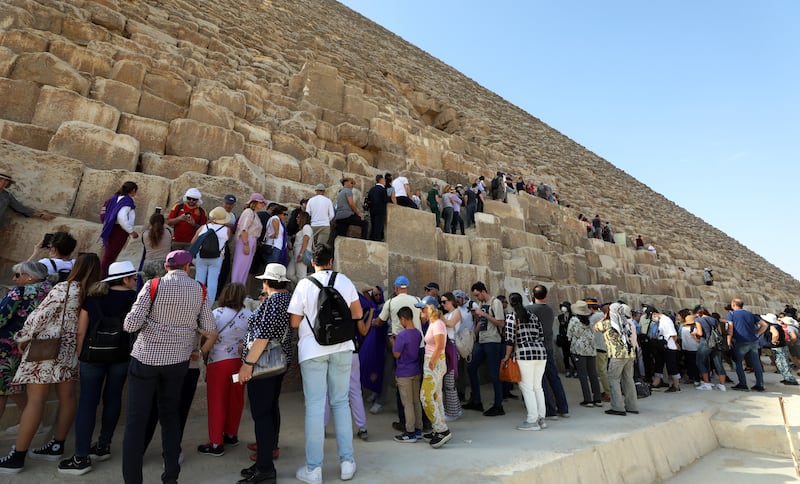
The Great Pyramid of Giza is located on the Giza Plateau. EPA

Built on the orders of the pharaohs thousands of years ago, the Great Pyramid of Giza continues to reveal its secrets.
On Thursday, scientists shared the discovery of a corridor inside the 4,500-year-old structure at an unveiling ceremony held at the Giza Plateau.
The previously hidden corridor is the latest discovery of the ScanPyramids project, a mission made up of heritage experts from Cairo University and the French Heritage Innovation Preservation Institute.
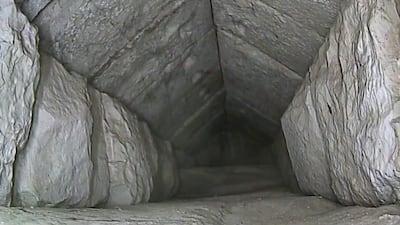
As Egypt’s most-visited attraction and the last remaining intact wonder of the ancient world, the great pyramids are shrouded in mystery with little consensus on how the giant structures were built.
The discovery of the concealed tunnel could lead to more findings on the construction of the pyramids, according to science journal Nature.
For curious travellers planning a trip to Egypt's pyramids, here's everything you need to know.
How do you get to Egypt's Great Pyramids?
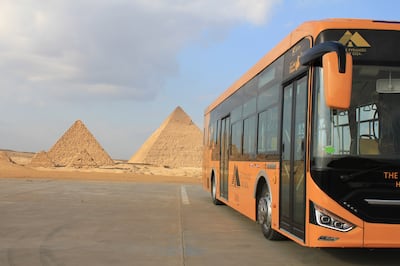
The Great Pyramid of Giza — also known as the Pyramid of Cheops or Khufu — sits beside the pyramid of Khafre and the pyramid of Menkaure, which make up the Giza Plateau.
The pyramids are located on the western outskirts of Cairo, and the easiest way to reach the destination is by car — whether that's via taxi, Uber or a private driver.
Public transport is available via the metro, with the nearest station to the pyramids on Al Haram Road. From here, it’s a short taxi ride or local bus trip to the site.
Once on-site, tourists can walk around the ancient structures or hop on one of the first batch of e-buses designed to take visitors through seven stations around the plateau.
There are also hotel options in the vicinity of the Giza Plateau, where travellers spending the night can simply walk across the desert to the pyramids.
What’s inside the Great Pyramid of Giza?
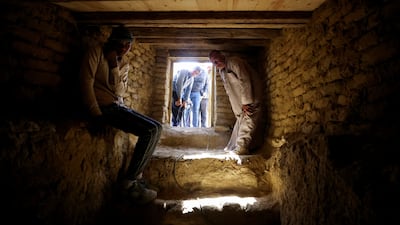
Despite the discovery of the hidden corridor inside the Great Pyramid of Giza, travellers need to lower their expectations a little before visiting the historic tomb, as most parts of the inner sanctums of the historic structure remain off-limits to tourists.
What visitors can see is the King's Chamber, Queen's Chamber and Grand Gallery. The King's Chamber is where Khufu was believed to have been buried. The only item in the room is the monarch's sarcophagus, hollowed out of a block of granite. Despite there not being too much to look at, it's fascinating to see the towering pyramid's strong structure from within.
No photography is allowed inside the tomb and tourists should be aware that it gets rather hot as there is no air conditioning inside.. Venturing into the tomb is not recommended for anyone who has claustrophobia.

Can I climb to the top of the pyramids in Giza?
View this post on Instagram A post shared by Andrej Ciesielski (@andrejcie)
Travellers cannot climb to the tops of the pyramids.
While visitors used to be able to roam freely around the structures, authorities introduced a ban on the activity back in the 1950s, although it wasn't always enforced then. That's not the case today.
In 2016, teenage tourist Andrej Ciesielski received a lifetime ban from Egypt after posting photos and videos of his pyramid climb on social media.
In 2019, a law banning climbing on Egypt's antiquities was introduced, carrying with it penalties of at least one month in prison and fines of more than $6,000. Despite this, tourists often try to stand on the lower rows of the pyramid stones for photographs.
How much does it cost to visit the pyramids?
Prices to visit the Great Pyramid of Giza are a reasonable 240 Egyptian pounds ($7.8) for tourists, with students able to enter at half that price. It's worth noting that this rate doesn’t include access to the tombs — a separate entrance fee applies to enter inside any of the pyramids.
Tickets to the Great Pyramid cost Dh52.50, while Khafre and Menkaure tickets are Dh12 each.
When is the best time of year to visit the pyramids?
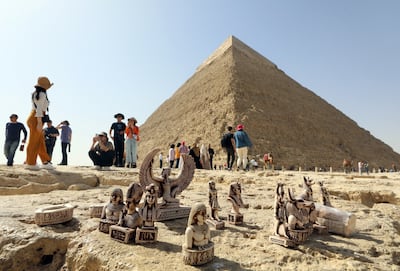
Open daily from 7am to 4pm, the pyramids are best seen from October to April, when the weather is not too warm. The site is open to tourists year-round, but travellers visiting in summer will want to avoid the mid-day heat.
What else can travellers see there?
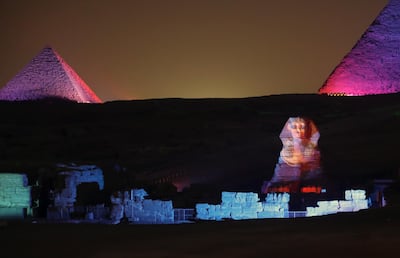
After visiting the three pyramids and the nearby Great Sphinx of Giza, travellers who want to explore further can scout out the plethora of tombs, temple ruins and smaller-sized pyramid structures dotted around the desert plateau.
The 9 Pyramids Lounge is the only on-site restaurant and has built a name for itself as the place to dine if you want lunch served alongside Instagram-friendly vistas of Egypt's ancient treasures.
After the daytime viewing closes, the Giza Plateau comes alive with a night-time light show that illuminates the historic structures. Telling the tale of ancient pharaonic legends, it projects images on to rock faces and uses the pyramids as an awesome backdrop. Tickets cost about $20, but the show is also visible from several rooftops surrounding the site.
For great photo opportunities or an alternative light-show viewing without a steep price tag, try the nearby KFC and Pizza Hut, where a rooftop terrace offers picture-perfect vistas of the ancient wonders — accessible for the price of a piece of fried chicken.
The inside tip
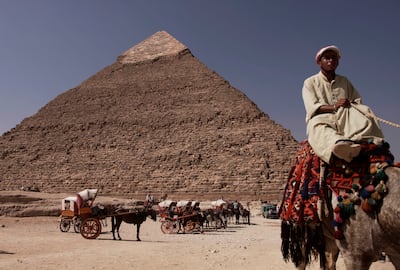
Avoid riding the camels and donkeys that wander around the Giza Plateau. Not only are you likely to be asked to pay a hefty fare, but you will also be spending your tourism dollars for supporting activities using wildlife where the welfare of the animals cannot be verified.
Checking In
Travel updates and inspiration from the past week

Early tourists visiting the Pyramids and the ruins of Ancient Egypt, 1860-1930
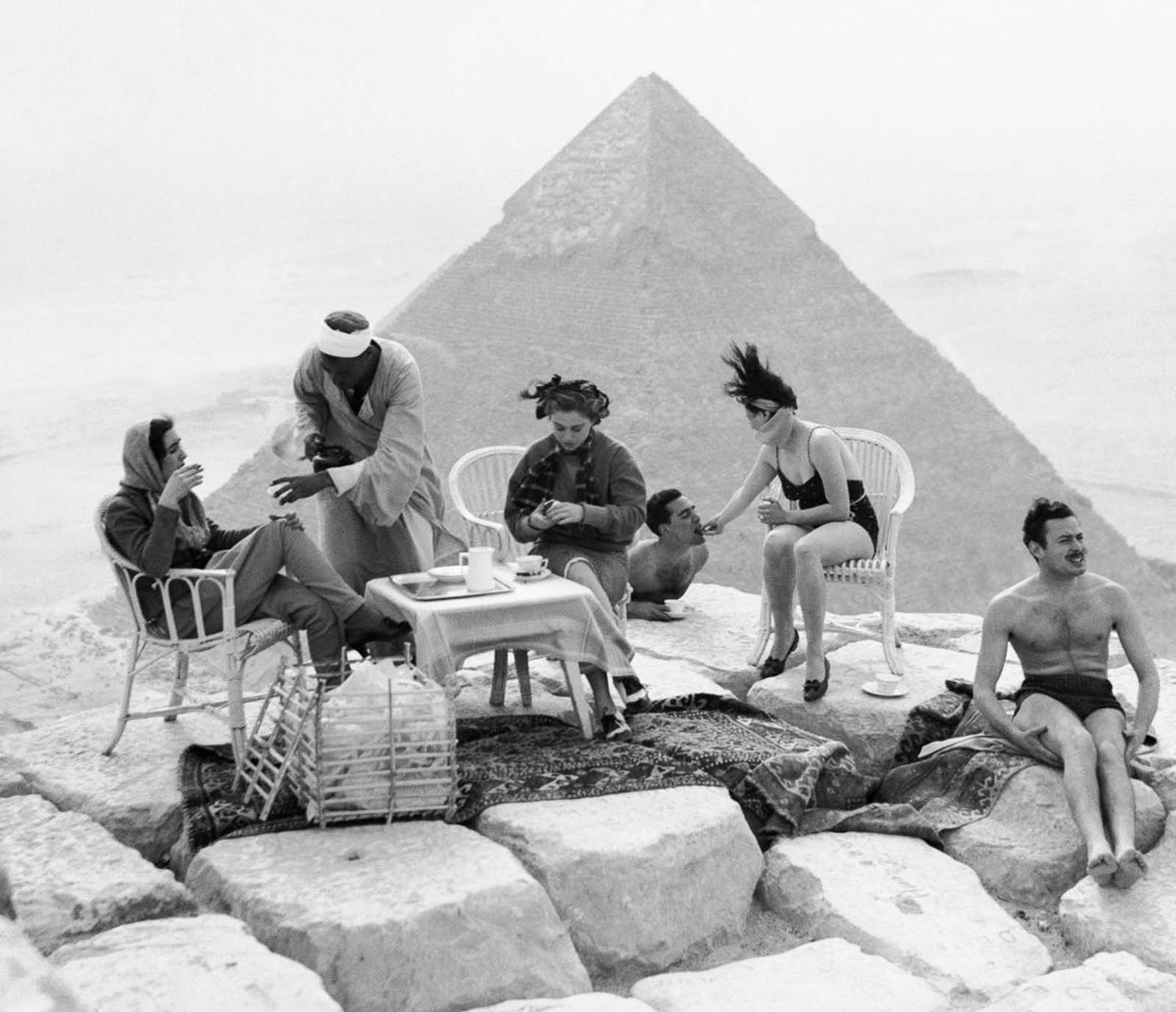
Tourists take tea atop the Great Pyramid. 1938.
By the late eighteenth century, Egypt had been reduced to nothing more than an impoverished and neglected corner of the Ottoman Empire, crippled by endless power struggles among its Mamluk leadership.
Then in 1798, Napoleon arrived at the head of a French army, closely followed by the British, who had hitherto shown little interest in Egypt.
After the French retreat, Egypt became gradually Westernised under the Albanian Ottoman Muhammad Ali Pasha, so that by the time the English novelist Thackeray visited Alexandria in 1845, the Nile ‘was lined with steel mills’ and looked ‘scarcely Eastern at all’.
Egypt’s early tourism trade started in the 19th century and increased in popularity alongside the rise of Egyptology as an academic and amateur pursuit. Especially, after the completion of the Suez Canal in 1869, it became much easier to visit Egypt.
Organized group holidays offering an all-inclusive price that reduced the travelers’ costs were an innovation of the 1840s. Thomas Cook (1808-1892), a brilliant entrepreneur from England, is seen as their inventor and thus the pioneer of commercialized mass tourism.
In the 1870s, Cook offered his famous tour of Palestine and the Nile, a way for wealthy people to explore the wonders of Ancient Egypt. Many of these tourists took pictures in front of the ancient ruins or the Great Sphinx, some of them even climbed all the way to the top of the pyramids.
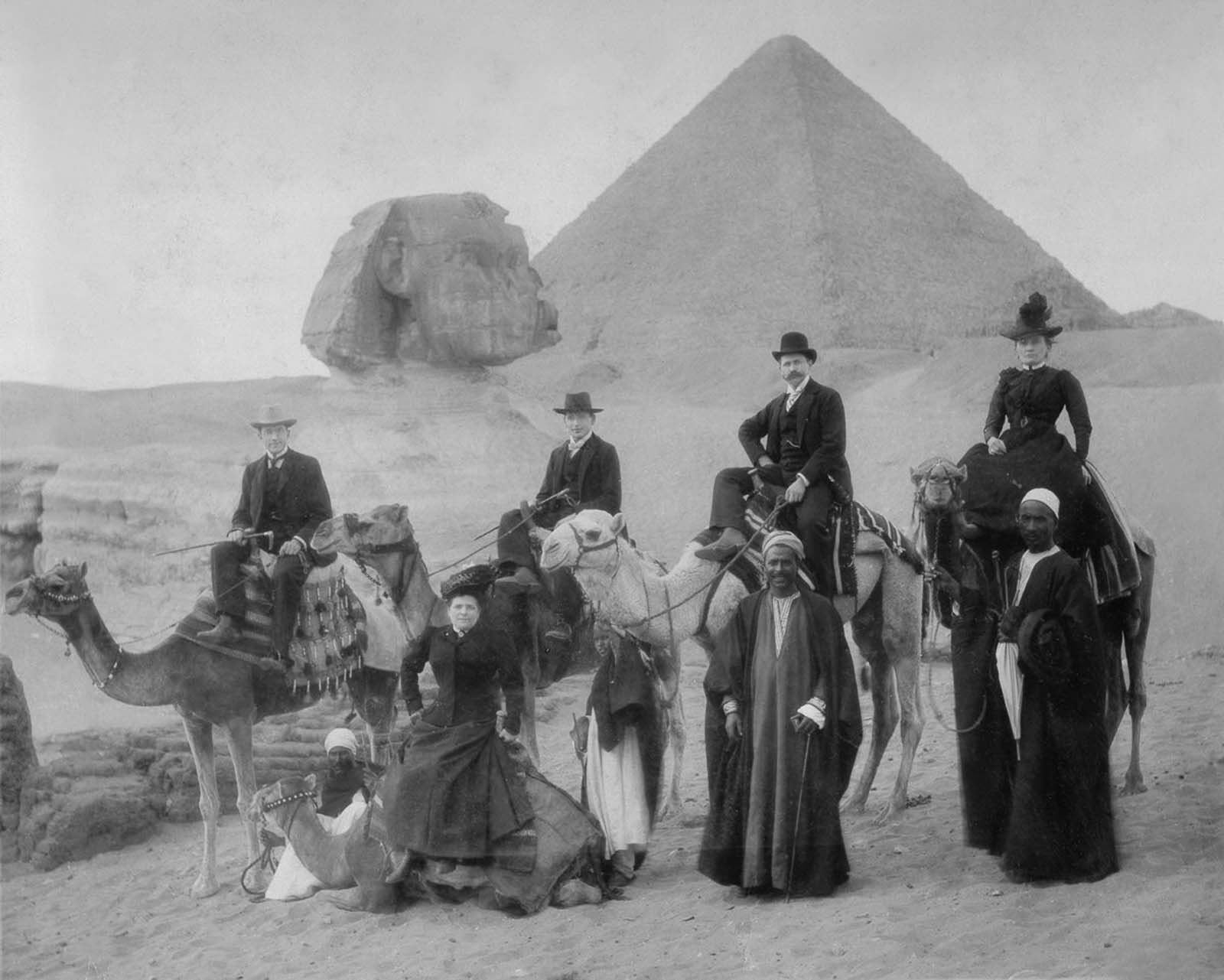
British tourists. 1900.
Scores of photographers, seeking to establish their studios, began arriving in Egypt following the tourist gaze. They hauled heavy equipment across the desert to photograph the wonders of the Nile Valley.
Some opened studios in the larger cities where they sold their wares to tourists; a few were engaged by Egyptologists to document excavations. Travelers exploring the monuments of ancient Egypt could return home with souvenir photographs of the sights they encountered.
For Europeans, Egypt and Egyptian history offered a more vivid and exotic picture of the ancient world than probably any other culture. With a history covering over 3,000 years, dynasties of pharaohs lasting for centuries, and extraordinary figures like Alexander, Cleopatra, and Tutankhamun illuminating the story, this is hardly surprising.
The pictures collected here are part of a collection documenting the British occupation of Egypt and show the early tourists exploring the ruins of Ancient Egypt.
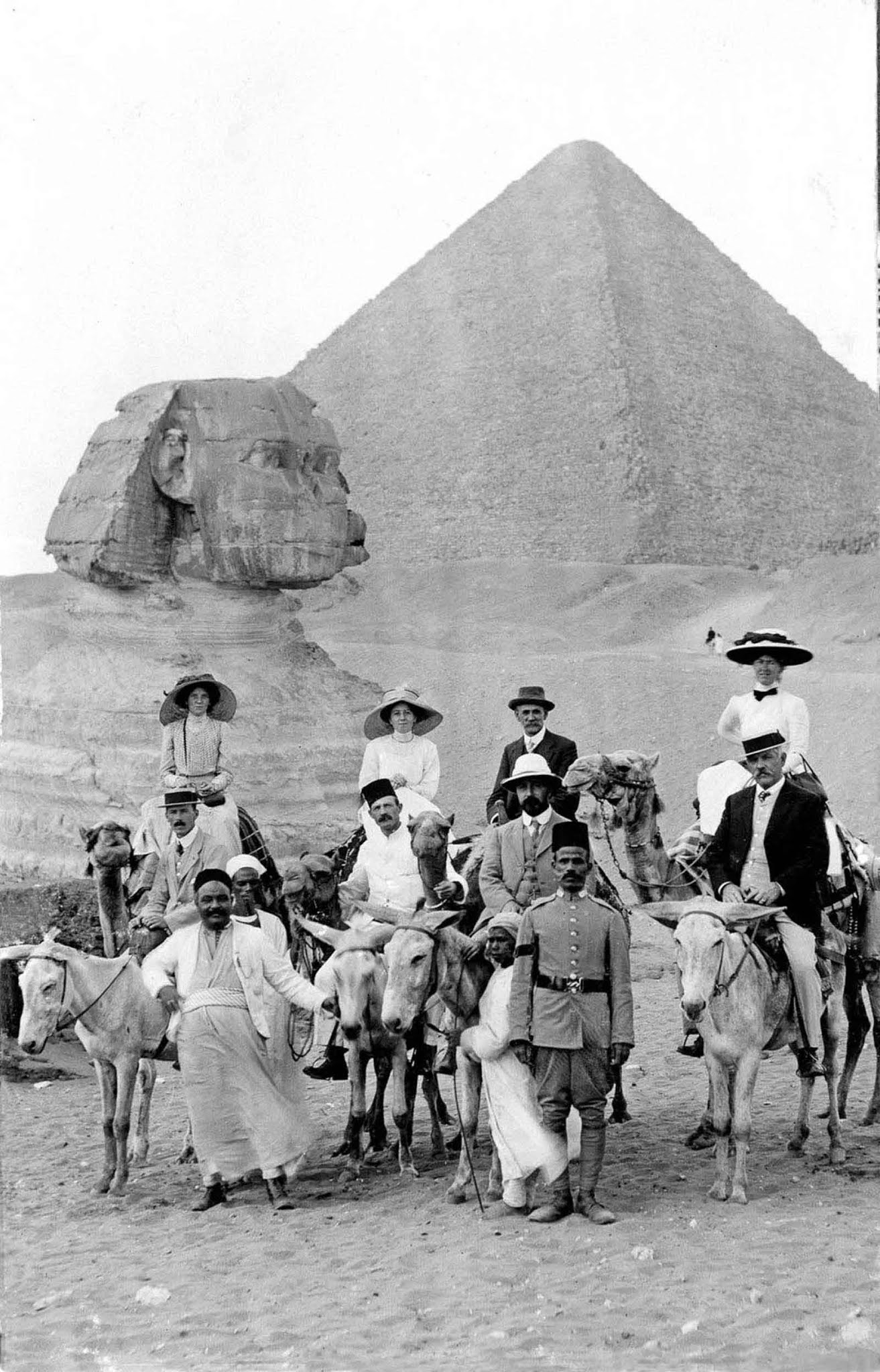
Britsh tourists in front of the Great Sphinx. 1910.
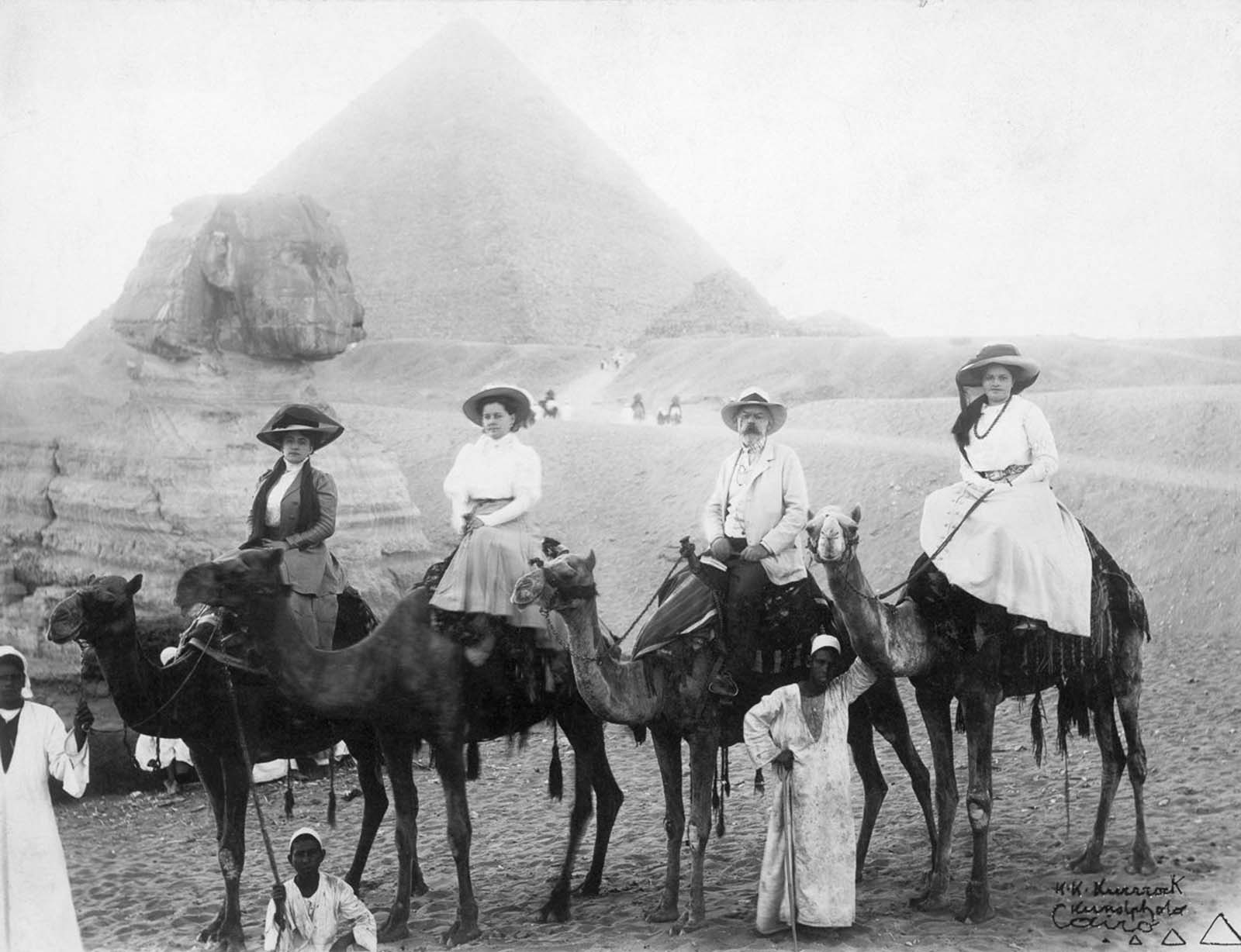
The ruins of Ancient Egypt. 1905.
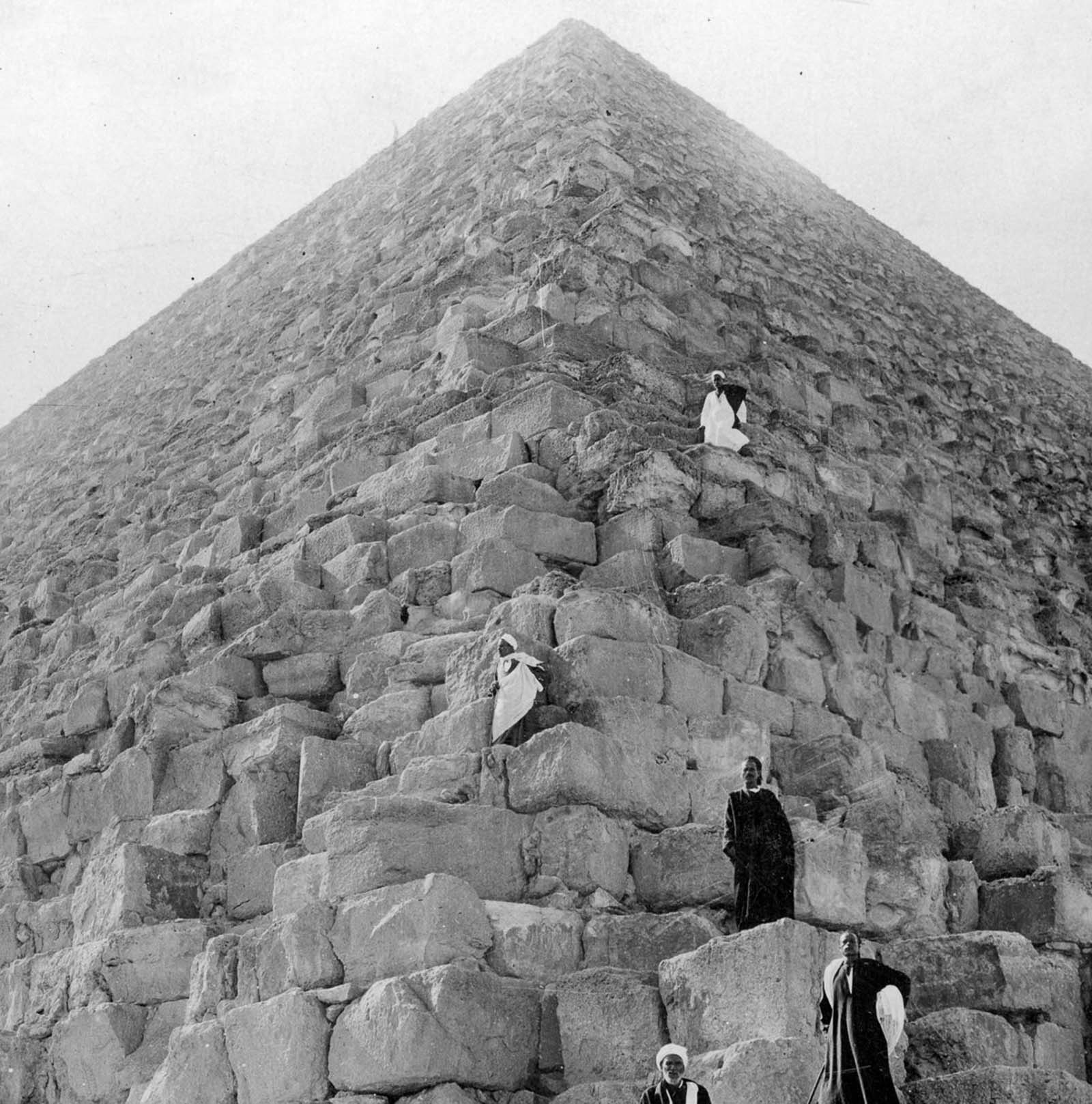
Some of the more adventuresome tourists were determined to see the view from the top of the 455-foot Pyramid of Cheops.

The Prince of Wales and the Duke of Gloucester climb one of the pyramids. 1930.
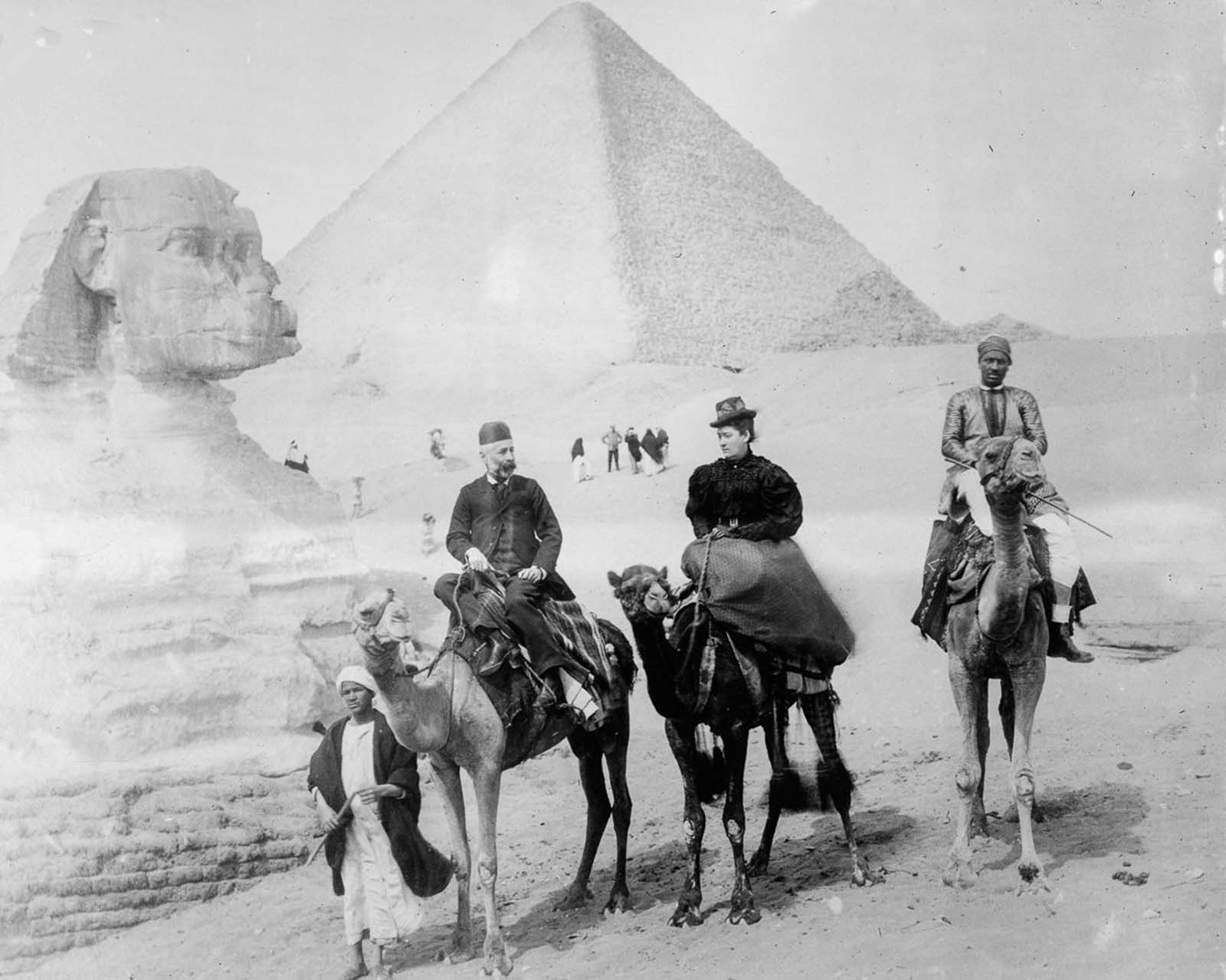
British tourists in Egypt. 1895.
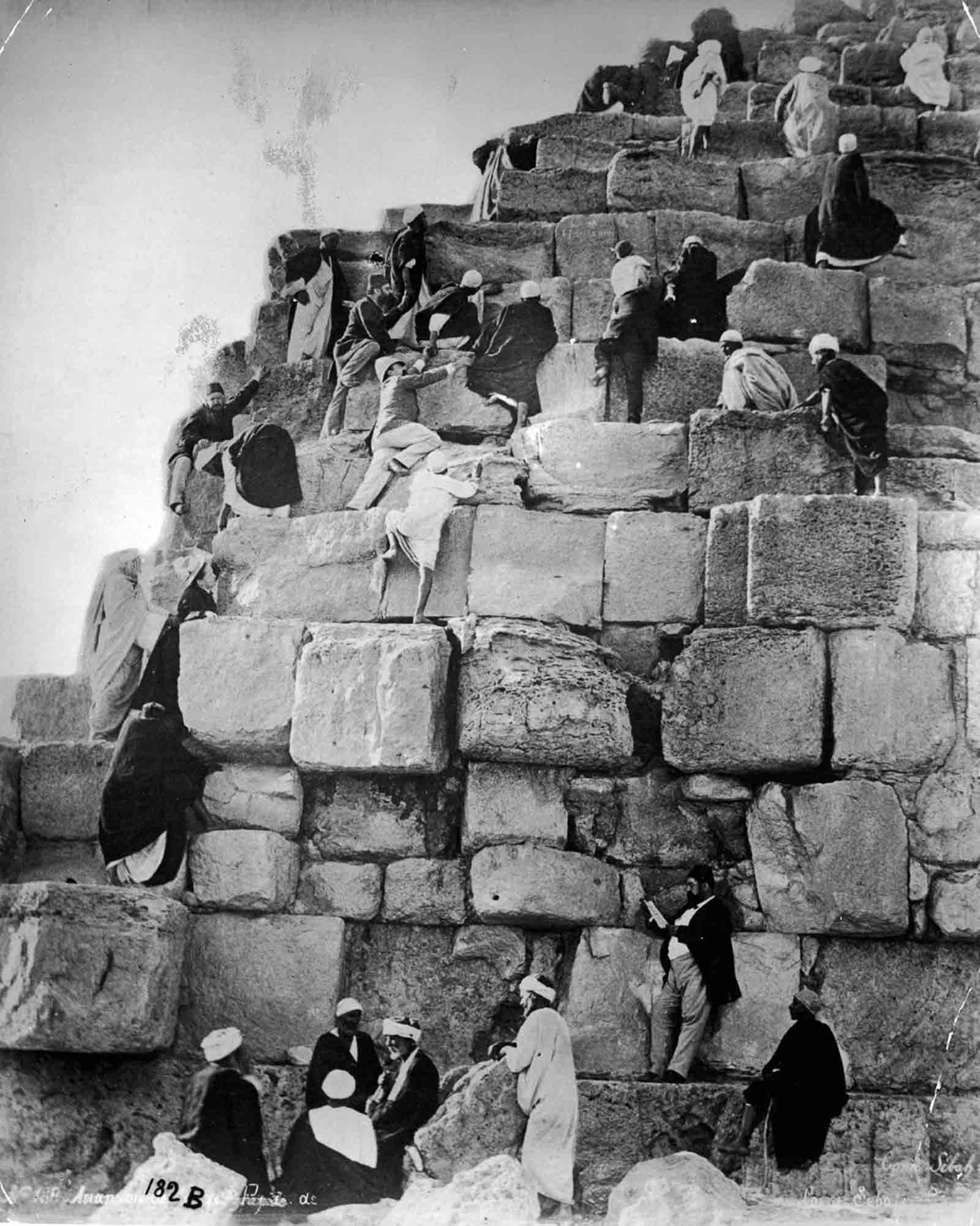
Egyptians and tourists clamber up one of the pyramids. 1880.
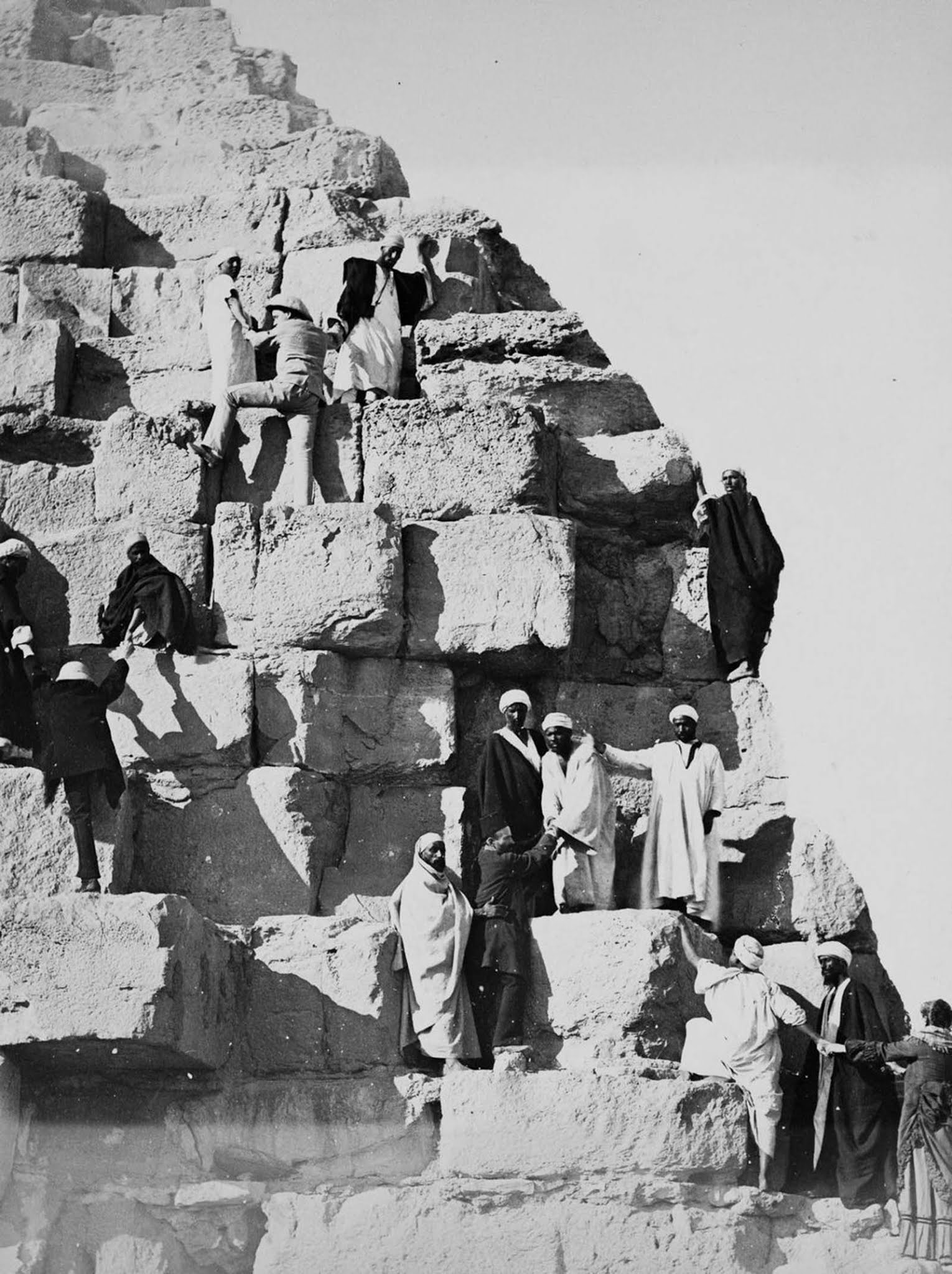
Tourists in 1892.

The smooth white limestone which had once encased the pyramid had long since been torn off for use in buildings in Cairo, leaving the massive structural blocks for tourists and local guides to clamber over. 1930.

Locals helping a tourist climbing the pyramid. 1860.
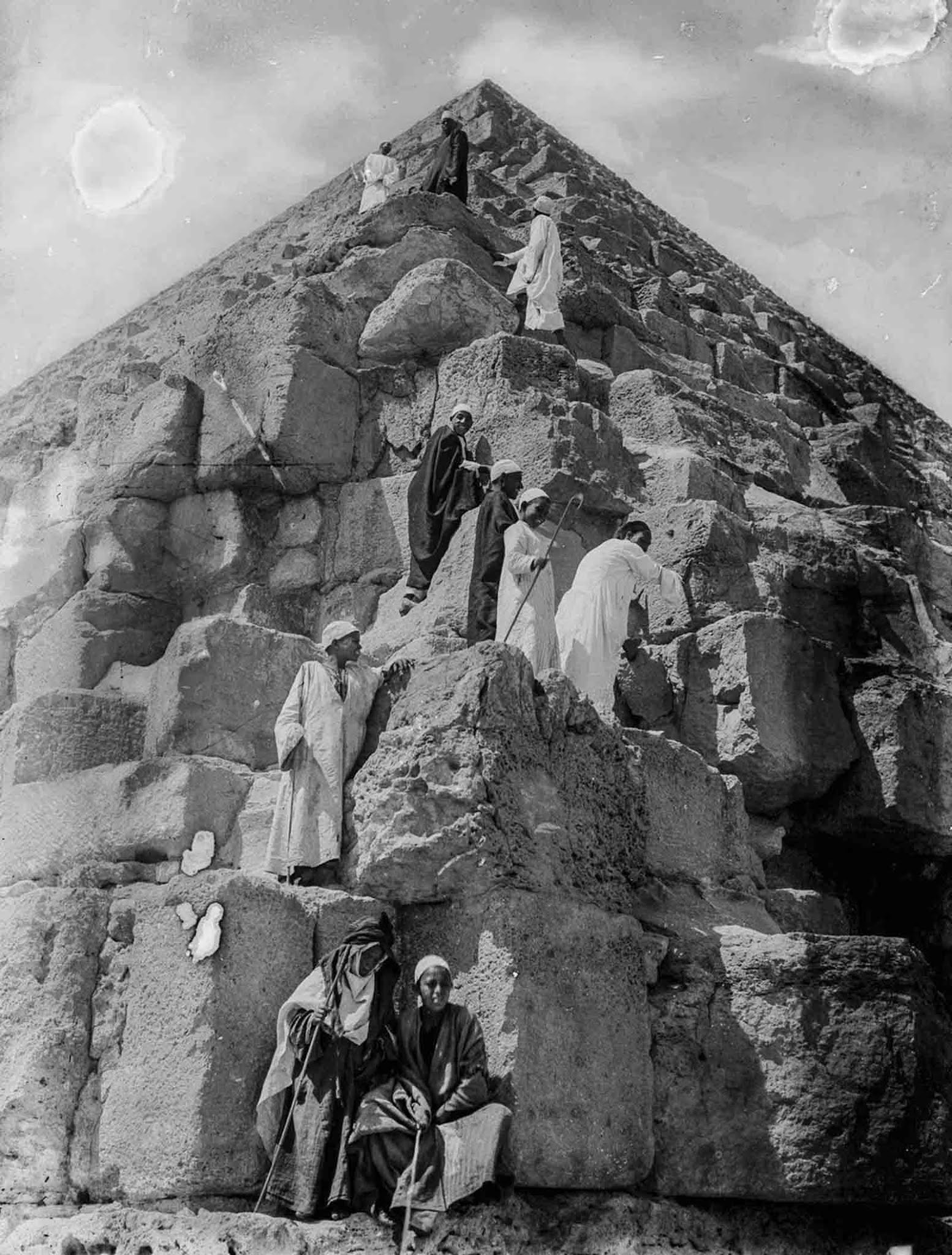
With the completion of the Suez Canal in 1869, visits by wealthy tourists increased. 1900.

Early tourists in Egypt.
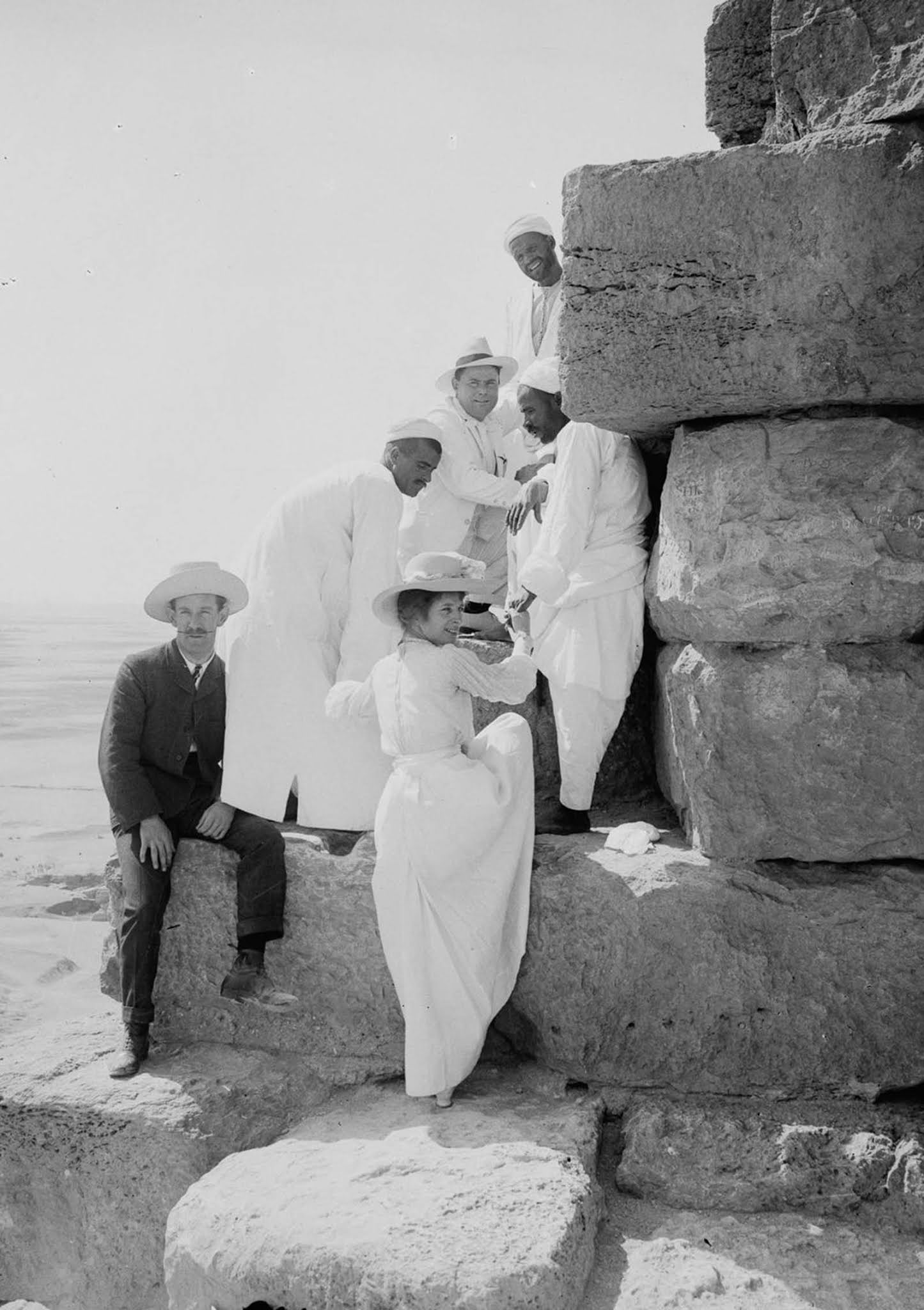
A lady climbing the pyramid. 1900.
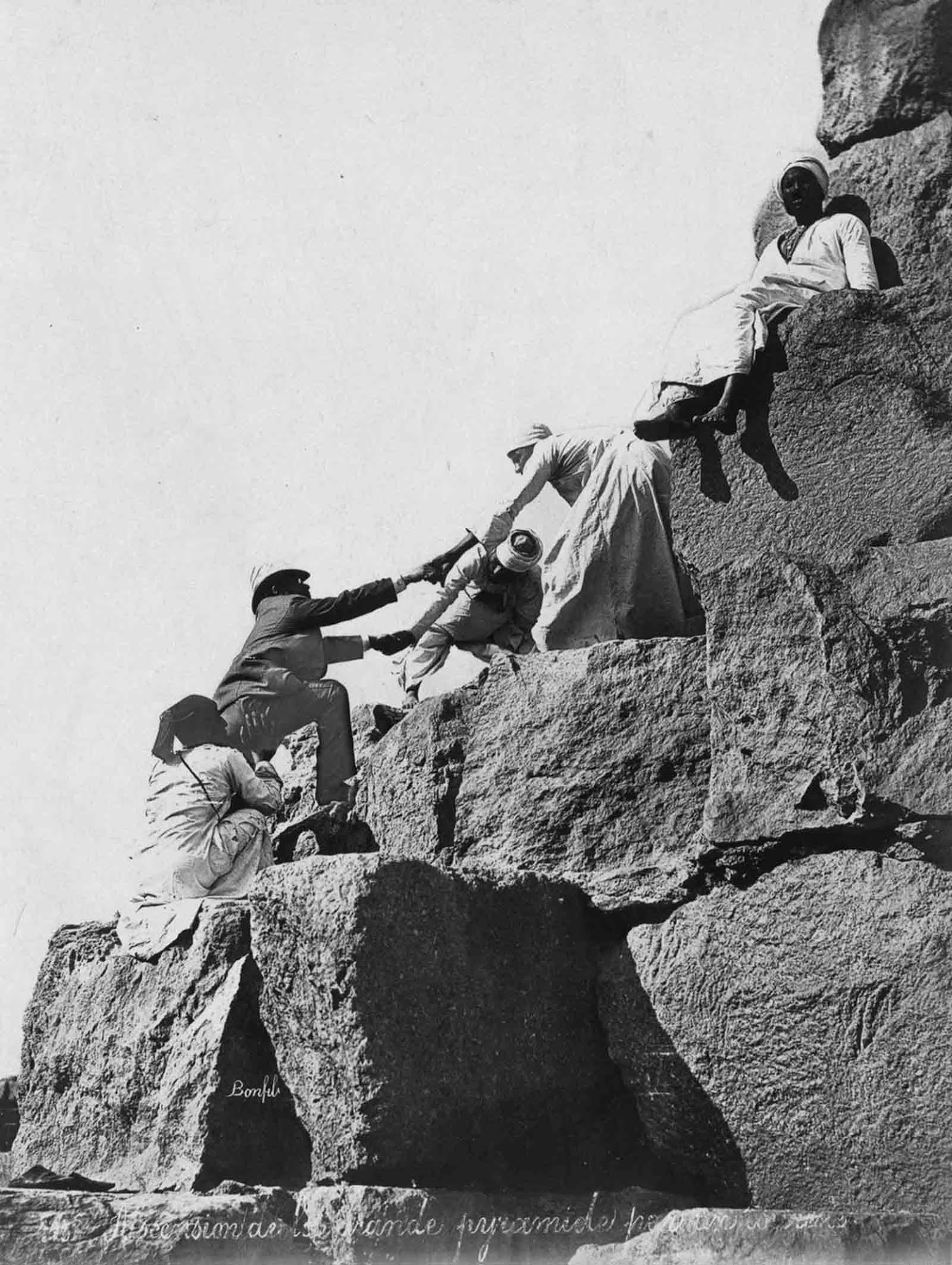
It was quite a challenge to climb the pyramid! (1867)
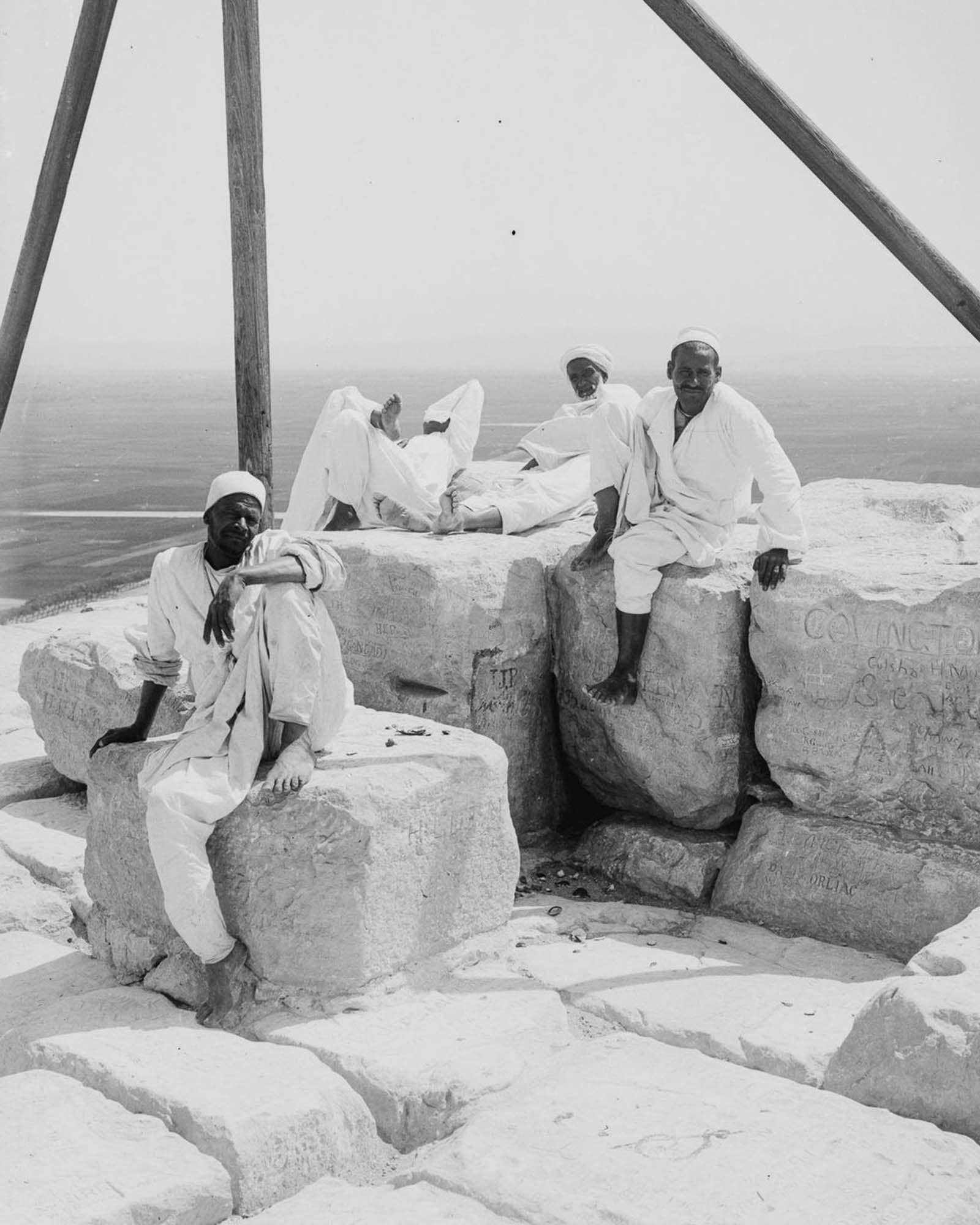
Men rest atop the Great Pyramid. 1900.
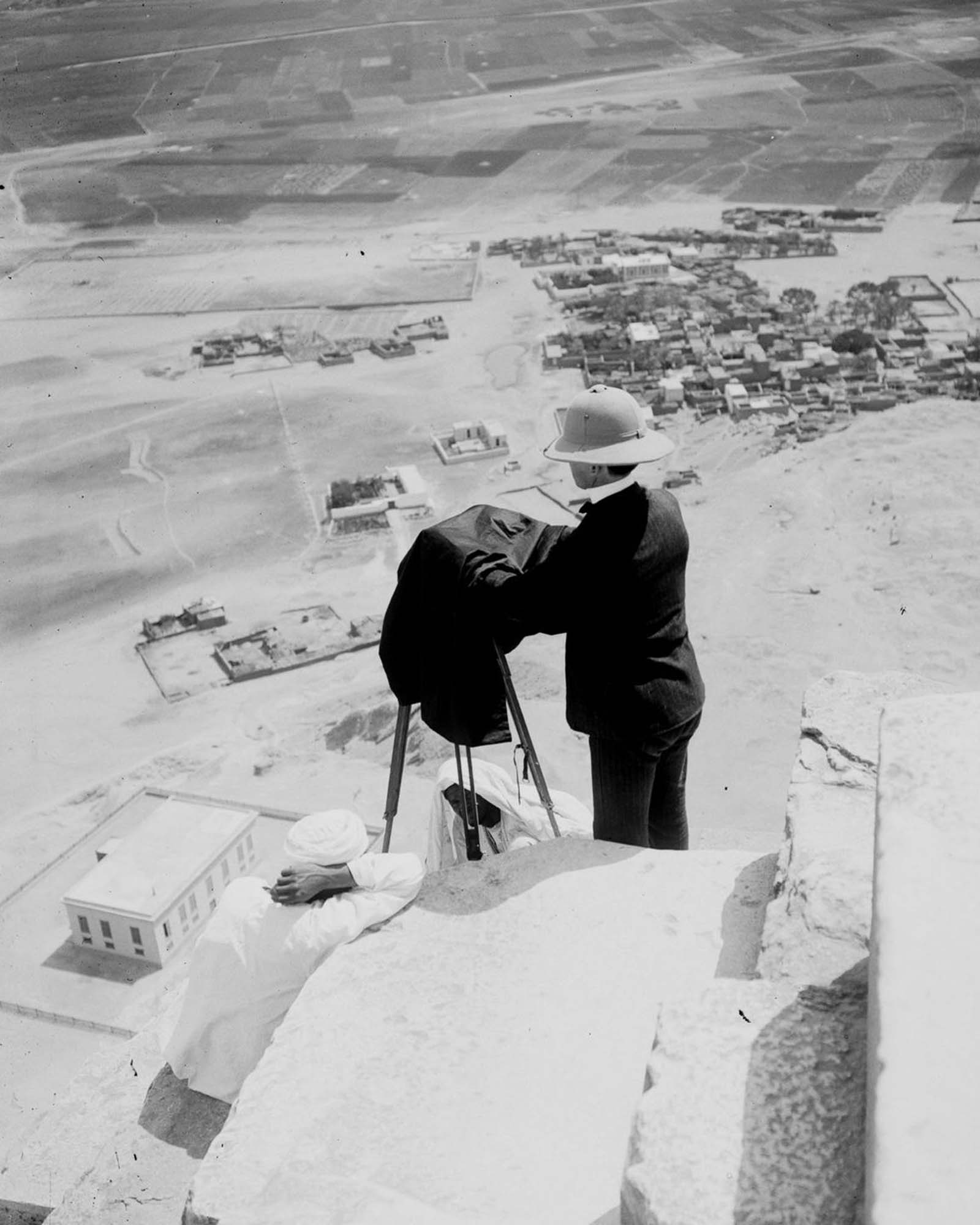
Photographer Lewis Larsson composes a photo from atop the Great Pyramid. 1900.

A view from the top of the pyramid. 1900.
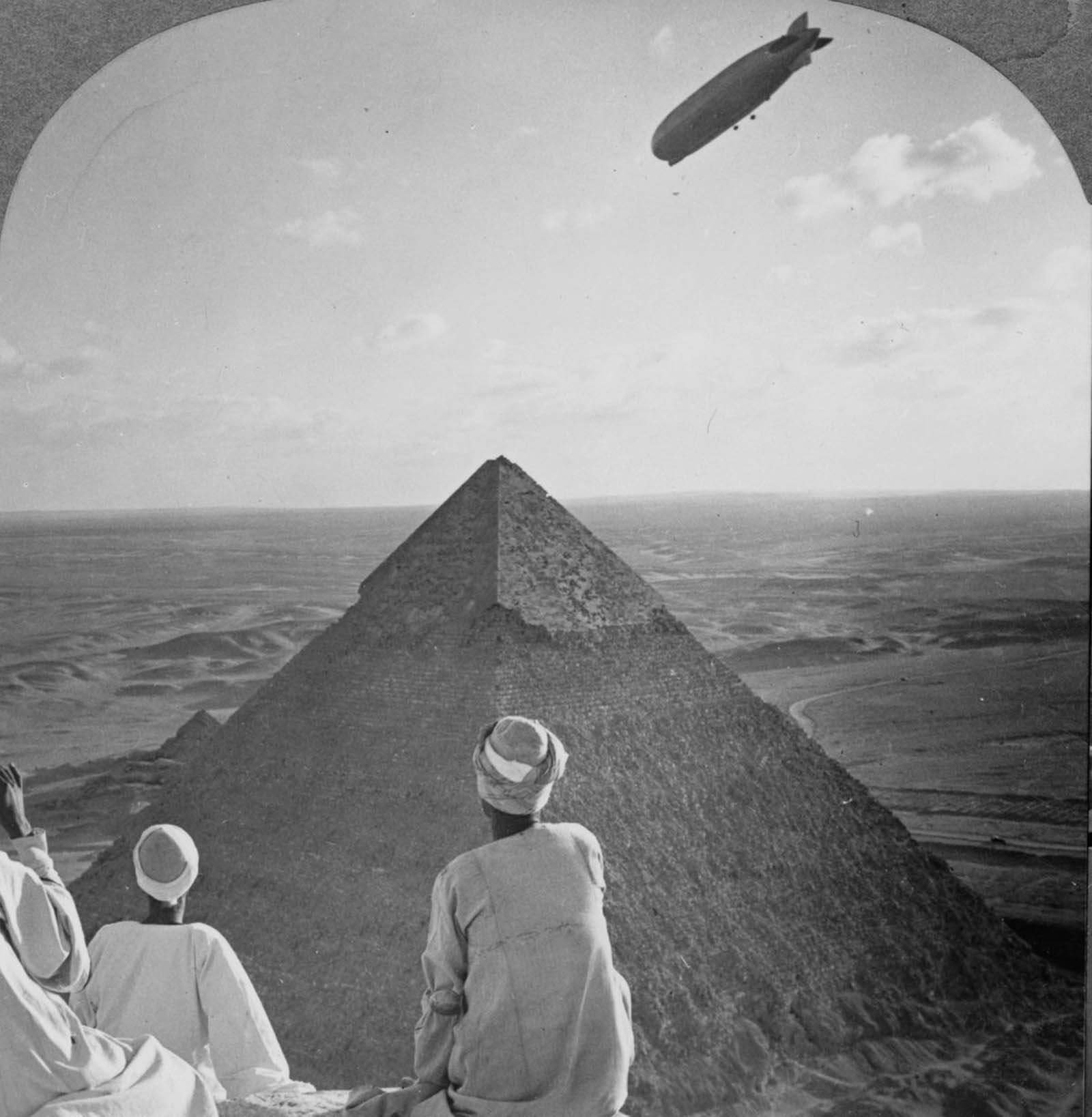
Egyptian men watch as the Graf Zeppelin floats over the pyramids of Giza. 1931.
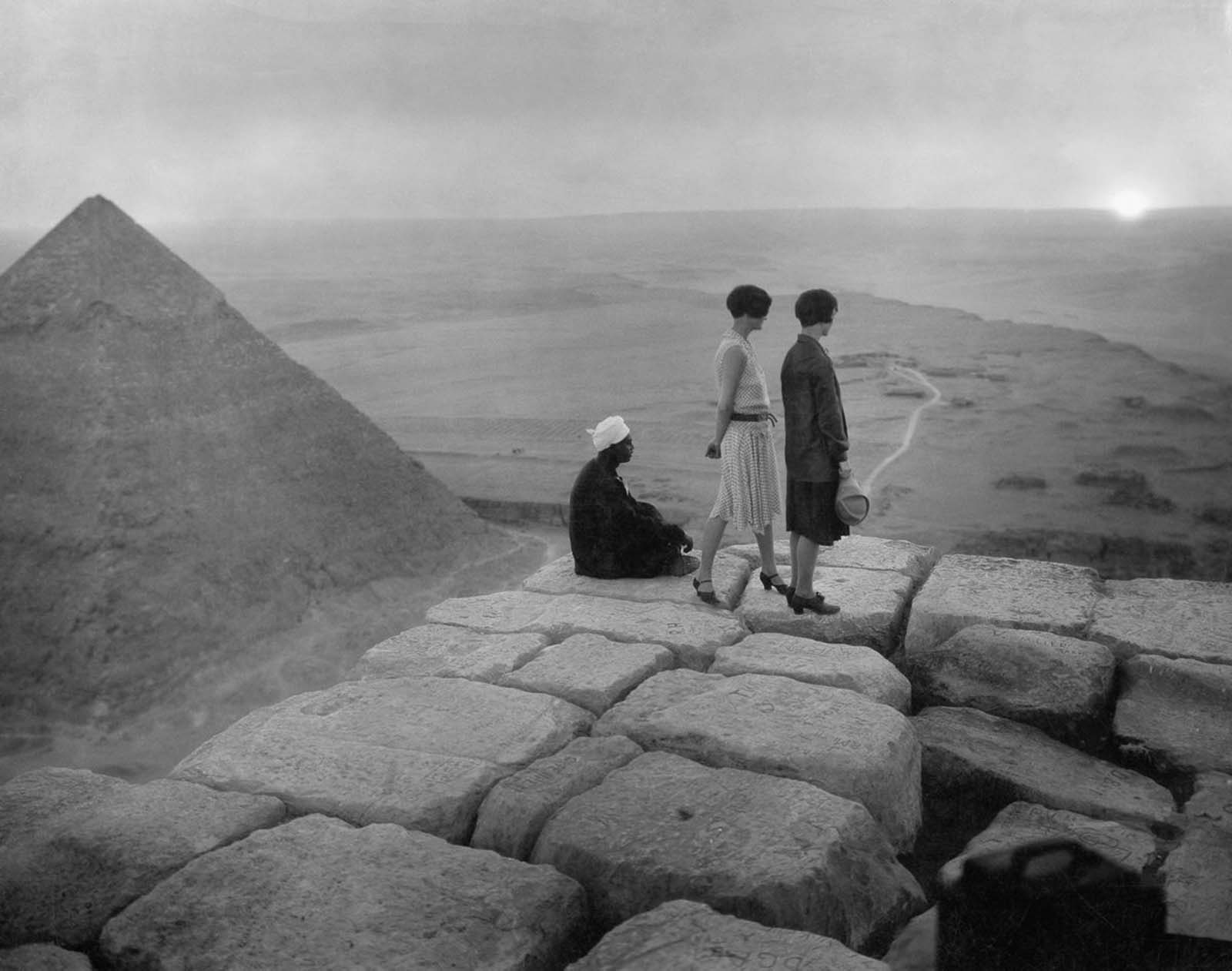
Two ladies and a local man watching the sunset. 1925.
(Photo credit: Library of Congress).
Updated on: November 30, 2021
Any factual error or typo? Let us know.
Egypt’s Giza Pyramids are getting a revamp to boost tourism
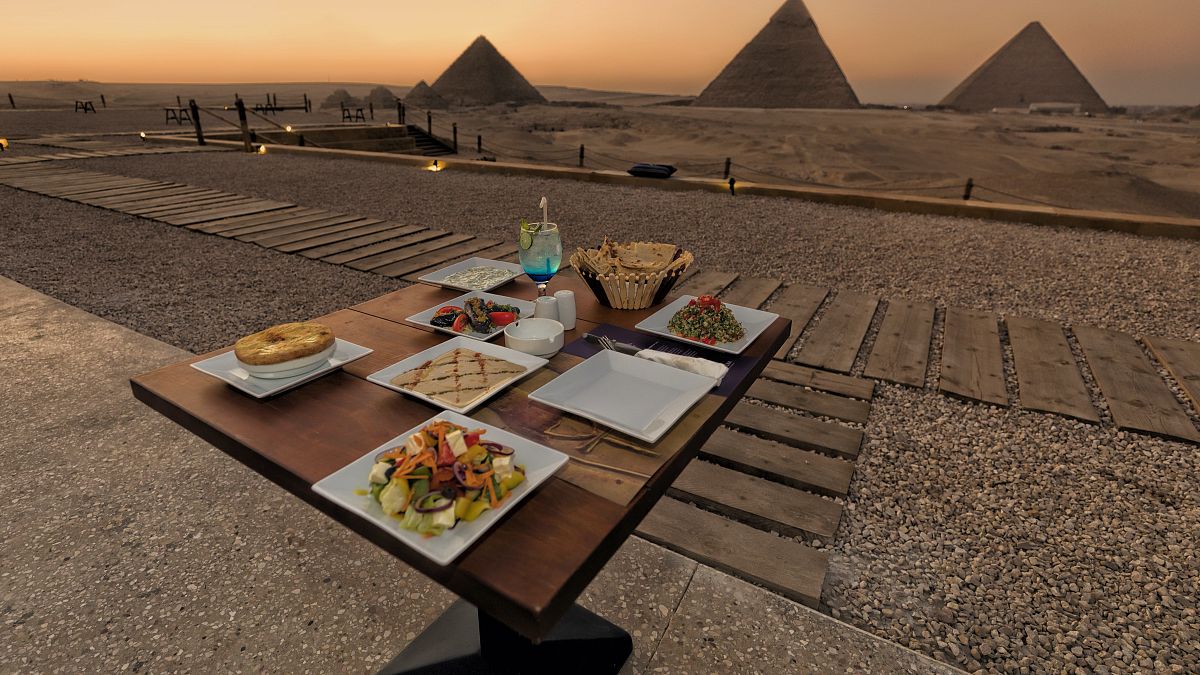
After 4,500 years, Egypt's Pyramid Plateau deserves an upgrade.
The Great Pyramids of Giza are one of the most recognisable tourist attractions in the world. The ancient Egyptian pharaohs built them to last forever and now, 4,500 years later, they’re getting a revamp.
With the goal of making the country’s most popular heritage site more accessible to tourists, a 17 million euro renovation is underway. The refurbishment is centred on the Giza Plateau, which houses the Sphinx and three pyramids, including the oldest and tallest masonry structure, the Great Pyramid of Khufu.
The ambitious project includes a new visitor centre, an environmentally-friendly electric bus and the first restaurant ever to be located on site.
- Egypt reopens pyramids after coronavirus shutdown
- Crazy camel racing in Egypt's Sinai desert keeps Bedouin traditions alive
The Pyramid Plateau gets its first-ever restaurant
Tourists exploring Egypt’s Giza Pyramids can now enjoy a great meal afterwards, with the opening of the first-ever restaurant on Pyramid Plateau.
The 9 Pyramid Lounge , which opened in late October, is designed to mimic a traditional Bedouin camp in the desert. At 1,341 square meters, the complex has plenty of options for diners - who can choose between eating al fresco on the Bedouin-style cushions scattered about the place, or under the canopy where chairs and tables are available.
The complex was built with all natural materials to blend in with its surroundings and to demonstrate the project’s commitment to sustainable tourism in the area. In addition to the restaurant, a fleet of electric busses and golf-carts have been trialed with the aim of these becoming the only modes of transport on the site.
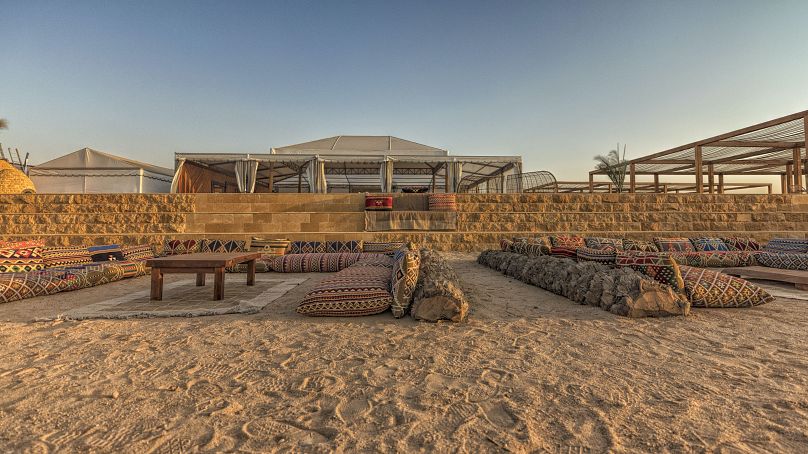
The restaurant was financed by Mr Naguib Sawiris, Chairman and CEO of Orascom Investment Holding, in partnership with the Supreme Council of Antiquities in Egypt. Mr Sawiris is Euronews' majority shareholder.
He explained the thinking behind the new venture: “Our main objective was to upgrade the services provided to the visitors to be able to level up to the greatness of Egyptian civilisation and the magnificence of this historical site, while preserving this area from all forms of pollution, and creating a fascinating experience for its visitors.”
- Egypt’s fight to preserve coral reefs in the Red Sea
A ‘one of a kind’ view
Sawiris added: “The breathtaking view of 9 Pyramids is one of a kind in the whole world. This is in addition to two fine dining restaurants and a café to be launched in early 2021 in the old engineering administration building on the Northwestern side - which has been completely modernised and redesigned to serve as a restaurant complex.”
Boosting tourism in Egypt
9 Pyramid Lounge is one of a number of projects designed to boost tourism in and around Egypt’s capital, Cairo.
Tourism accounts for more than 12 per cent of Egypt’s gross domestic product (GDP), according to government statistics. The new facilities at the Giza plateau are part of a wider effort to develop key tourist sites in the country. The Grand Egyptian Museum, which will become the world's largest archaeological museum, is set to open next year.
Dr Khaled El-Enany, the Minister of Tourism and Antiquities, said at the unveiling of 9 Pyramids Lounge that Egypt is keen to transform the tourism map of Cairo.
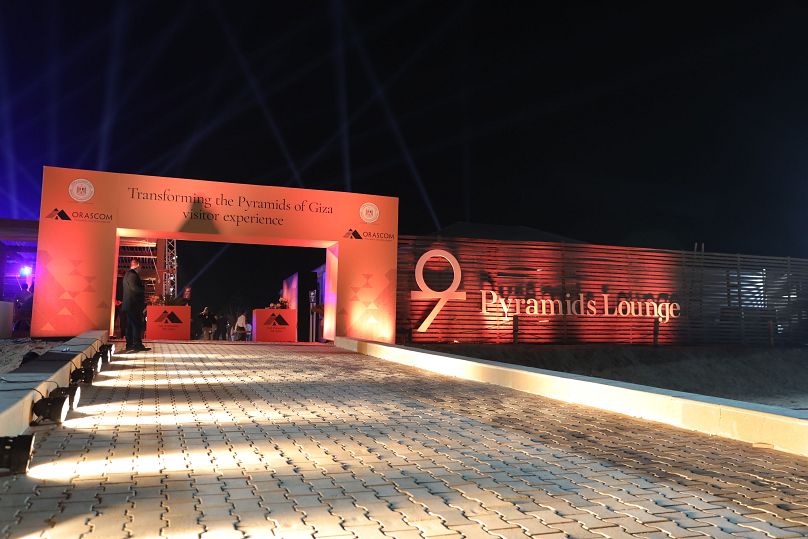
For years, locals selling souvenirs and camel rides have been part of the experience when visiting the famed site. But now the sole remaining wonder of the ancient world can be viewed in a calmer setting as a new souk regulated by permit holders will be launched at the start of next year.
The plan to renovate the ancient site has been in motion for the past 15 years, but the project was put on hold in 2011, after the revolution that ousted long-time ruler Hosni Mubarak.
The years of political unrest that followed and a deadly terrorist attack on a Russian passenger plane in 2015 saw the country’s tourism industry a heavy hit . But lately, the industry has begun to bounce back. Last year, 13.6 million people visited Egypt and before Covid-19 struck, 2020 was expected to exceed 15 million.
You might also like
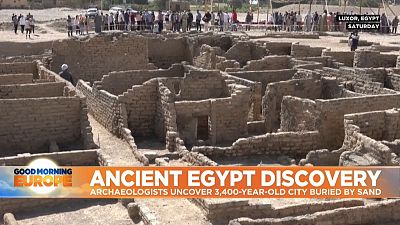
Uncovering lost Egyptian city 'the most important discovery' since King Tut's tomb
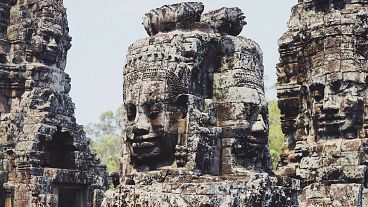
Meet the gardeners risking their lives to save Angkor Wat

When and why are Heathrow Airport staff striking?
The lonely pyramids of Giza: Egyptian tourism’s decline
The recent Coptic church bombings could further damage the already crippled tourism sector in the country.
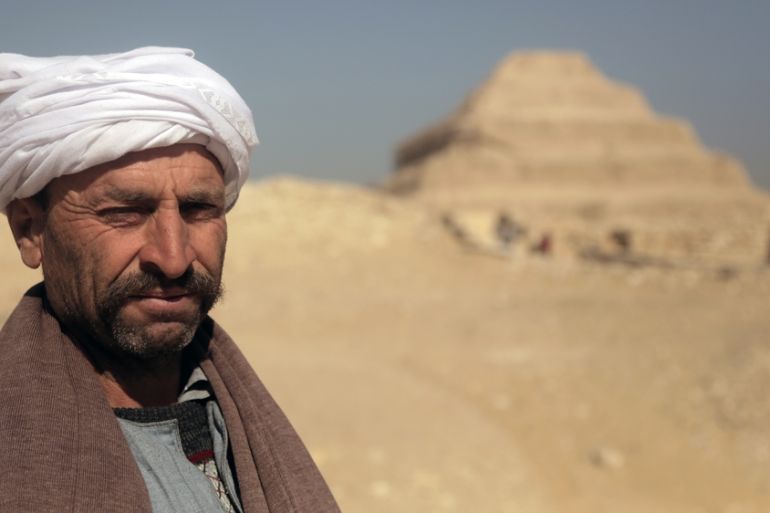
Dozens of wrinkled Egyptian men sip tea, draw smoke from water pipes and boisterously chat in Arabic. Stray cats scamper beneath their feet. They lounge at a bustling alleyway cafe, sandwiched between the labyrinths of crumbling apartment buildings in the heart of Cairo, adjacent to Tahrir Square.
Just footsteps away, the maniacal spectacle of Cairo traffic is at work. Rusty cars whir by, lurching left and right, an orchestra of horns trumpeting their arrival and departure from one traffic light to the next. There’s no time for signalling. Exhaust fumes hang thick in the air. Around each corner, there is singing, squawking, screaming.
Keep reading
Thousands protest against over-tourism in spain’s canary islands, how one mexican beach town saved itself from ‘death by tourism’, photos: tourist numbers up in post-war afghanistan, malaysia’s airport fee hikes leave bad taste in travellers’ mouths.
This is both the doorstep to the Middle East, the corridor to North Africa, the launchpad of revolutions that reverberated worldwide, and the home of more than nine million Egyptians. But despite the beautiful chaos, Egypt is actually drought-stricken when it comes to visitors.
That reality is more visible, just a few blocks away, towards the banks of the River Nile. The marble-encrusted lobbies of Cairo’s many luxury hotels overlooking the Nile, once bustling with globetrotting tourists from every corner of the earth, are now silent.
![egypt tourism pyramids Khan El-Khalili, the old Arab souk of Cairo, is blooming with life, and its sights, sounds and people capture the essence of the Egyptian capital's soul [Dorian Geiger/Al Jazeera]](https://www.aljazeera.com/wp-content/uploads/2017/04/2055d100dbac4db5b37ff7d7a70fdf9b_18.jpeg)
Still recovering from the hangover of a failed revolution, a string of unfortunate airline disasters – including an ISIL bombing of Russian Metrojet Flight 9268 over the Sinai Peninsula in 2015, which killed 224 people, and indefinitely halted all Russian flights to the country – and most recently, the deadly bombings of Coptic churches in Tanta and Alexandria earlier this month, Egypt’s once-resilient tourism industry is battered and bruised.
The city’s tour guides, who used to be overworked, have been hit the hardest by the tourism industry’s fall from grace.
“I used to work at least 20 days a month,” said one Egyptian tour guide who asked that his name be withheld for security reasons. “Sometimes you have to close your phone because of many people calling you. During Christmas time and Easter holidays, no room, no hotels, no cars, no guide. Everything was busy.”
![egypt tourism pyramids A worshipper at the Coptic churches in Old Cairo poses for a portrait. Roughly 10 percent of Egypt's population of 82 million are Christian [Dorian Geiger/Al Jazeera]](https://www.aljazeera.com/wp-content/uploads/2017/04/4eab3848f45747cd9b1c073a50dd2bfa_18.jpeg)
“It’s the opposite now, completely,” the Giza-based guide added, with hints of sadness in his voice as he explained the deterioration of his work.
“One month, maybe you don’t work at all. We don’t expect as many tourists as before. It’s very hard. I was lucky to not quit tourism. Many of my friends, the tour guides, they quit tourism and they found other work.”
![egypt tourism pyramids A mosaic of St. George slaying a dragon at a Coptic church in Old Cairo [Dorian Geiger/Al Jazeera]](https://www.aljazeera.com/wp-content/uploads/2017/04/accfcf73f96e40509eaf9bfa43d17803_18.jpeg)
The number of tourists visiting Egypt has plummeted from 14.7 million to 5.4 million in 2016, according to the United Nations World Tourism Organisation, or UNWTO, costing the country billions.
“It’s pretty dead,” said Steven Cook , a senior fellow for Middle Eastern studies at the Council for Foreign Relations.
Cook noted that Egypt’s tourism industry has often borne the brunt of the country’s political uncertainty and its security crises.
“I think the uprising in 2011 and the uncertainty throughout the transition period from [Hosni] Mubarak to [Mohamed] Morsi contributed [to] people staying away,” he added. “It’s really not terribly surprising given everything that’s happened since January 25, 2011, that the Egyptian tourism has been hit extremely hard. In 2010, the country welcomed something like 15 million foreign tourists. They haven’t even come close to that since. It’s unfortunate.”
However, before the most recent Coptic church attacks in Alexandria and Tanta, there were indicators tourism could be on the upswing in 2017.
![egypt tourism pyramids This gigantic, 83-tonne statue of Ramses II was carved in limestone [Dorian Geiger/Al Jazeera]](https://www.aljazeera.com/wp-content/uploads/2017/04/02ec508db8754989b6e7e4c416706e37_18.jpeg)
Last month, a colossal pharaoh’s head – thought to belong to either Ramses II or King Psammetichus I – and a limestone bust of Seti II, were unearthed from from the mud of a Cairo slum. On the heels of that find, a new pyramid dating back to the 13th dynasty, was discovered just south of Cairo by an Egyptian excavation team. These discoveries, both widely publicised, revived international interest in Egypt as an archaeological hotspot.
Russian flights to Egypt, which have been suspended since the Metrojet bombing in 2015, could also resume soon, although the prospect remains dubious. Nearly two and a half million Russians visited Egypt in 2014, making up roughly a third of the country’s visitors, and a revival of this flow in human traffic would also boost the sagging tourism sector.
Egyptians were also hopeful that Germany’s Chancellor Angela Merkel , actor Will Smith , and football superstar Lionel Messi ‘s recent visits to the pyramids would provide further momentum to a potential influx in foreign travelers.
![egypt tourism pyramids A standing statue of Ramses II in Memphis. Tourism in Egypt has plummeted from 14.7 million people in 2010 to 5.4 million in 2016 [Dorian Geiger/Al Jazeera]](https://www.aljazeera.com/wp-content/uploads/2017/04/2d8d74b2c27f4d9eb0ed755635ce8f03_18.jpeg)
“People are fascinated by ancient Egypt and so it would bring more people back,” Cook said in reference to the latest archaeological discoveries.
“The fact that high-profile individuals like Lionel Messi and Will Smith were visiting the country, they were very hopeful that those were good signs and that they would attract people back to the country,” he added.
But all this momentum, Cook said, is likely to now be interrupted following this month’s Coptic church bombings.
“Every time [Egyptians] think they’re turning the corner, something else happens that undermines the tourism industry,” Cook explained. “Whether it’s the MetroJet [bombing] or the EgyptAir flight [crash], or the expectation that things would change in the coming months, now they’re dealing with new terrorist attacks, which are likely to scare people away.”
However, Sandra Carvao , a spokeswoman for UNWTO, disagreed.
She cited UNWTO data from January and February, which saw a 52 percent increase in international visitors compared with the same time last year. Carvao said that despite the recent attacks, she expects tourism to continue to climb in Egypt through 2017.
“Egypt is a tourism leader both in the region and globally,” Carvao said via telephone from Madrid, Spain.
“It has gone through difficult circumstances before but it has always come back stronger … I think this time will not be different,” she added.
![egypt tourism pyramids The Great Pyramid of Giza, on the left, is the last of the Seven Wonders of the Ancient World still in existence [Dorian Geiger/Al Jazeera]](https://www.aljazeera.com/wp-content/uploads/2017/04/41bc3bff363a4e48824e50c0fed4e5c8_18.jpeg)
The bellwether of the Egyptian tourism industry is perhaps the Great Pyramids of Giza.
Hundreds, sometimes thousands, of tourists used to scurry about the idyllic and dusty dunes surrounding the mighty sunbaked temples.
Although tourism is apparently on the rise, exploring the site of the pyramids is like walking on the moon: it’s deserted, forlorn and uninhabited. The Great Sphinx, stoic-faced and imposing, and the three looming pyramids surrounding it, are often empty and quiet.
![egypt tourism pyramids Inside Saqqara's crumbled pyramid of Unis, hieroglyphs and archaic pyramid texts are inscribed along its walls [Dorian Geiger/Al Jazeera]](https://www.aljazeera.com/wp-content/uploads/2017/04/9c1e9d31cabb4107b5fd963b362c34b4_18.jpeg)
This evident slump in traffic is worrying for the UN Educational, Scientific and Cultural Organisation UNESCO , which is reponsible for preserving the pyramids.
“It concerns us because we understand that dynamic of tourism,” said Peter DeBrine , a senior project officer of UNESCO’s World Heritage Centre and a coordinator of its Sustainable Tourism Programme.
“We look at tourism as a way to support conservation, so if tourism drops, then that could then have a negative impact on the conservation of the sites. If they don’t have the resources to protect the site, that’s a huge concern.”
The Grand Egyptian Museum , a billion-dollar project dedicated to Egypt’s antiquities that is expected to partially open in 2018 in close proximity to the Giza pyramids, has been championed as a saviour of tourism. The 60,000-square-foot structure has been dubbed “Giza’s fourth pyramid” by Egyptian officials, is roughly five times bigger than the Egyptian Museum in Tahrir Square, and is described as the largest archaeological museum in the world.
But whether this grandiose museum will translate into an increase of foreign visitors to Egypt and its pyramids, remains to be seen.
For the handful of current visitors to the ancient site, though, the absence of heavy tourist traffic allows for an intimate and peaceful encounter with the pyramids that a decade ago, would have been impossible.
“It was nice not to be surrounded by 400 pushy tourists with Nikon cameras,” said Nicole Haire, 49, a middle-school Canadian vice principal based in Doha, Qatar, who visited Egypt with her daughter Hannah in January.
“We went to Egypt to experience the culture but also the history of it, and we experienced that in isolation,” she added. “I felt like we went back in time. When we walked through different sites, quite often it was just us and the guide. I truly felt like a part of the fabric of the historic sites we were in.”
![egypt tourism pyramids Ancient hieroglyphs found at the sublime necropolis of Saqqara appear to show the procession of a magnificent feast [Dorian Geiger/Al Jazeera]](https://www.aljazeera.com/wp-content/uploads/2017/04/d53dc882d0ae431cadb93ccb07829a39_18.jpeg)
Jack Monell , 44, a criminology professor from Winston-Salem, North Carolina, had an equally sublime experience when he visited the pyramids in March.
“My visit to the pyramids, primarily, it wasn’t as busy as I’ve heard,” Monell described.
“I wasn’t overwhelmed. You could kind of have that surreal experience with these gigantic entities which have been existent for thousands of years. I’m a native New Yorker. I’m used to crowds and I’m used to kind of the hustle-bustle of major cities, so it wasn’t overwhelming. It wasn’t uncomfortable. I felt like I could move around and navigate. It was enjoyable,” he added.
Monell, though, said that the Coptic church bombings in Alexandria or Tanta wouldn’t have altered his decision to visit had the attacks occurred prior to his trip.
“I would be concerned and apprehensive, but [it] wouldn’t deter me,” he explained. “I’ve travelled all over the world, and sadly, terrorism is not exclusive to Islamic countries.”
Haire, too, said the attacks were worrying but wouldn’t have stopped her from seeing Egypt. “I don’t think we can live life in fear of the eventuality of things happening to us,” she said.
![egypt tourism pyramids Protector of the Egyptian tombs, the Great Sphinx of Giza, is believed to have been made in the image of Pharaoh Khafra [Dorian Geiger/Al Jazeera]](https://www.aljazeera.com/wp-content/uploads/2017/04/1c17d227b0334455ab1a72e7793f02e5_18.jpeg)
The Giza-based guide lamented the attacks, but was steadfast in his optimism that he would see a reversal of his fortunes this year, noting that prior to the Coptic church bombings, he had been busier than usual.
“[These] things happen everywhere,” he said. “Terrorism is everywhere. In Istanbul you find some attacks. [Last month] it was London. The media sometimes is exaggerating about things in Egypt. Egypt is very safe.”
But he added cautiously, “Nothing is sure in this world.”
![egypt tourism pyramids The sun sets over the Great Pyramids of Giza in November 2016 [Dorian Geiger/Al Jazeera]](https://www.aljazeera.com/wp-content/uploads/2017/04/4c1d278b5fd14fdcb065dbf77d619545_18.jpeg)
- Technology News
- Tech Tips News
Planning to see the pyramids? 5 important tips to remember for your trip to Egypt
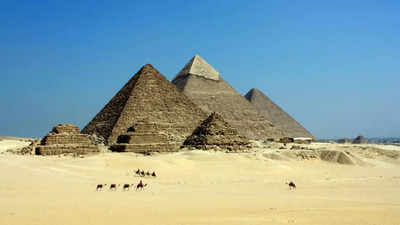
Save emergency contacts for swift responses
Use international debit/credit cards or forex card for easy payments, convert currency before your trip, apps to download for your norway trip, local guide apps:.
- Egypt Travel Guide: Offers travel guides, maps, and information on attractions, accommodations, and activities in Egypt.
- Cairo City Guide: Provides information on attractions, restaurants, and events in Cairo, the capital city.
- Luxor Travel Guide: Offers guides and information on attractions, accommodations, and activities in Luxor, a popular tourist destination.
Public Transport:
Language and communication:.
- Google Translate: Useful for translating text, speech, and images to and from Arabic, the primary language in Egypt.
- Arabic Language Learning: Helps you learn basic Arabic phrases and vocabulary for better communication.
- Weather Egypt: Provides accurate weather forecasts for locations across Egypt, including detailed information on temperature, precipitation, and wind.
Outdoor Activities:
- Egypt Adventure: Offers guides and information on outdoor activities, including hiking, diving, and desert safaris.
- Red Sea Diving: Provides information on diving spots, dive centres, and underwater activities in the Red Sea region.

- Email address verified
- Facebook verified
- LinkedIn verified
About this trip
Millennial mummies, mouthwatering food and thousands of histories are waiting: welcome to Egypt! Get to know this ancient civilization and wonder at some of humanity’s most impressive monuments. Enjoy breathtaking views over the Nile, the oldest Pyramids of the world and stories of treason and love. Ready for the trip of a lifetime?
In an effort to make your trip a streamlined process, Maximum Impact Travel offers extensive online trainings in preparation for your trip. Once you secure your deposit, you will be invited to participate in a series of online courses that will have you ready for your journey. You can view these courses at your convenience.
What’s included
- Ground Transportation Ground transportation and domestic airfare in Egypt to and from scheduled destinations (does not include international airfare)
- Hotel Accommodations Double Occupancy OR Single Occupancy. Hotel upgrades available upon request. Additional fees will apply.
- Hotel Amenities WiFi, Spa, Bar, Restaurant, Room Service, Fitness Center, Swimming Pool, Meeting Rooms, Air Conditioning, Wheelchair Accessible
- Admission To Activities Admission to all planned itinerary activities are covered. Additional activities will be the responsibility of the client/guest.
What’s not included
- Passport The United States Postal Service offers passport services. Passportvisaexpress.com is another recommended provider.
- Visa You will need a valid Visa to enter. Please do not wait until the last minute to obtain your Visa. Some countries allow border-entry VISAS upon arrival. Passportvisaexpress.com is a VISA provider.
- Vaccinations & COVID-19 Yellow Fever vaccine is not required if traveling from the U.S. For latest Covid-19 info, visit https://travel.state.gov/content/travel/en/traveladvisories/COVID-19-Country-Specific-Information.html
- Travel Insurance Travel insurance is highly recommended. Trip deposits and payments are non-refundable. Therefore, it is prudent to protect your investment. Insurance options travelguard.com or insuremytrip.com
- Medical Travel Insurance Medical travel insurance is highly recommended & different from travel insurance. Your domestic medical policy may not cover an international medical emergency. travelguard.com or insuremytrip.com
- Gratuities Gratuities are not included but strongly encouraged
- Beverages Beverages are not included with your meal. All of your beverages will be at an additional charge, this includes water, soda, juice, alcohol, etc.
Available Packages
International airfare NOT included. Round trip Egypt domestic included.
Stay at 5* Deluxe Hotel/Cruise : Conrad Cairo Hotel (or comparable) (deluxe partial Nile view) and Movenpick Royal Lotus Nile Cruise (cabin)
What’s included in the tour:
- Meet and greet service by our representatives at all airports
- Assistance during your stay
- All transfers in a modern air-conditioned vehicle
- Domestic flight ticket Cairo to Luxor and Aswan to Cairo - Economy class
- Abu Simbel tour by land
- Accommodation for 4 nights in Cairo, including room, breakfast and dinner
- Accommodation for 4 nights on 05 star Nile Cruise based on full board ( 3 Meals: Breakfast , Lunch & Dinner Open Buffet )
- All sightseeing in Cairo and Nile Cruise as mentioned in the itinerary are private tours (1 Tour guide per Bus )
- Lunch meals in Cairo at good quality restaurant
- Private English-speaking guide in Cairo
- Entrance fees to all sites as indicated on the itinerary (optional activities not included)
- 2 water Bottles in the Coach for every Tour
- All admission fees as mentioned above
- Portage when needed at airports
- All service charges and taxes
Not included :
- International airfare
- Entry visa to Egypt
- Personal spending during the trip (all beverages during meals, laundry, phone calls, etc.)
- Optional activities (visit to the inside of the pyramids, Tutankhamun’s tomb entry, others as indicated below)
ADDITIONAL INFO
VISA : Egypt entry visa for American citizens holding an ordinary passport is US$25 per person. Our team will contact you if this amount changes.
INSURANCE : We strongly advise all travelers to purchase international health insurance that would cover treatment for Covid-19.
FEES FOR OPTIONAL ACTIVITIES
Great Pyramid of Cheops entry fee: US$35 per person
Tutankhamun Tomb at Valley of the Kings entry fee : US$30 per person
Day 3 Culture Tour in Luxor : US$55 per person
Day 4 optional Hot air Balloon tour : US$140 per person
Quad Bike around the pyramids: US$75 per person for 1 hr
Camel ride around the pyramids: 30 minutes, US$50 per person
40% off double occupancy rate. For children ages 5 through 11 accompanied by an adult. If a child is below the age of 12 at the time of registration and reaches their 12th birthday before or during the trip, the child will not be eligible to participate in the child discount rate. Any child who has reached their 12th birthday by the start of the trip will have their account adjusted to reflect the accurate adult rate.
Available options
Your Egyptian adventures start as soon as you get to Cairo International airport. Your tour manager will escort you to your hotel in an air-conditioned vehicle. Once at your accommodation, they’ll help you check-in and review your itinerary. You’ll confirm pick-up times for the daily tours and have the rest of the day to wind down. Overnight in Cairo.
Hotel Amenities:
WiFi, Spa, Bar, Restaurant, Room Service, Fitness Center, Swimming Pool, Meeting Rooms, Air Conditioning, Wheelchair Accessible
Meals : Dinner, beverages not included.
Have a filling breakfast at your Cairo hotel and meet at 8AM to go to the Giza Plateau. Visit one of the seven wonders of the Ancient World: the Giza Pyramid Complex is vibrant with history and magic. Wonder at the Great Pyramid of Cheops, Pyramid of Chepren and the Pyramid of Menkaure with its valley temple, and overlook the valley by the Great Sphinx. You’ll have the chance to explores these amazing structures from within ( optional activity ) and later enjoy a scrumptious lunch at a good quality local restaurant. After a day of amazing views, we’ll go back to the hotel where you’ll spend the night.
Meals : Breakfast, Lunch and Dinner, beverages not included.
Today you’ll have an early hotel check-out at 4:30AM and go on a private shuttle to the Cairo airport to hop on a flight to Luxor. This mythical city has been the home of Emperors and Pharaohs for thousands of years! Here, you’ll explore the amazing Karnak Temple Complex, full of intricate sandstone columns, colossal statues and native palm trees. We’ll board our Egypt Nile cruise and enjoy a delicious lunch on board, overlooking the longest river in the world.
Meals: Breakfast box, lunch, dinner, beverages not included.
After breakfast overlooking the Nile, you’ll go on an excursion to the mythical Valley of the Kings. This impressive monumental complex is the eternal resting place of 62 ancient Pharaohs and hundreds powerful nobles of Ancient Egypt. Visit the mortuary Temple of Queen Hatshepsut built in 1500 BCE: this masterpiece of ancient architecture is full of altars, shrines and halls waiting to be explored. Afterwards, we’ll head to the Colossi of Memnon to find these two statues guarding the city. As an optional activity, you can also visit Tutankhamun’s tomb ( entrance fee not included ). After lunch we’ll sail via Edfu, enjoying a leisurely dinner on the cruise where we’ll spend the night
Meals : Breakfast, Lunch, Dinner, beverages not included.
After breakfast on the cruise, we’ll visit the Temple of Edfu. This well-preserved monument from the Ptolemaic Kingdom was dedicated to Horus, the falcon-headed God. After some exploring, we’ll sail to Kom Ombo to get to know the unique Temple of Sobek, where ancient Egyptians honored both Sobek and Horus.
After exploring the secrets of these mythical places, we’ll hop on the cruise again to continue our journey to Aswan. A delicious dinner will be served on board.
Meals : Breakfast, Lunch, Dinner, beverages not included.
After breakfast on Nile cruise, enjoy a day’s sightseeing in Aswan. Start with the High Dam and the largest known ancient obelisk, located in the northern region of the stone quarries of ancient Egypt, the Unfinished Obelisk, proceeding to the beautiful Temple of Philae, which is devoted to the two goddesses Isis and Hathor.Also, a visit to the Nubian Museum and the Nubian Village (the other side of Movenpick are included). Dinner and overnight on board deluxe Nile Cruise.
Meals: Breakfast, Lunch, Dinner, beverages not included.
After breakfast, we’ll say goodbye to the Nile Cruise and go on a day trip to Abu Simbel by land. You’ll take a private shuttle with AC that will take you to Abu Simbel, where we’ll explore the Great Temple of Ramses II and the small Temple of Hathor and Nefertari. These ancient structures have an amazing history: discovered in 1813, the UNESCO and the Egyptian government moved them in the 1960s to keep them safe from the construction of a dam. Wonder at these amazing monuments and explore the life of Ramses II and his favorite wife Queen Nefertari. After the visit you’ll take the shuttle back to Aswan and transfer to the airport to take a flight to Cairo. Overnight in Cairo.
After a hearty breakfast at the hotel in Cairo, you’ll meet your guide at 9:30AM to take you to the Egyptian museum. Explore the oldest archaeological museum in the Middle East and wonder at the largest collection of Pharaonic antiquities in the world. After touring the museum, we’ll enjoy a hot lunch at a good quality local restaurant. Spend the afternoon winding down at the hotel where you’ll have dinner. Overnight in Cairo.
It's time to say goodbye to your Egyptian adventure. You will be taken to the airport for your departure. Thank you and we look forward to seeing you again on another Maximum Impact experience.
Meals: Breakfast, beverages not included.
Your Organizer
Photo Gallery
trending now

Taylor Swift parties with Travis Kelce, Mahomes couple in Vegas...

Ashlyn Harris and girlfriend Sophia Bush attend White House...

Jon Bon Jovi's wife, Dorothea Hurley, skips doc screening after...

Lady Gaga cancels sister's bachelorette party at LES club The Box...

Inside Ankur Jain, Erika Hammond’s wild Egypt wedding: Private...

Jon Bon Jovi says 'every day is a challenge' with Dorothea Hurley...

Paris Hilton shares adorable first photos of daughter after...

The 2024 White House Correspondents' Dinner: Scarlett Johansson,...
- Click to share on Facebook (Opens in new window)
- Click to share on Twitter (Opens in new window)
- Click to email a link to a friend (Opens in new window)
- Click to copy URL
Inside billionaire Ankur Jain, Erika Hammond’s wild Egypt wedding: Private jets, pyramids and celebs
- View Author Archive
- Get author RSS feed
Thanks for contacting us. We've received your submission.

Billionaire Ankur Jain and former WWE wrestler Erika Hammond tied the knot Friday in an over-the-top ceremony that took place in front of the Great Pyramids in Egypt.
“We’re New Yorkers and there’s something so special about being in a completely different world environment,” Jain, the founder and CEO of the cashback tech company Bilt Rewards, told People following their nuptials.
“So we decided, our wedding is about having a moment together to celebrate the new beginning, having a really special party with our friends somewhere where you’re in a different world.” (Jain had originally suggested getting married in space, but Hammond was not keen on the idea.)

While the location of their wedding was unique, it wasn’t the only unorthodox detail about their celebrations: The couple had no bridal party, no wedding cake — although they did serve a birthday cake from Milk Bar — and seemingly left most of the planning process up to their coordinators.
“I had no idea what the napkins looked like or what the table setting looked like,” Hammond, 32, told People.
Jain, 34, added, “We’re not traditional wedding people. Why do you have to spend $20,000 on flowers? It doesn’t make sense.”
The one detail they were certainly involved in was the transportation of their wedding guests from the safari they brought them on in Africa back to Cairo for their ceremony.
Want more celebrity and pop culture news?
Start your day with Page Six Daily.
Thanks for signing up!
Please provide a valid email address.
By clicking above you agree to the Terms of Use and Privacy Policy .
Want celebrity news as it breaks? Hooked on Housewives?

Ahead of their welcome party, their private Egypt Air flight was halted by the South African government, leaving them in a huge bind. After the bride and groom stayed up hours trying to get their guests to Egypt, they eventually pulled it off — but it made their welcome event kick off three hours late.
“We partied until 5 a.m. having just the best opening night,” Jain recalled to People April 25. The event, which was held at the Muhammed Ali Palace, had a “Modern Cairo” theme and featured belly and fire dancers.
For more Page Six you love…
- Listen to our weekly “We Hear” podcast
- Shop our exclusive merch
Jain and Hammond’s 130-person guest list was impressive as well. Some of the biggest celebrities celebrated their love, including Lance Bass and his husband, Michael Turchin, Robin Thicke and his wife, April Love Geary, “Shark Tank” investor Kevin O’Leary and his wife, Linda, influencer Serena Kerrigan, several politicians and prominent businesspeople.
Thicke, 47, surprised guests with a performance, while Bass, 44, gave an impromptu show of “Bye, Bye, Bye” near the end of the night after a stunning fireworks show over the pyramids.

“We had the best time. It was so special,” Jain gushed to the outlet. “When the fireworks went off, it was one of the most spectacular moments. I was so emotional, I couldn’t even put it into words.”
The newlyweds met at Rumble Boxing, where Hammond is a founding member. She was also an instructor there when they first interacted.
A few years later, they hit it off and got engaged in November 2022.
Share this article:

Advertisement

Taco Relish
Incredible Discoveries Inside The Pyramids Of Egypt
Posted: April 26, 2024 | Last updated: April 27, 2024
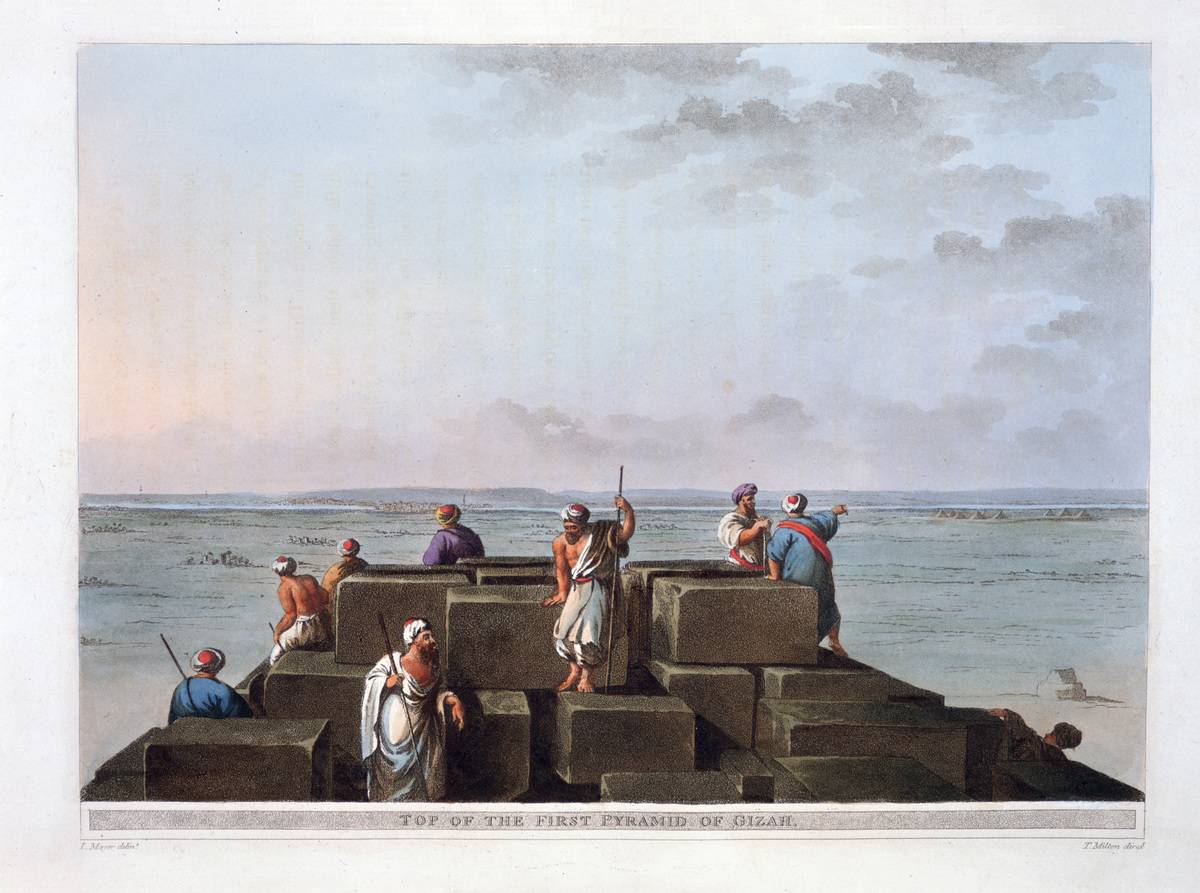
As one of the most mysterious wonders of the world and centuries of research, we still don't know how exactly the pyramids were built. Archaeologists have narrowed down some of the techniques used to build the pyramids, but every day uncovers a new mystery about these gigantic burial sites.
We barely understand the tunnels in the pyramids, but what other secrets lay beneath the stones? Keep reading to learn some of the incredible discoveries uncovered at the ancient pyramids of Giza – the only one of the Seven Wonders of the Ancient World that survived.
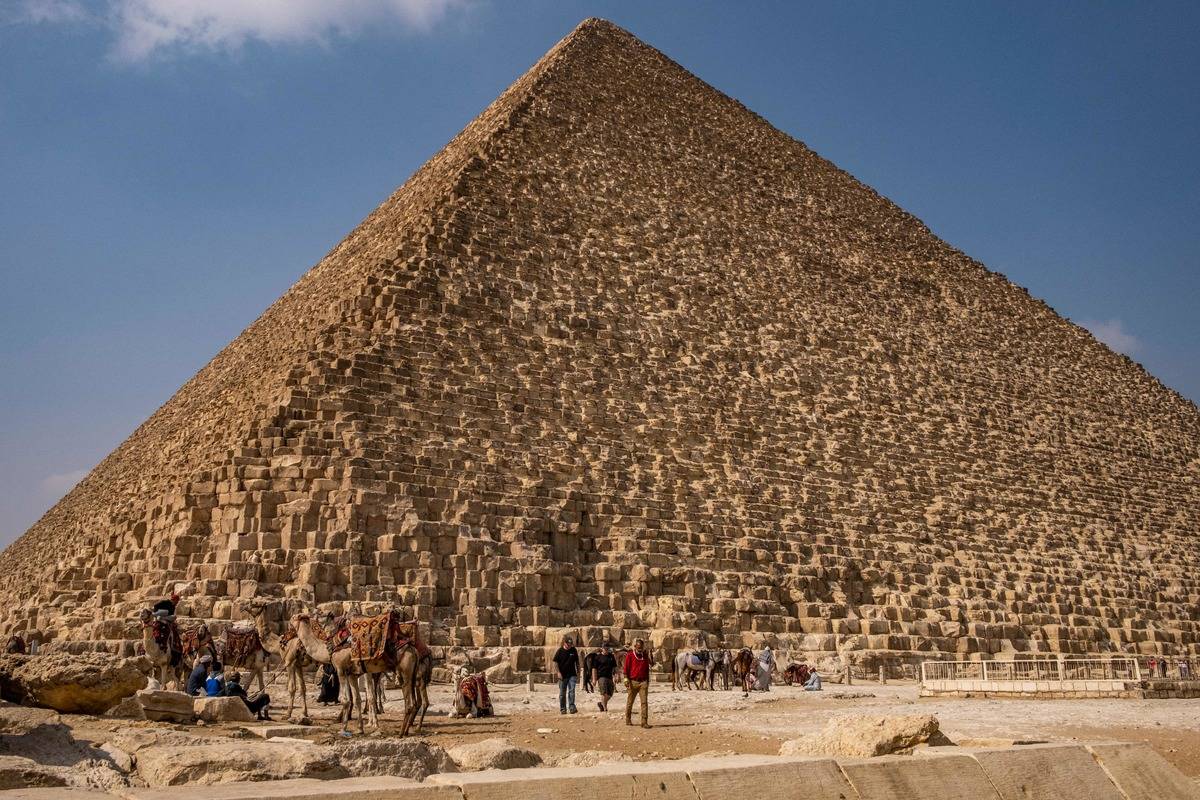
Agreed Upon That The Largest Pyramid Was Built Over Two Decades By 20,000 People
For centuries, the Great Pyramid, which was thought to be built around 2550 BC by Pharaoh Khufu, was the largest structure in the world. Our historical findings teach us that Egyptians used only wooden implements along with ropes and pulleys.
This wasn't easy. In fact, it's so astounding scientists aren't even sure how it could be possible. It's estimated that 20,000 workers built the Great Pyramid over a period of 20 years.
Built Before The Invention Of The Wheel
Scientists believe the pyramids were built with huge granite and limestone blocks that were dragged up to 500 miles. Some of them came from the Nile. That's pretty far considering these stones weighed 2.5 to 15 tons. The average car is just over two tons.
So, how does one drag a stone the weight of a car over sand and across 500 miles? Well, certainly not with a wheel. By the time ancient Egypt picked up breaking technology that was the wheel, the pyramids were ancient. Oh yea, they also didn't have steel or iron -- just wood and stone.

The Great Pyramid Actually Has Eight Sides – Not Four
Most of us think of the Great Pyramid as a typical four-sided pyramid. It certainly looks that way from the ground, but hop on a plane and your perspective may shift. The Great Pyramid of Giza has eight sides, and it's only visible from an aerial view. Some people believe this was a way to keep the casing stones from shifting.
Others think erosion created the eight sides and that the pyramid truly is supposed to have just four. Either way, this indent is impressively precise – it's indented by one degree of a half degree. Could the wind really have made that?

20 Ton Doors You Could Move With A Single Push
Not many of us could push open a 20-ton door, but the ancient pyramids of Giza were so perfectly balanced that you actually would have been able to if you were stuck inside. Some pyramids were equipped with these massive doors, which were completely hidden from the outside.
From the inside, you could push them open with minimal force – even a single hand. These doors were only discovered once the Great Pyramid was first being explored, and no one knows how the ancient Egyptians would have been able to cut, place and balance these doors so precisely that they'd actually work.
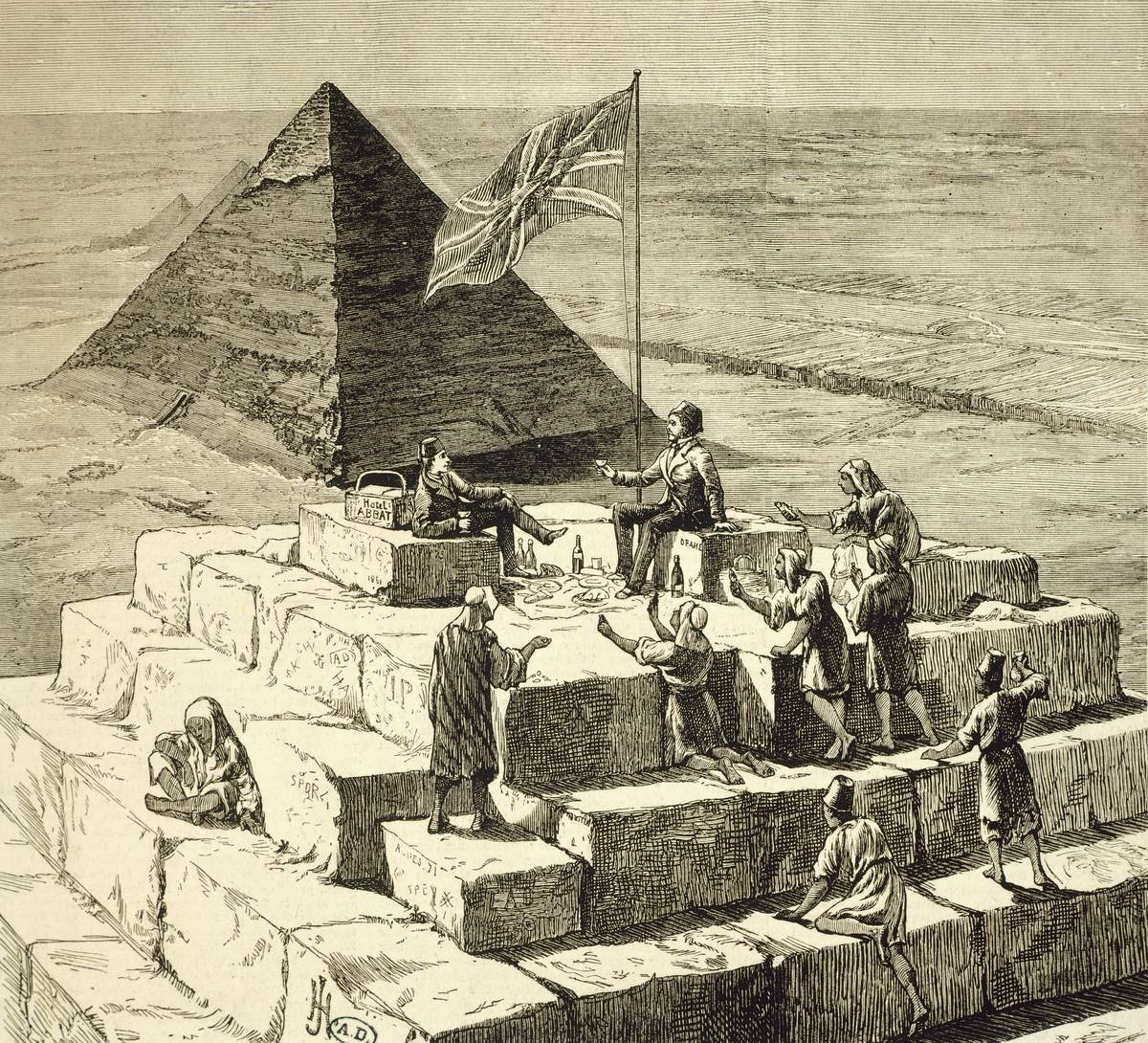
Created By A Civilization Older And More Advanced Than The Egyptians
Despite the belief that the Egyptians created the pyramids with wood and ropes, scientists haven't been able to recreate exactly how the pyramids were made. According to what we know about history, the Egyptians simply didn't have tools that could create something so large and precise. In fact, scientists attempted to recreate the pyramids in small-scale models but failed every time.
The truth is that the Great Pyramid was made from 2.3 million stone blocks that each weight 2.5 to 15 tons. No type of wood could withstand the weight of the stones, and the workers would have had to lay down a block every 2.5 minutes for the Pyramid to have been built in 20 years as originally thought. For this reason, some scientists believe that the Pyramids actually predate the Egyptians and were created by a much more advanced society.
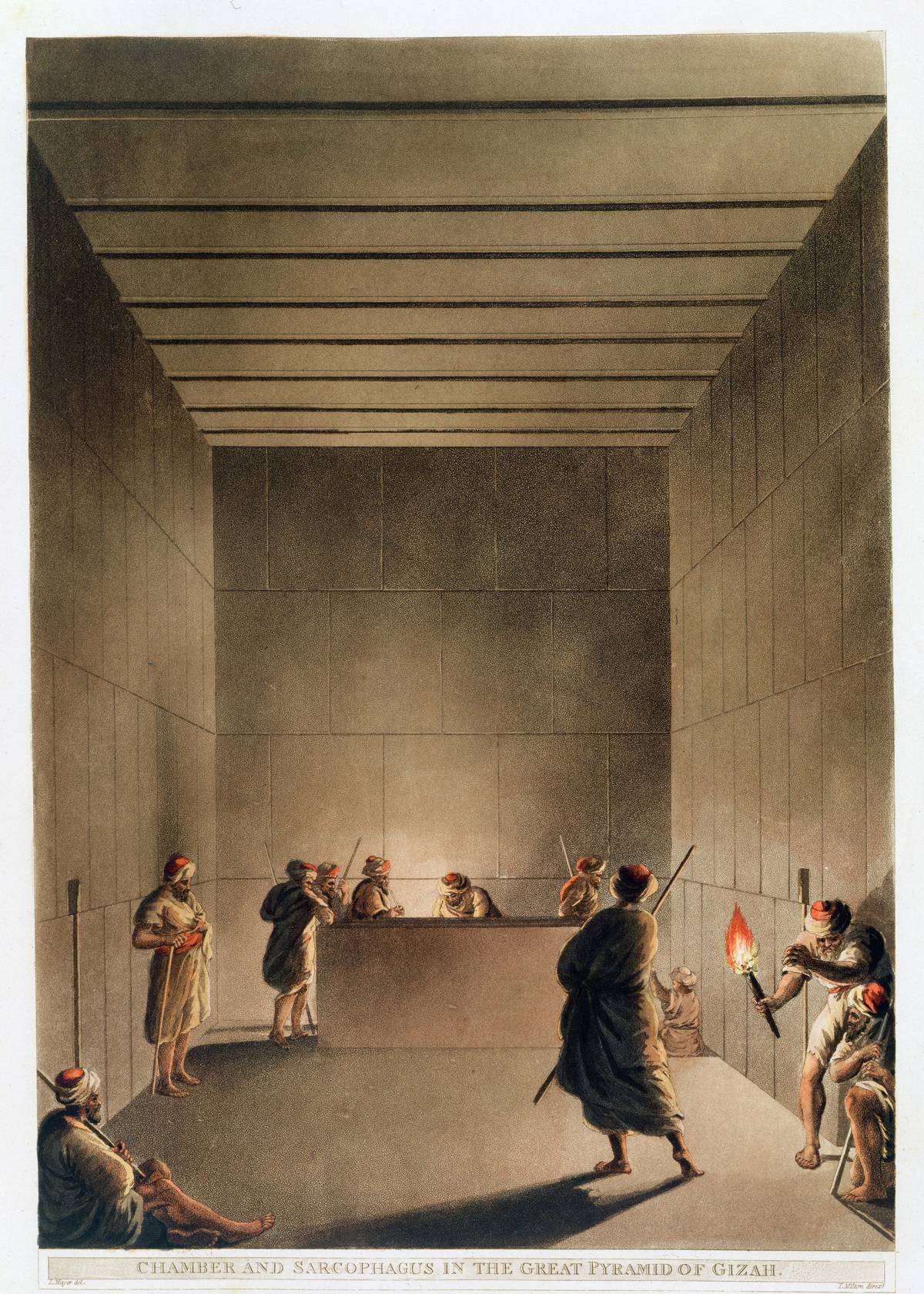
Evidence Of Drills Strong Enough To Penetrate Granite Were Found In Khufu's Sarcophagus
Khufu, who allegedly created the Great Pyramid, had a pretty eyebrow-raising coffin. It basically baffled scientists when it was discovered. The sarcophagus weighed about 3.75 tons – too large and heavy to have been brought into the pyramid after it was built. It had to have been placed there beforehand.
Then there's the whole thing about it being carved entirely from a solid piece of granite. If you don't know, granite is pretty tough and the sarcophagus has holes in it that look like they were drilled into the stone. What primitive drill would have been strong enough to cut into granite? Certainly, a wooden pickax would've failed.
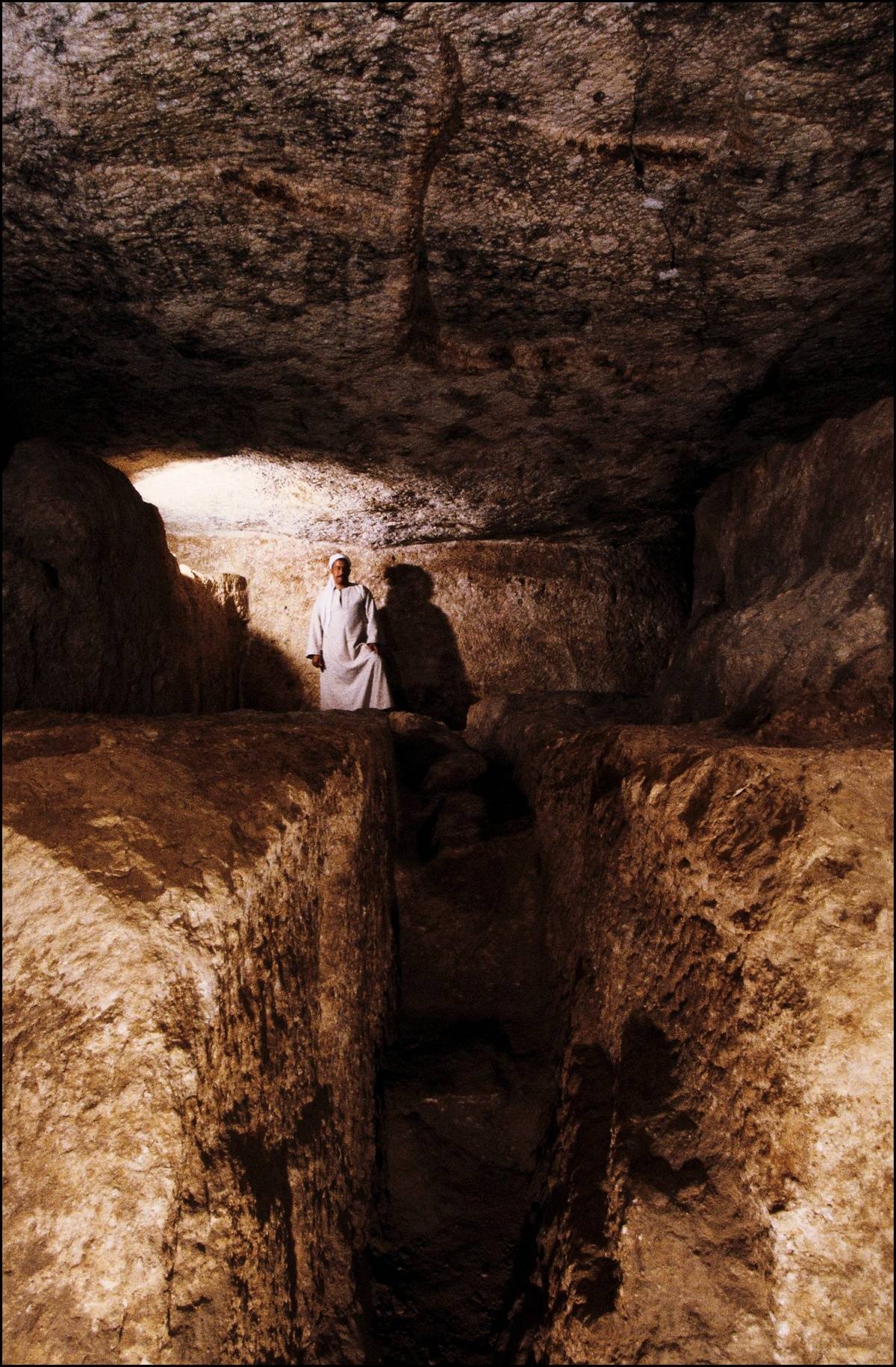
There's A Labyrinth Beneath The Pyramids That Could Be Greater Than We Think
The Pyramids are equipped with an intricate tunnel system that's carved from limestone bedrock. It's in these tunnels that the most unbelievable discoveries are made. Man still hasn't scaled every corner of the twisting labyrinths – and even so, when a discovery is made, scientists are often bewildered.
Theorists believe mainstream scholars and scientists are hiding an underworld of lost catacombs beneath the pyramids. We have evidence of labyrinths beneath the Great Pyramid, but some people believe there's a whole lot more— about 55 miles south of Cairo underneath the city of Hawara. This is alluded to in various ancient texts and described by authors like Herodotus and Strabo.
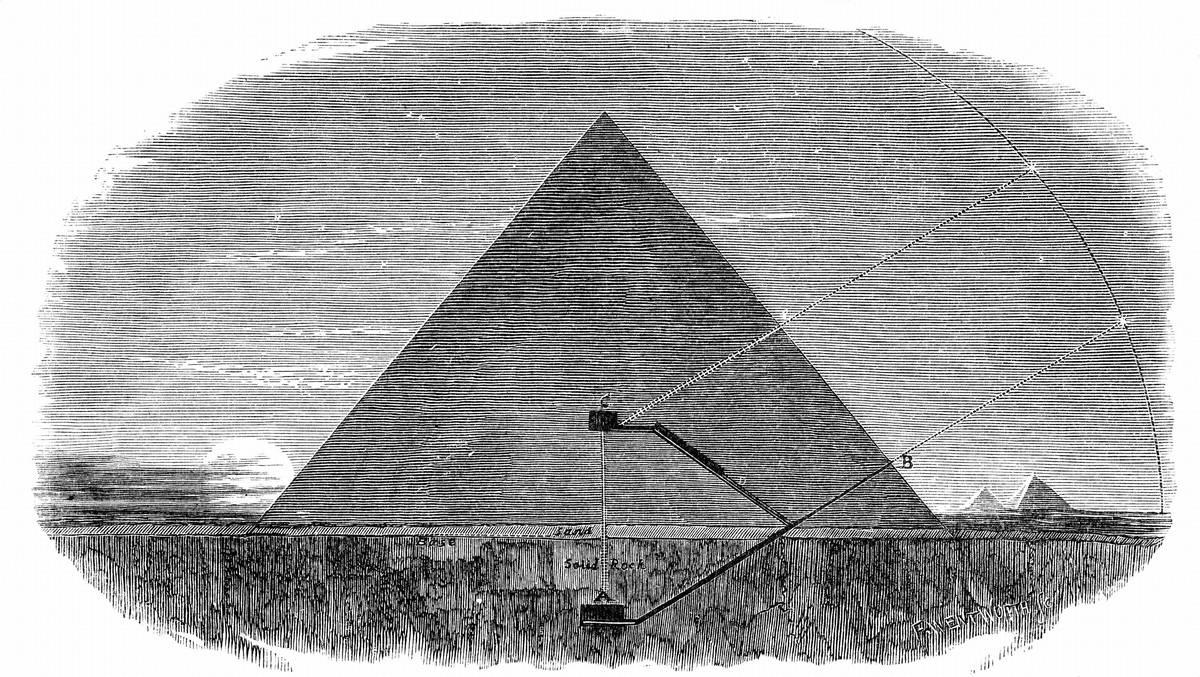
There's A Giant, Mysterious Hidden Chamber Inside The Great Pyramid – But No One Knows Why
Recently, scientists discovered a brand new chamber in the Great Pyramid. To do this, they used cosmic-ray imaging, which recorded the behavior of subatomic particles that were shot into the rock. It's almost like an X-Ray, but it can penetrate much deeper. Unfortunately, the images are rather low-resolution, so scientists who found the chamber can't tell if it's a single chamber or a series of different rooms.
Either way, it's pretty mysterious and no one knows exactly what the chamber would have been for. It's commonly accepted that cavities were built into the pyramids to relieve stress on the stone and prevent them from collapsing, but many of these chambers also held an alternative purpose.
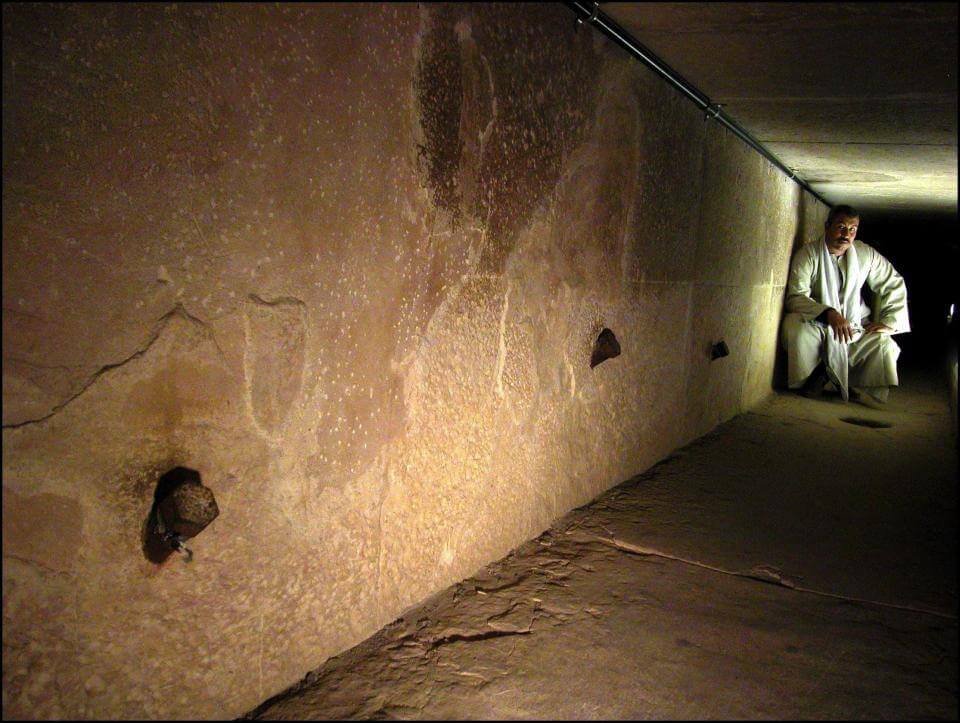
Scientists Believe The Hidden Chamber Is Capable of Creating Pocker Of Higher Energy
For centuries, many have speculated that the ancient Egyptian pyramids hold a higher energy. Now, scientists believe they may have some clues. After discovering the hidden chamber within the Great Pyramid, scientists conducted a study that found that the pyramid concentrates electromagnetic energy in its internal rooms.
Furthermore, they have discovered that the 481-foot building concentrates this electromagnetic energy in its hidden chambers. The higher energy has been found in the rooms that contain the remains of Pharoah Khufu and his wife as well as another chamber that was previously hidden.
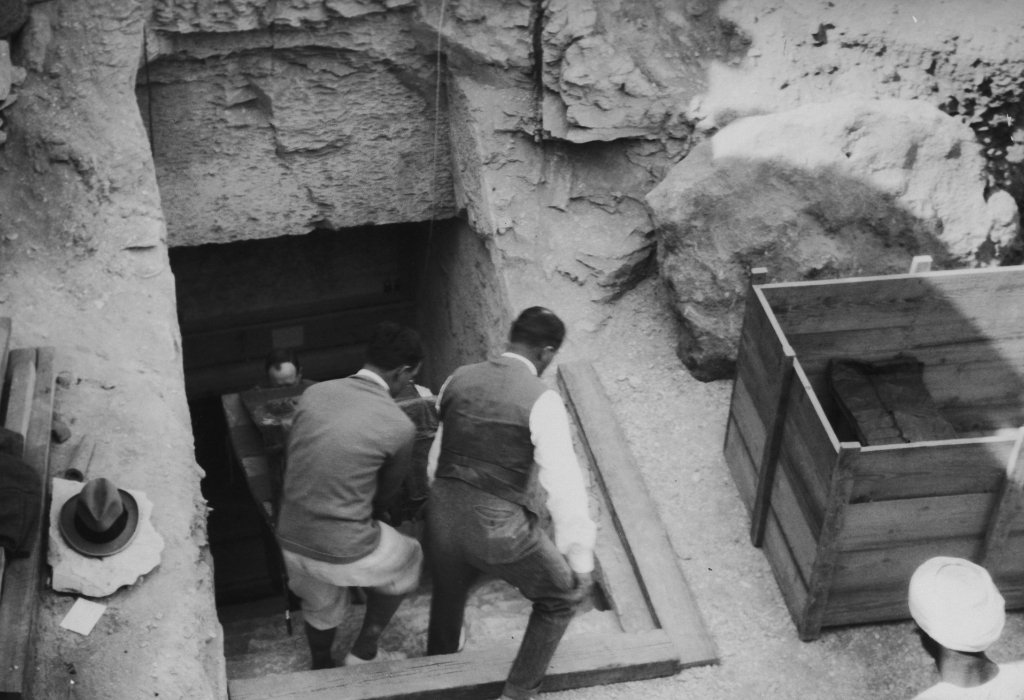
King Tut's Tomb Was Discovered in 1922
King Tut is arguably the most famous of all Egypt's pharaohs. This is largely thanks to his elaborate tomb, which British archaeologist Howard Carter discovered in 1922. The entrance to Tutankhamen's tomb is located in the Valley of the Kings and had been concealed by debris.
When the entrance was discovered more than 3,000 years later by Carter and his fellow archaeologist, George Herbert, they couldn't believe what they found. Inside were grand paintings and excessive grave goods like perfumes, oils, jewelry, and statues. Three coffins were nestled inside each other, with the innermost coffin being made of gold and housing King Tut's mummy.
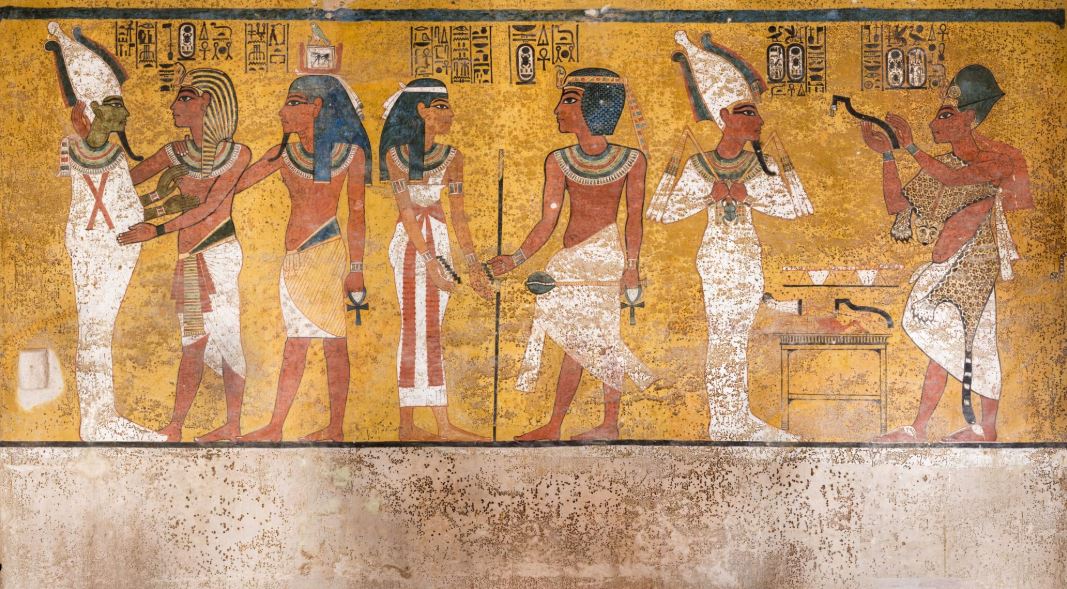
It Took Over a Decade to Restore King Tut’s Tomb
In 2009, restoration began on King Tut's tomb. On top of cleaning and restoring the paintings that line the interior walls of the tomb, the Getty Conservation Institute and the Egyptian Ministry of Antiques worked to combat the wear and tear caused by decades of tourist activity according to History .
The photo above shows the finished product of one of the interior walls that were cleaned. Altogether the conservation efforts took more than a decade.
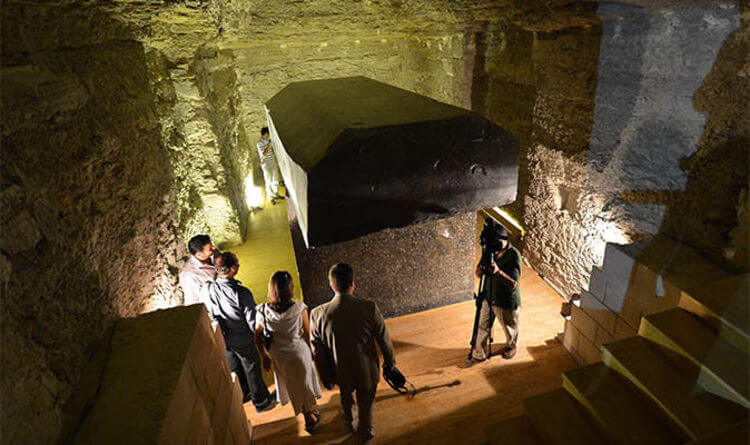
Mysterious 100 Ton Boxes Were Found In The Intricate Tunnel System Below The Pyramids
Recently, archaeologist Brien Foerster discovered 20 boxes that were precisely cut from Aswan granite. These boxes weighed a whopping 100 tons each (again, far greater than what a wood implement could have carried). The boxes were originally thought to be a burial place for prized bulls, except no evidence of bulls was actually found.
Some scientists believe these boxes held a mysterious, ancient form of energy. This idea is widely rejected by mainstream scholars – but when you get into it, it really makes you think.
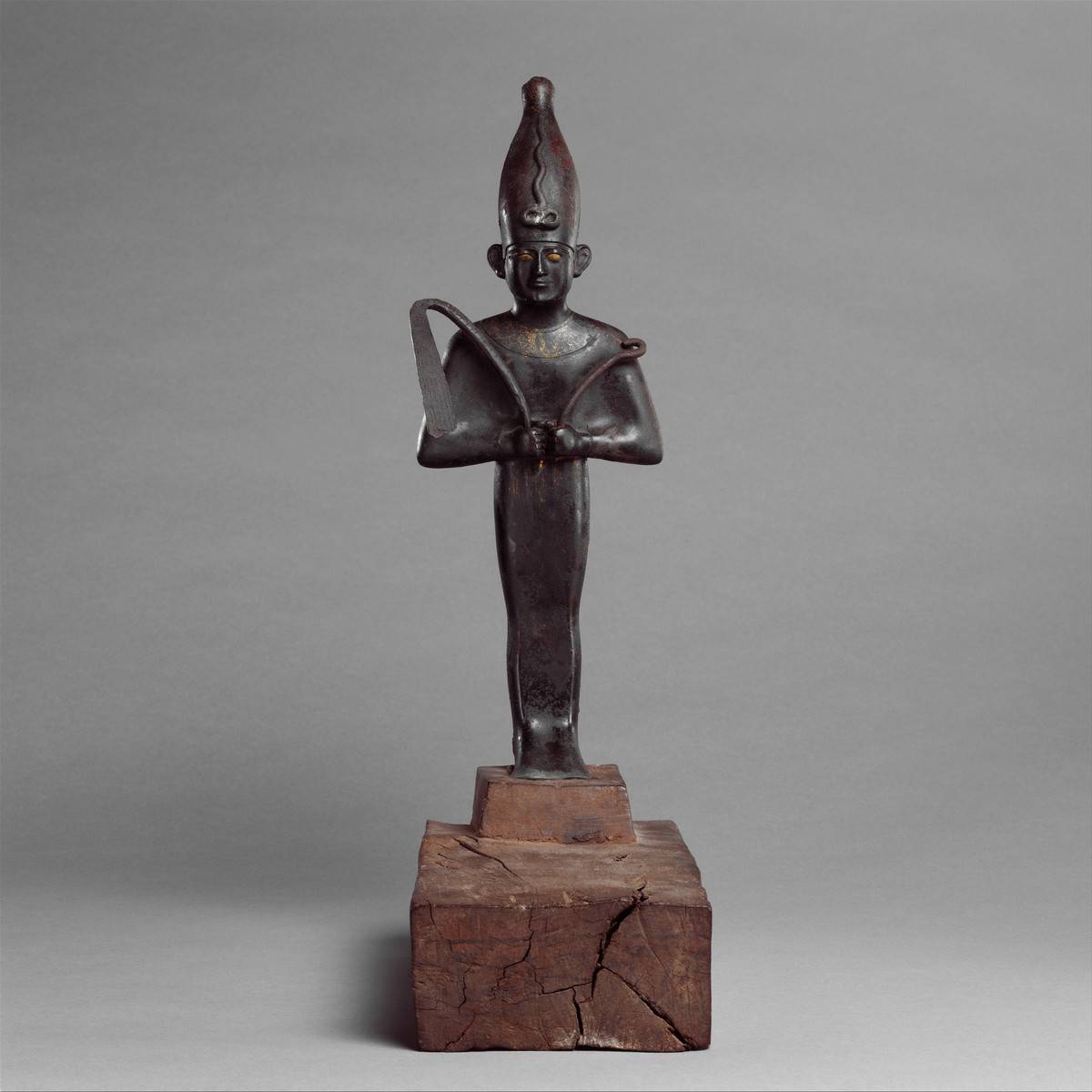
Archaeologists Baffled By Statue Discovered In Ancient Pyramid
On August 1, 2018, the head of the Supreme Council of Antiquities in Egypt announced that they had made an incredible new discovery in the pyramid of Djoser in Saqqara. During a restoration project, the team discovered a precious statue depicting one of the most important Egyptian Gods — Osiris.
This discovery has so far baffled archaeologists who are now wondering who placed a valuable figure into a hole within the pyramid and why. For now, the head of the Saqqara archaeological site is speculating that "the statue was probably concealed in this area by a priest of Saqqara in antiquity."

The Great Pyramid Didn't Actually Look Like It Does Now – It Was Shiny Like A Diamond
The Great Pyramid didn't really blend in with the dirt and sand that surrounds it – that’s actually the inner core. In its heyday, the Great Pyramid was actually really, really impressive. It was covered in white, polished limestone that would have made it shine and sparkle. Cuts were made throughout this limestone to give it a smooth, flat appearance in direct sunlight (which Egypt definitely has plenty of considering it's a desert).
The Great Pyramid was thought to have reflected the sun like a mirror – a jewel emerging from the sand -- but an earthquake in 1303 AD caused most of these stones to loosen. They were taken away and reused in mosques and fortresses, so all that's left in the inner shell that isn't shiny or smooth.
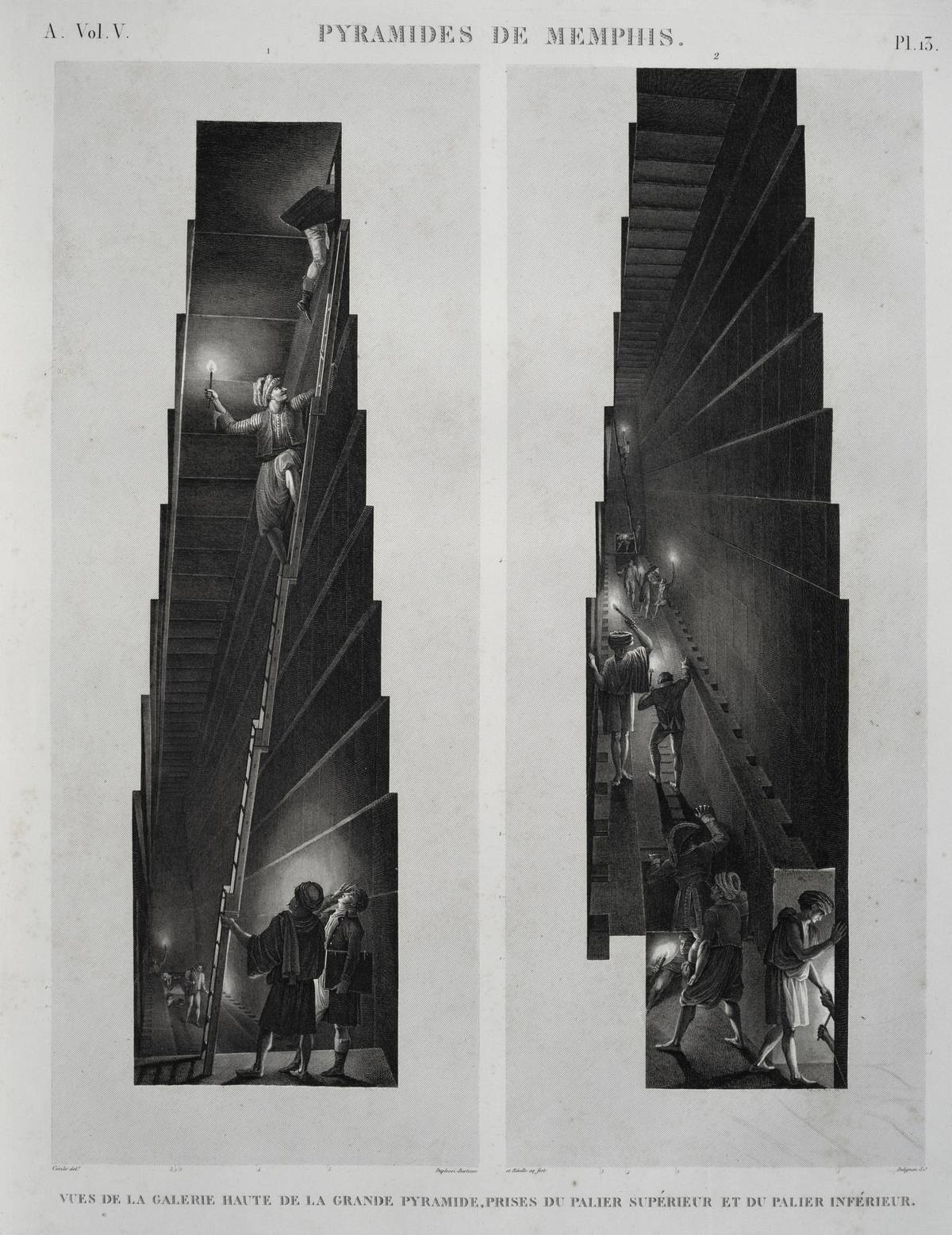
Theorists Believe The Great Pyramid Was A Power Plant And Egyptians Had Electricity
History tells us that Egyptians were not an advanced society and the Pyramids of Giza were simply grand burial grounds for pharaohs and kings. Still, scientists are still baffled at how a primitive society with primitive tools could have built something so grand – and what about all those patches of heat? Plot twist: what if ancient Egypt wasn't as primitive as we originally thought?
Some scholars believe that ancient Egypt had electricity, and there's evidence in carvings that showed ancient Egyptians holding handheld torches that appeared to be powered by wireless electricity. It's built on water and the water passing through the underground cavities in the Great Pyramid is capable of creating an electrical current if that energy could be harnessed. The shafts inside the Great Pyramid are crafted from granite and are slightly radioactive, which ionizes the air inside – it's similar to a conductive insulating cable. Other scientists think the shafts had a different purpose.
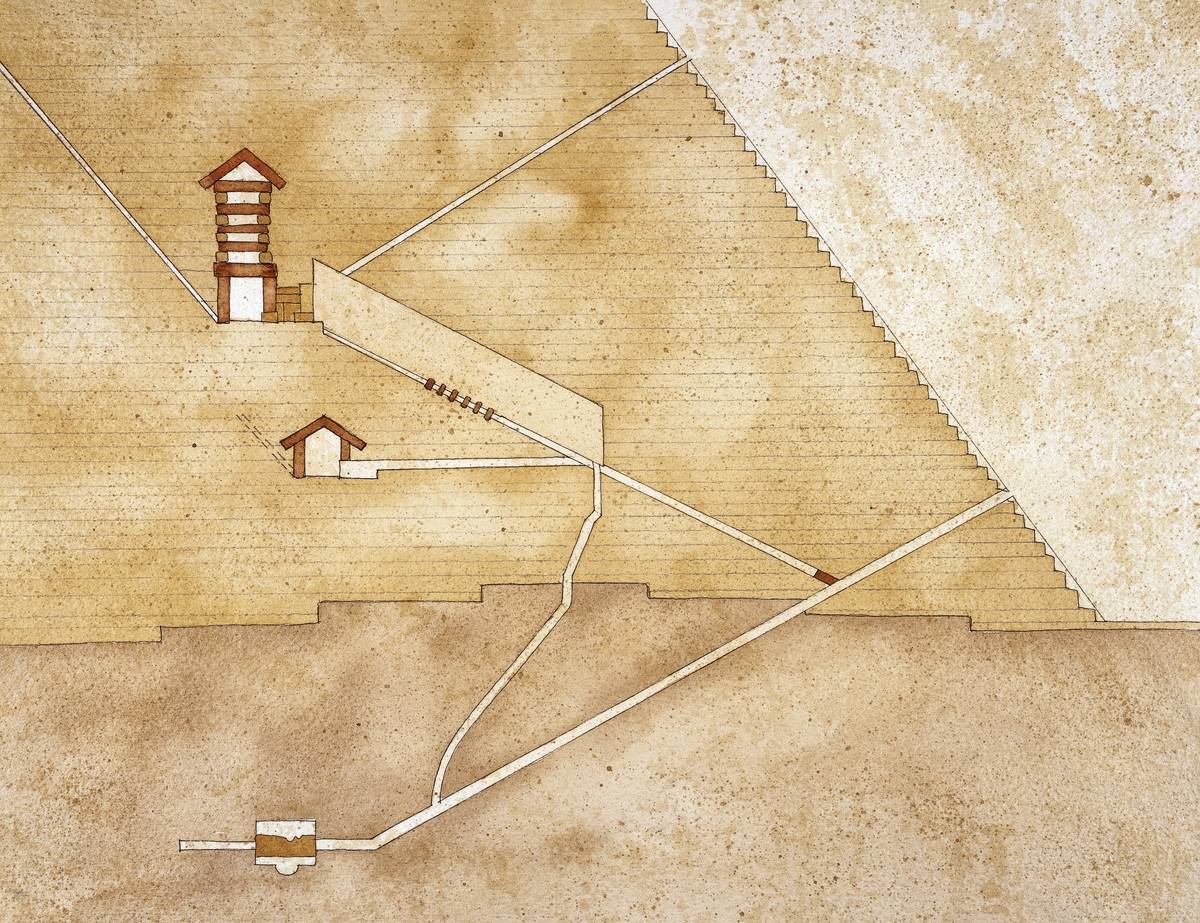
Only The Great Pyramid Was Built With Air Shafts And No One Knows Why
The Great Pyramid is the only one of the three pyramids of Giza that have air shafts. The angles of these shafts correspond with celestial bodies (yup, we're bringing astronomy and potential aliens into this). It's a complete mystery how the Egyptians could have lined the shafts up with the stars or why they would have even bothered in the first place.
Perhaps it had something to do with guiding a body to the afterlife, perhaps it had to do with signaling aliens up above (probably not), but not all of these shafts even reach the outside. Some are completely closed off, while others could arguably have been used for ventilation, which is the most commonly accepted theory. Unless, of course, you believe they were used to conduct energy.
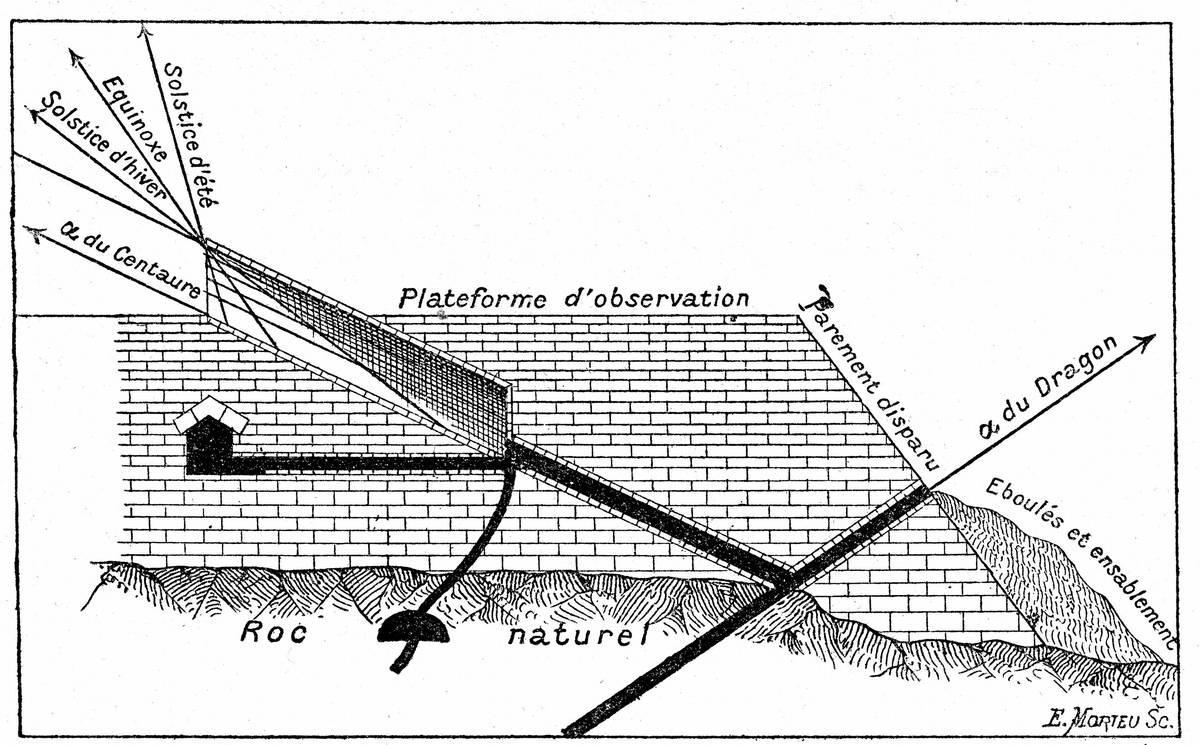
The New Chamber, Dubbed 'The Big Void,' Isn't Connected To Any Known Passages
The new chamber discovered in November has been dubbed the "big void" because it really is a void. The chamber isn't actually connected to any known passages inside the pyramid. Currently, visitors can actually get into the Grand Gallery if they hunch down and walk up a long tunnel. The Grand Gallery connects the Queen's chamber and the King's chamber.
That makes perfect sense for a giant burial ground, but where does that leave the big void? The giant cavity is at least 30 meters long and rests above the Grand Gallery, leading some scientists to think it possibly relieved weight on the Grand Gallery and prevented it from caving in. Either way, it's roughly the same size as the Grand Gallery, but right above it.

The Three Pyramids Are Lined Up With Orion's Belt
If things weren't weird enough, it's not just the shafts in the Great Pyramid that align with celestial bodies. Khufu, Khafre and Menkaure's pyramids are perfectly aligned with the stars that make up Orion's belt. Yes, those three, highly recognizable stars – Alnitak, Alnilam, and Mintaka. Why? No one knows.
Coincidentally, the pyramids are aligned at their southeast corners. How the heck did ancient Egyptians no only align these massive structures with each other but also with the sky? Again, no one knows. The idea of Orion's Belt wasn't invented until 2,000 years after the Pyramids were already built, but to Ancient Egyptians the constellation was associated with Osiris, God of Rebirth and the Afterlife.
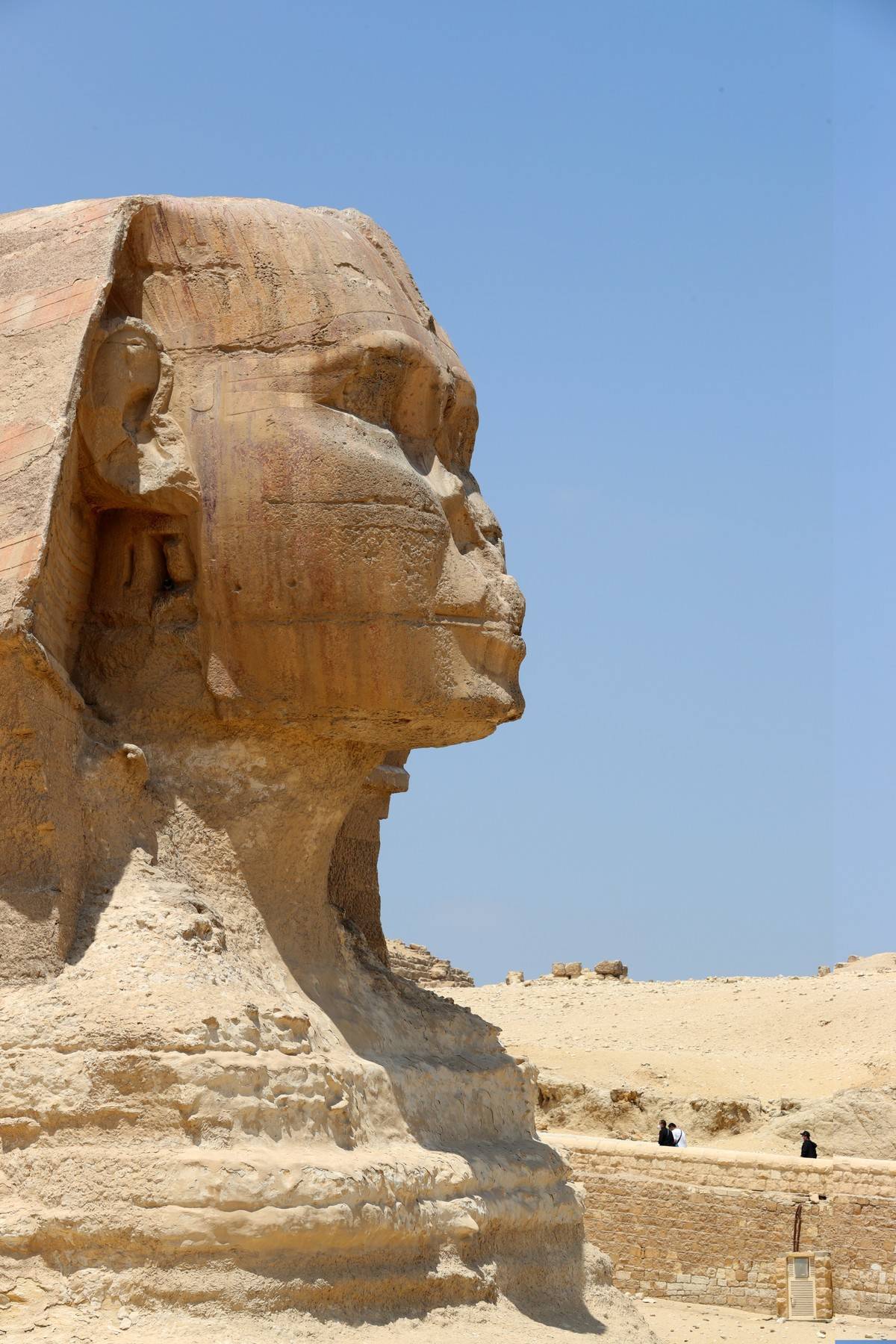
Many People Believe The Pyramids Helped Kings Ascend To The God Of The Sun
If you're not buying into the suspicion that the pyramids are alien structures or giant power plants, there's another more recognized idea. The pyramids were built to help kings ascend to Sun Ra, the God of the Sun. Back in ancient Egyptian times, Kings thought of themselves as deities living on Earth.
Upon death, they needed to get back home. This is why tombs were equipped with objects the king might need to use in his afterlife, like live animals, gold or whatever the heck is generating heat inside the Great Pyramid's lower chambers.
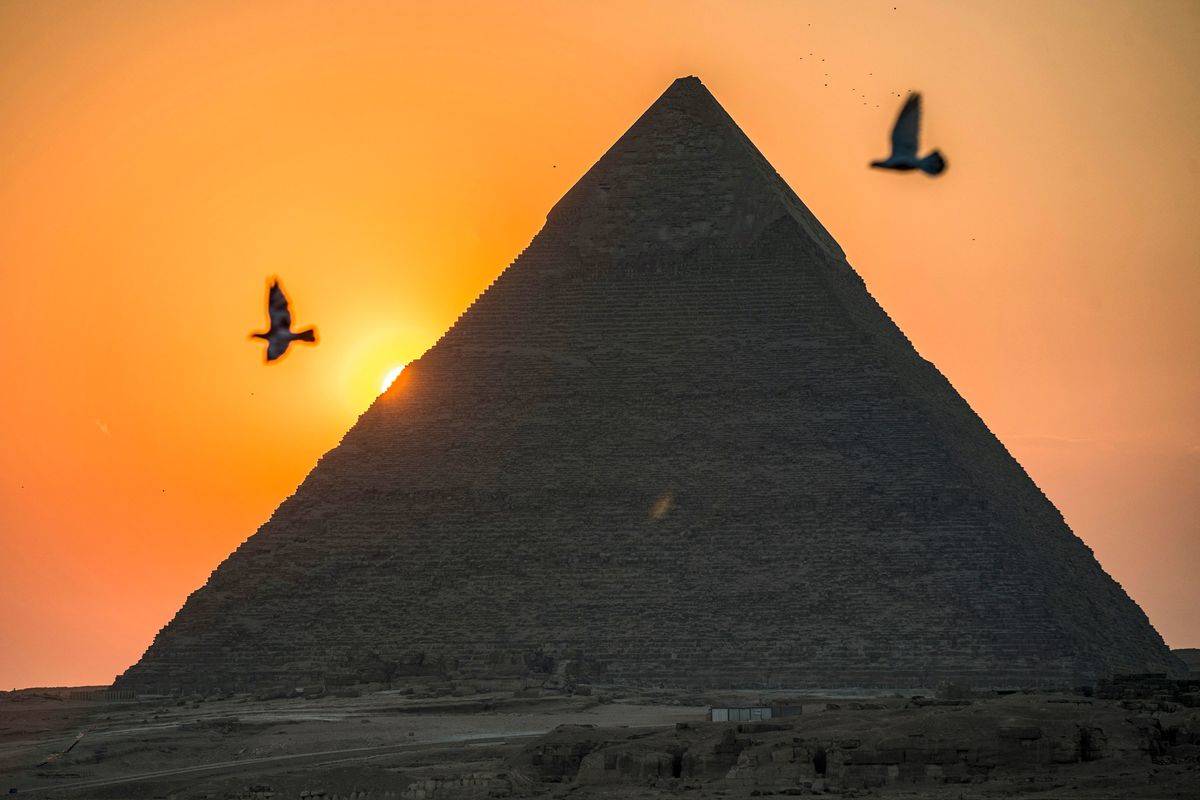
The Chambers Point North With Greater Precision Than The Royal Observatory, Greenwich
Could the ancient Egyptians have been more precise than our current civilization? The pyramids were found to point North, but not just in the general direction of North. It points North within five-hundredths of a degree to the true magnetic North. That's more precise than the Royal Observatory in Greenwich.
The Royal Observatory, Greenwich sets the actual clock to GTC (Greenwich Mean Time or Prime Meridian Time) and is a whopping 13 degrees away from true North. It was created in 1675. If they couldn't get true north just a few hundred years ago, what were the ancient Egyptians doing? How accurate were ancient Egyptian clocks compared to ours?
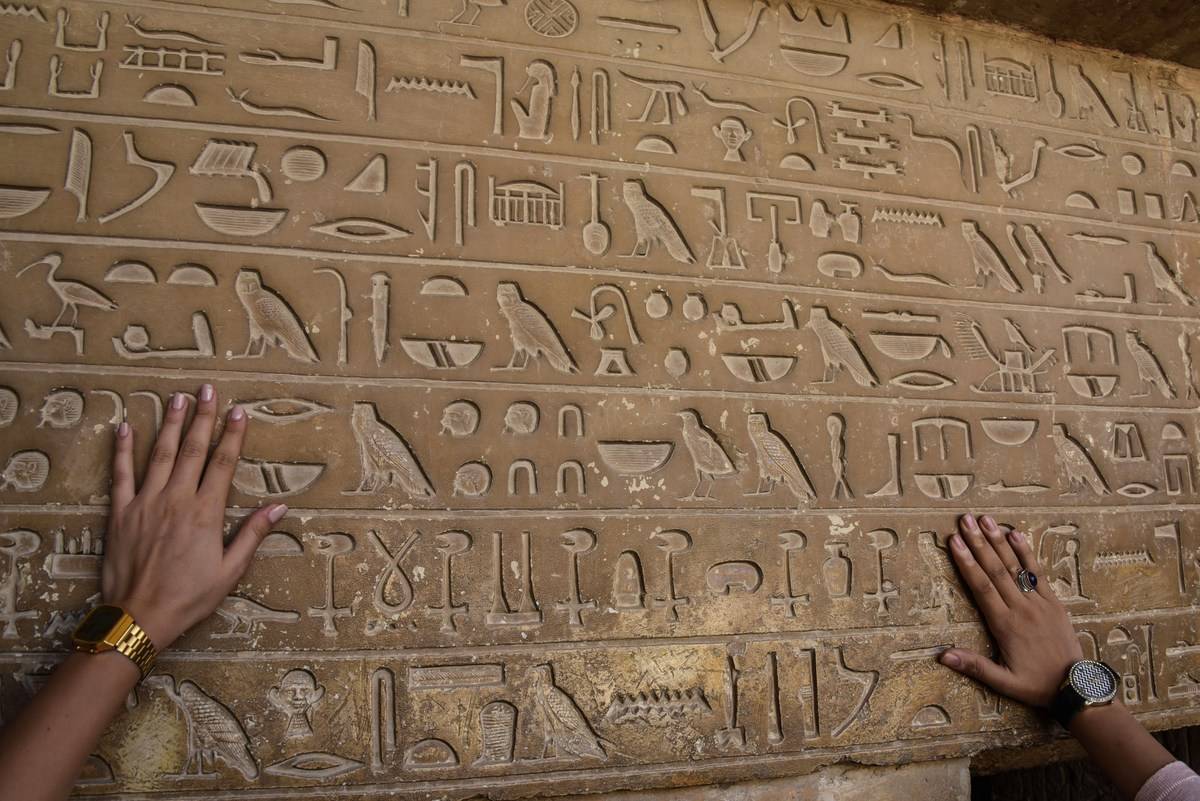
The Pyramids Show Knowledge Of Mathematical Constants
Here's where things get really weird (if they weren't already). If you subtract the Great Pyramid's length from its height, you get 314.16 – 100 times Pi. If you add the two sides together, in meters, it's 100 times Phi (a.k.a. the Golden Number) squared. Phi is 1.618 and is used time and time again in art, architecture, and theology.
Pi is a mathematical constant and it wasn't recognized until 1793 when we had modern measurements – but the ancient Egyptians totally were ahead of the times. Ancient Egyptians often measured in cubits. One cubit equals .0536 meters. The circumference of a circle that has the diameter of a single cubit equals Pi.
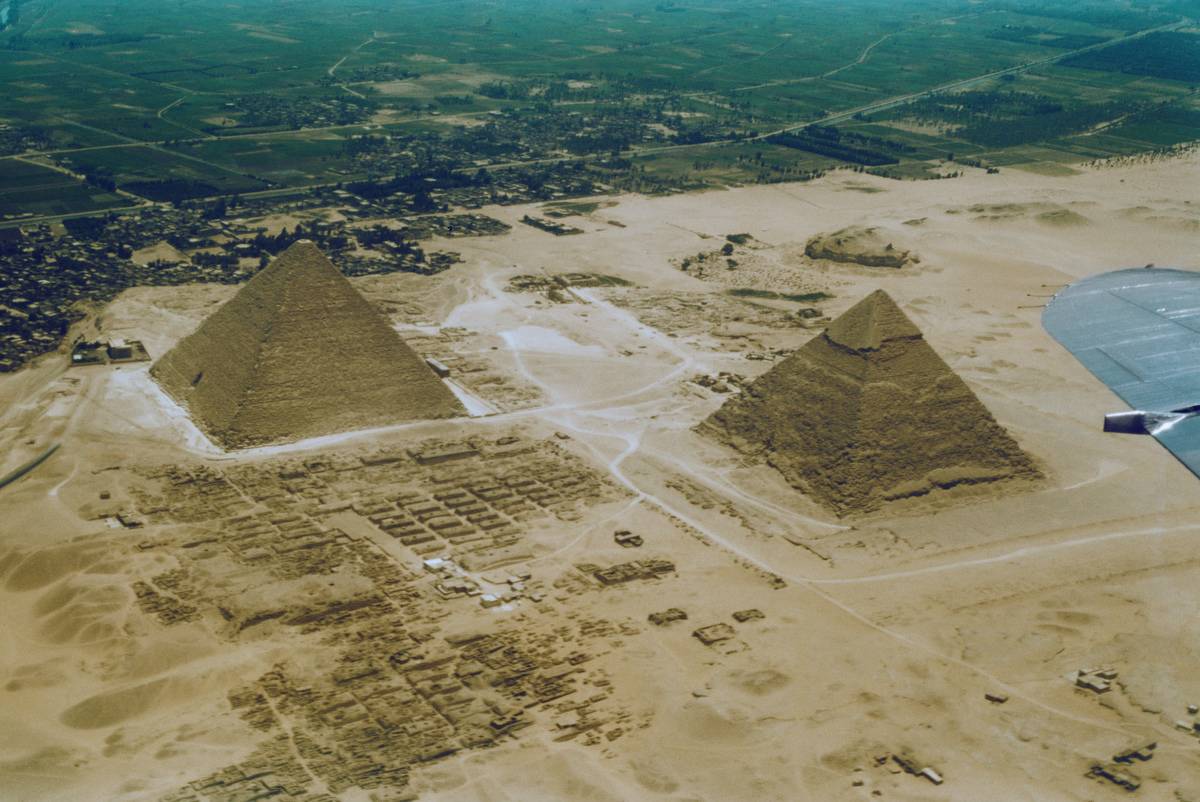
There Used To Be Numerous Structures And Buildings Around The Pyramids
Right now, it looks like the Pyramids of Giza stand alone in the desert, but they actually had many more side structures and buildings around them. The pyramids were definitely the main show, but they were surrounded by smaller tombs called Necropolis (or the City of the Dead).
There were other religious buildings around the pyramids like temples honoring the king, and the staff that took care of these various temples lived right next to them in even smaller buildings. Let's also not forget the Great Sphinx of Giza.

No One Knows Who Built The Sphinx Either
Just like pyramids, the Great Sphinx of Giza is a total mystery – maybe even more of a mystery than the pyramids. No one knows who actually built the Sphinx. Archaeologists are pretty split on who deserves the credit. Some believe that the Sphinx was commissioned by Khafre, who also created the second largest Pyramid, which would mean the statue was crafted around 2500 BCE. The Sphinx has some of his physical qualities, so maybe it was made in his likeness.
Other scholars think the Sphinx is older than Khafre and that it was commissioned by his father Khufu (that guy responsible for the biggest Pyramid). Some scholars even think the Sphinx is older than both of those because its face shows water damage. It's possible the statue was built in an era where Egypt saw a lot of rain (likely around 6000 BCE). The Sphinx and pyramids flooded every year before the building of the Aswan Dam.
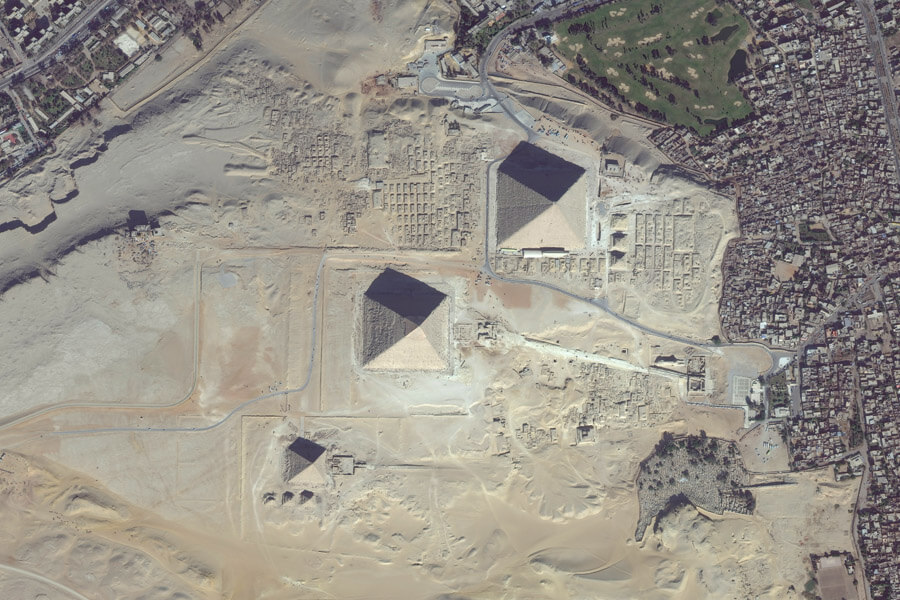
Using Satellites, Archaeologists Have Uncovered 17 More Pyramids
There are more than just tombs buried in Necropolis. Archaeologists are using satellites to search for hidden structures underneath the Earth. In Egypt, they found 17 new pyramids buried around Giza. The infra-red technology being used has also uncovered more than 1,000 burial sites hidden beneath the sands.
Sarah Parcak, an archaeologist funded by NASA said, "I couldn’t believe we could locate so many sites. To excavate a pyramid is the dream of every archaeologist." Of the 17 newly found pyramids, two are already confirmed by teams on the ground. As new pyramids are discovered every day, the oldest one ever is still believed to be the Pyramid of Djoser.

The Pyramid Of Djoser Is Believed To Be The Oldest
Northwest of Memphis, the Pyramid of Djoser is believed by the scientists to be the oldest Egyptian pyramid. Erected during the 27th century BC, the pyramid is surrounded by a courtyard and ceremonial decorations. According to scientists, the weather-worn building originally stood 203 feet high. Built as a step pyramid, the mudbrick structure contains multiple complex structures.
Inside the tomb is a burial chamber ravaged by time. When archaeologists discovered the Pyramid of Djoser one of the first things they noticed was no body was inside. Although used as the tomb of King Djoser, the structure is void of treasure from years of looting.
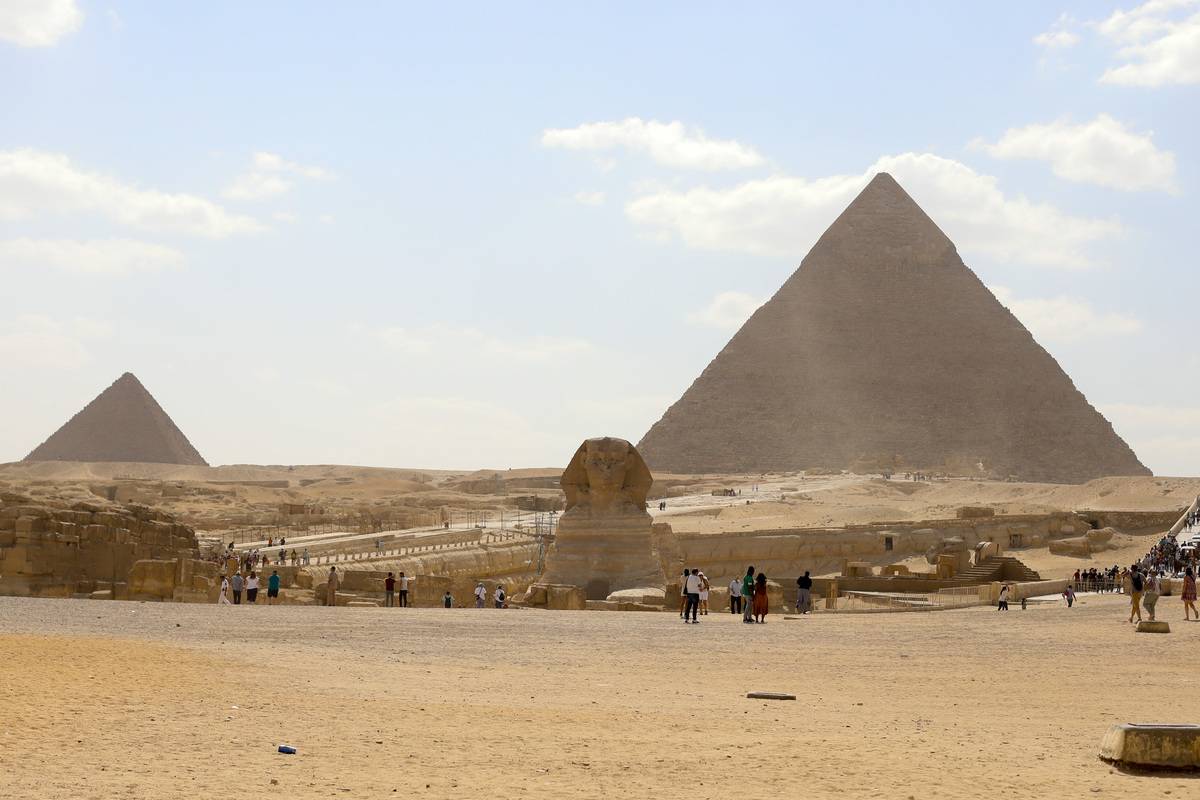
The Pyramid Of Giza Was The World's Tallest Structure For 3,871 Years!
For nearly 4,000 years the Pyramid at Giza held the record for the tallest human-made structure. It lost its impressive standing in 1311 when the Lincoln Cathedral was built in England. Unlike the pyramids, which took decades to build, the Cathedral took over 200 years to construct!
Looking at the Cathedral of Lincoln today, you would never think it was taller than the Pyramid at Giza. However, the building's central spire collapsed in 1549 and was never rebuilt. It held the title of tallest building for 238 years, which is nothing compared to the record it broke!
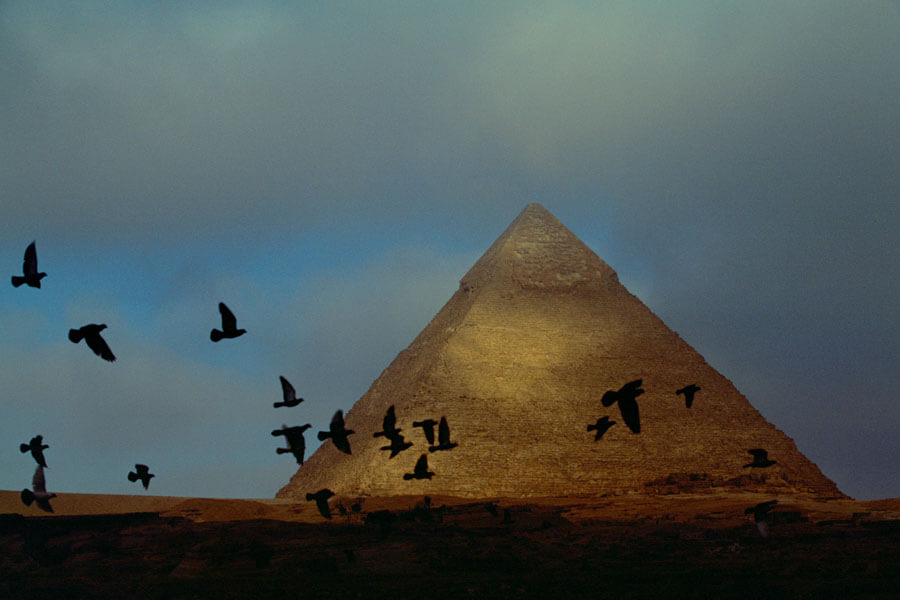
The Great Pyramid Is The Last Of The Seven Ancient Wonders Still Standing
The Great Pyramid at Giza is one of the "Seven Ancient Wonders of the World." Of these great wonders, it is the only one still standing today. Built between 2584 and 2561 BCE for Pharaoh Khufu, the pyramid has stood the test of time. No earthquake, merchant, or mob has been able to destroy the Great Pyramid.
The pyramid's six ancient brethren have not been lucky enough to stand the test of time. The Hanging Gardens of Babylon were destroyed by an earthquake. The Statue of Zuess also fell victim to an earthquake. A Christain mob tore down the Temple of Artemis in 401 CE. The Colossus of Rhodes was bought by a merchant in 654 CE and melted down. So the story goes.
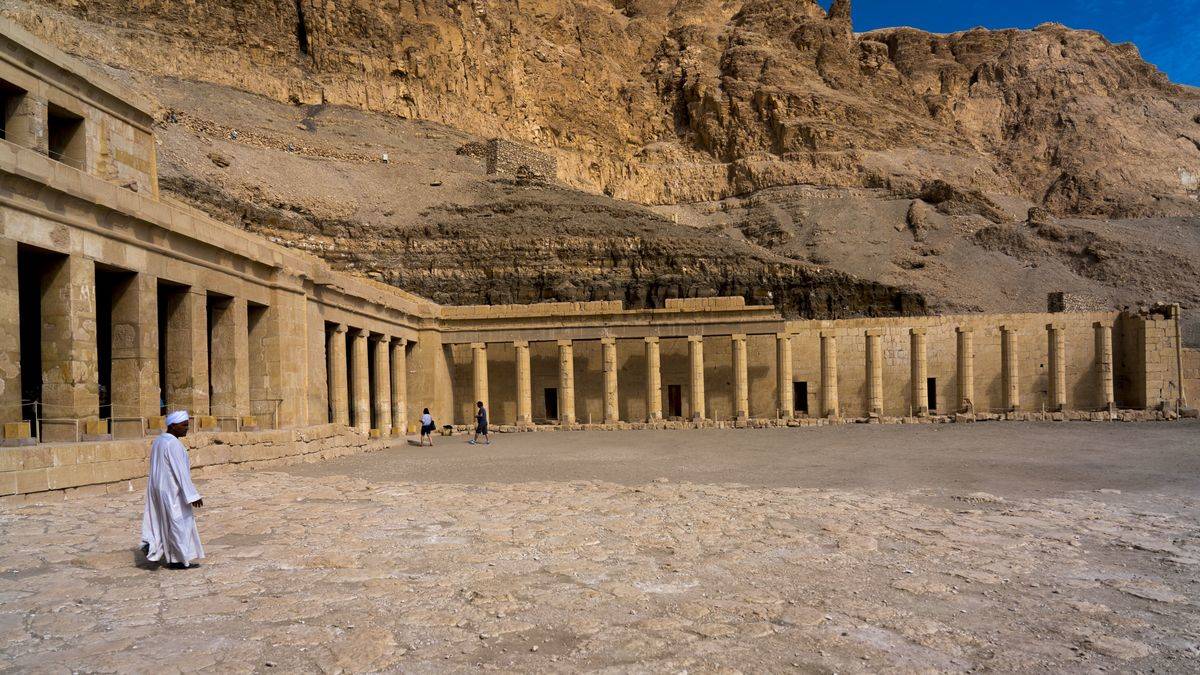
Every Pyramid Was Built On The West Bank Of The Nile
Egyptian pharaohs had pyramids built on the west bank of the Nile River to face the setting sun. It was in this direction they believed home of the dead was towards. Of course, this was not the only reason. Egyptian rulers rightfully feared that after death their bodies would be robbed, and built that pyramids as a way to protect them in the afterlife.
Unfortunately, the efforts the pharaohs of Egypt went through to keep their remains unharmed failed. Building their tombs in the middle of pyramids with several passageways blocked by stonewalls did not keep greedy graverobbers from finding all the hidden treasures.
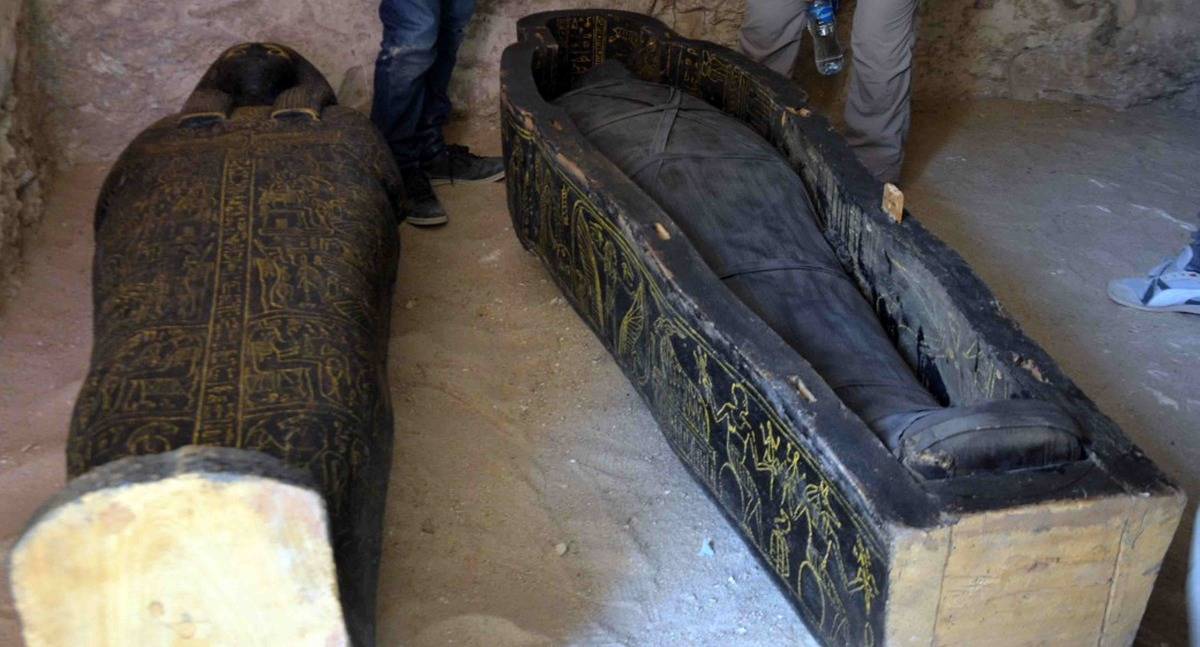
Egyptians Buried Themselves With Afterlife Goodies
Ancient Egyptians believed in life after death so much they buried themselves with objects for the dead to use. Buried treasures ranged from expensive to jewelry to everyday objects. One common item buried with every ruler was food. Being dead apparently leads to an incredible appetite!
Another interesting burial item many rulers had were small statues. These statues were believed to come alive in the afterlife and provide service for the pharaoh. In one uncovered tomb 400 statues were found. These statues were the only items found in the tomb.
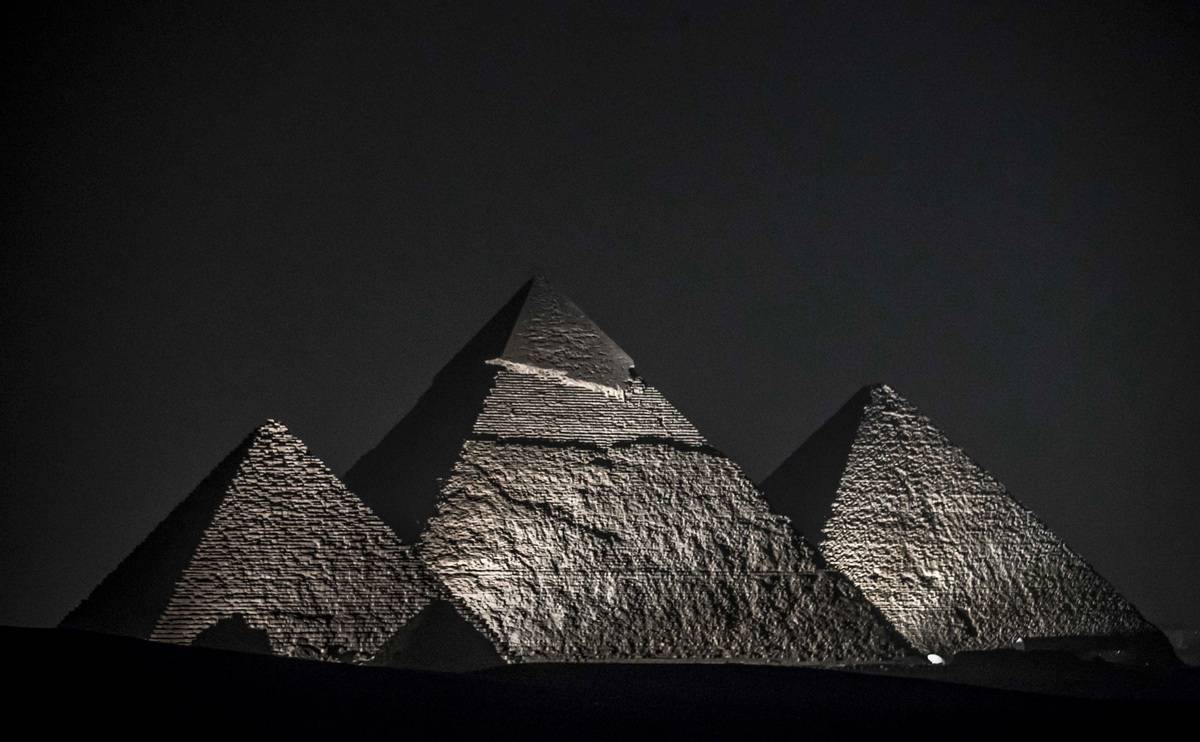
A Kurdish Ruler Failed To Destroy The Pyramids
In the 12th century, Al-Aziz thought it would be a good idea to destroy the pyramids. The Kurdish ruler and second Ayyubid Sultan of Egypt tried his best and failed. The task was too big and he gave up.
Of course, he did leave his mark on one pyramid. If you travel to see Menkaure's Pyramid today, you'll notice a sizable slash on one side. This is as far as Al-Aziz got in his devilish plan to destroy the pyramids. The simple fact that he failed so gloriously shows how incredibly these ancient structures were built.
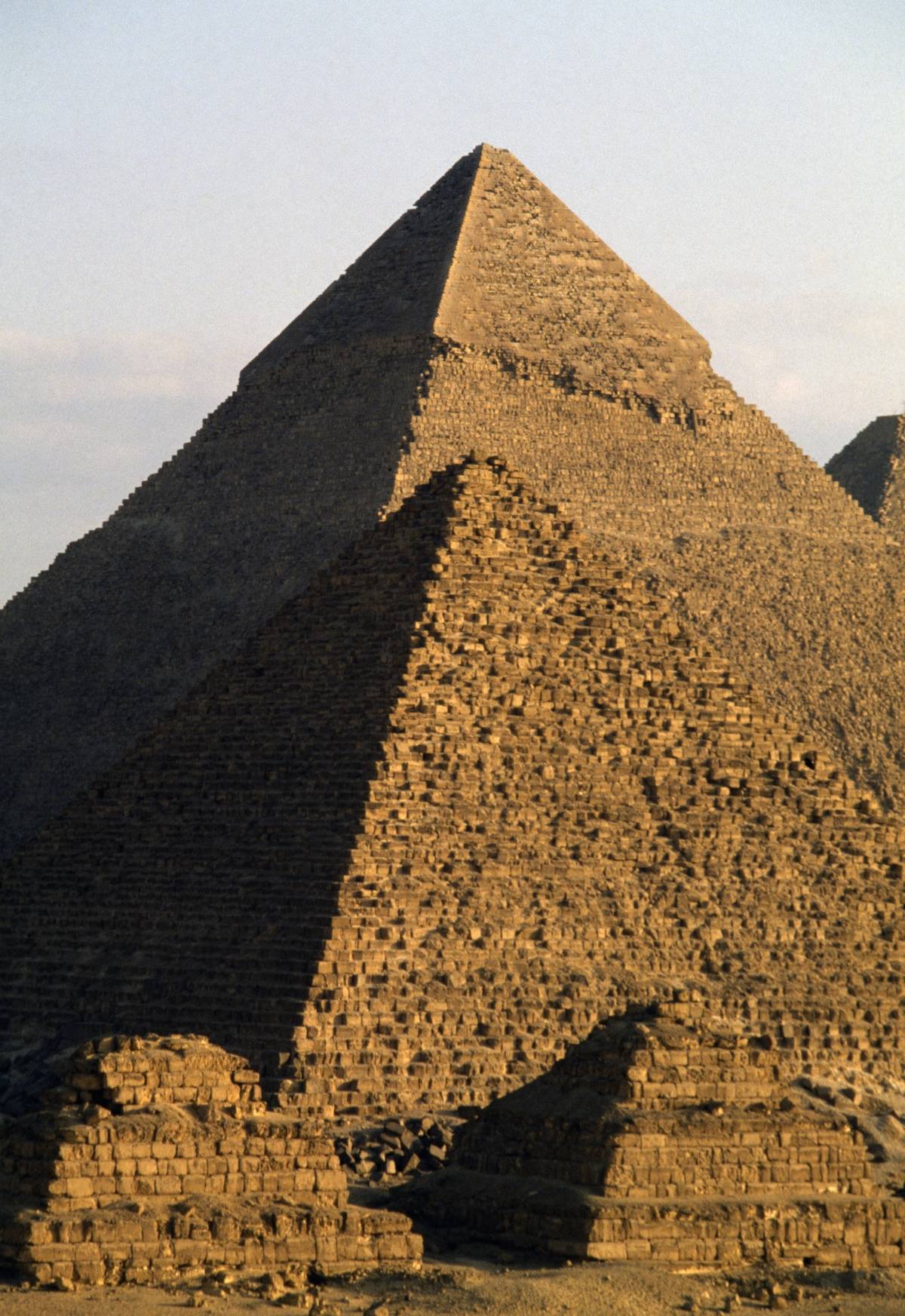
When Covered In Reflective Limestone, The Great Pyramid Could Be Seen From The Moon
Back in its glorious heyday, the Great Pyramid was literally the jewel of Egypt. Scientists believe the pyramid, covered in reflective limestone, could have been seen from the moon. They are more certain that people living in the mountains of Israel would witness its shiny glory.
There's a reason Egyptians called the Great Pyramid "Ikhet." The ancient word roughly translates to "glorious light." No one knows just how bright this light shined and no one has attempted to place reflective limestone back on the pyramid to find out!
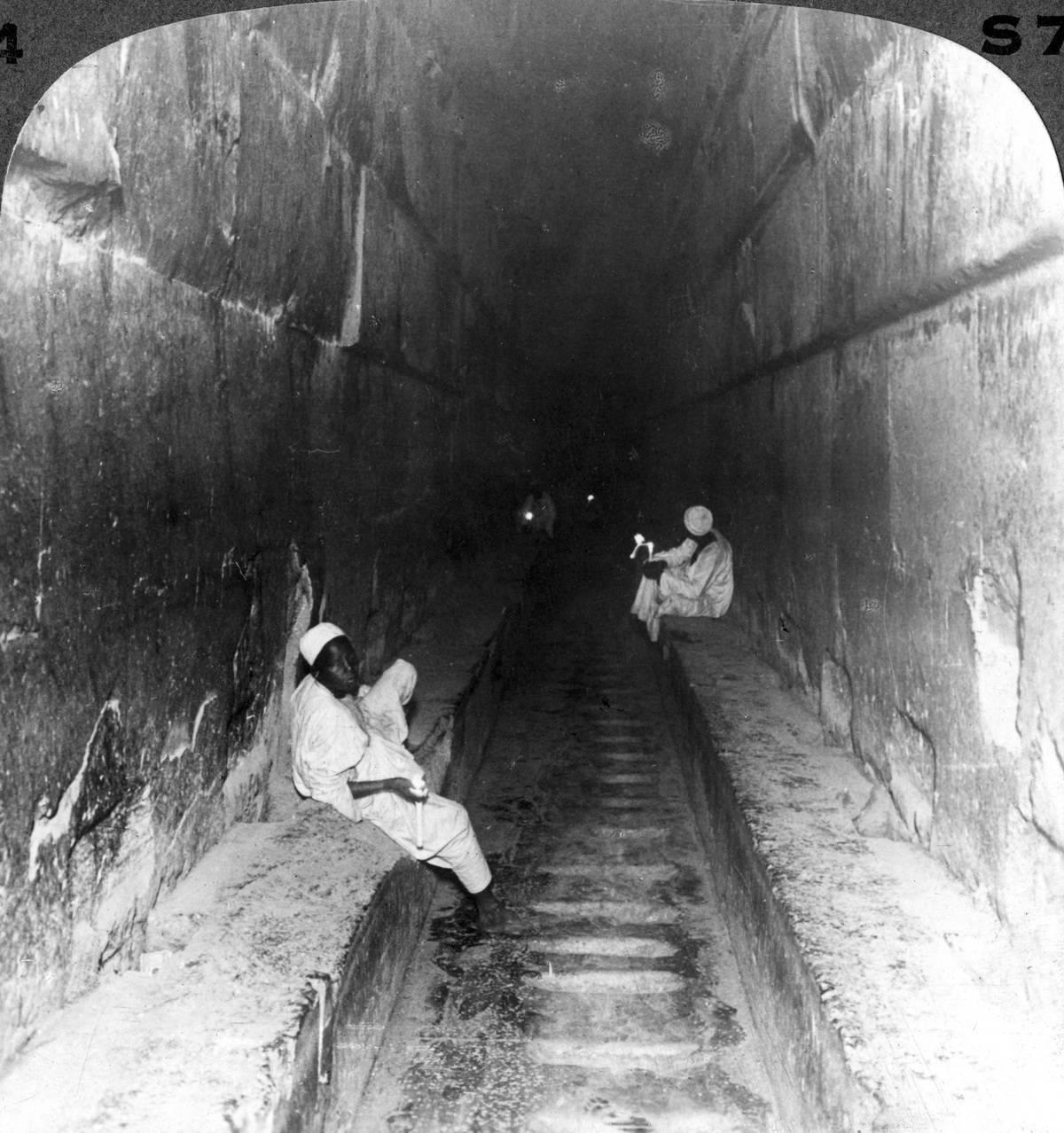
The Pyramids Are A Cool 68 Degrees Inside
Despite being pounded by intense heat, the pyramids of Egypt stay relatively cool inside. Temperature readings have the historic structures remaining around 68 degrees Fahrenheit. This fantastic feat or air cooling ingenuity is built right into the pyramid.
Leading to the Pharoah's chamber are numerous airshafts. When opened, they immediately allow cool air to enter. The temperature in the chamber would drop drastically as a result, letting the Pharaoh rest comfortably in death. The mind-blowing thing as that no matter the temperature outside, the chamber is a constant 68 degrees inside.
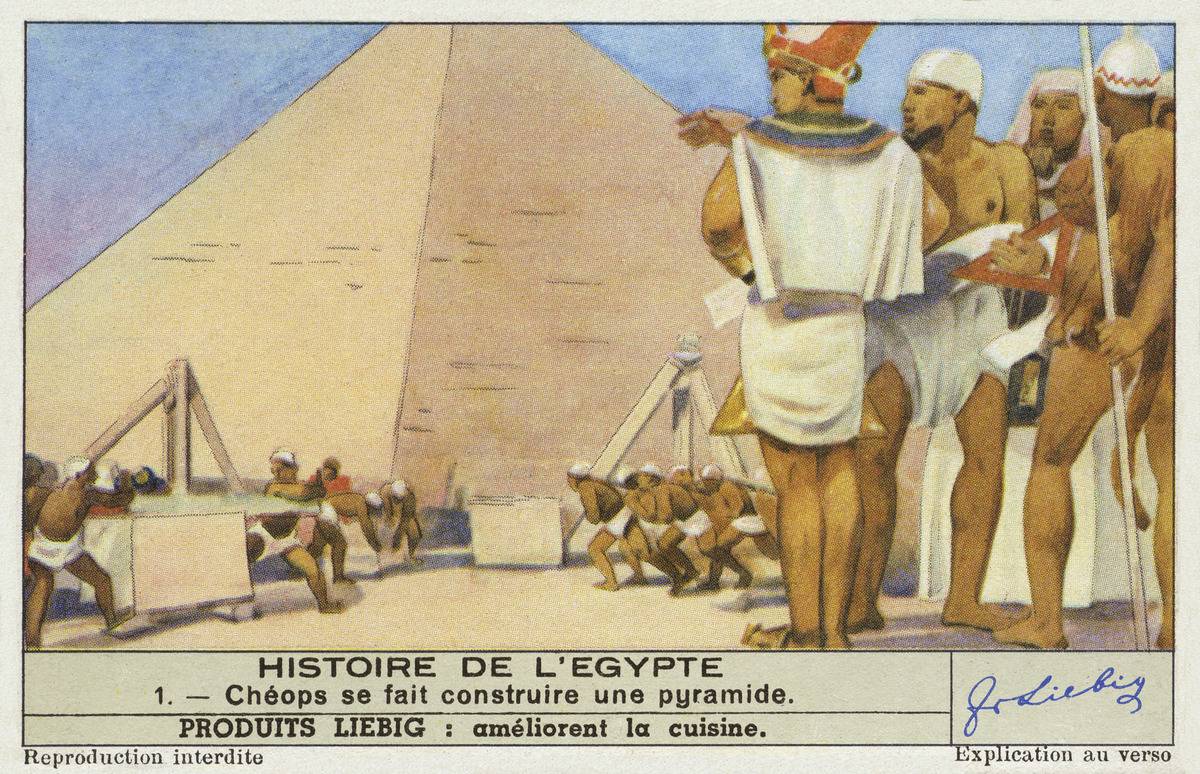
The Pyramids Were Not Built By Slaves
Despite everything you have been taught to believe, it's now known the pyramids were not built by slaves. Paid workers spent tireless hours constructing the pyramids. This workforce was brought in from the north and south and was highly respected for the art they created.
Amazingly, the discovery of paid workers was not made until 2010. During an expedition, archaeologists found the tombs of the pyramid workers. The bodies had been preserved in the sand and were buried with bread and beer to provide sustenance in the afterlife.
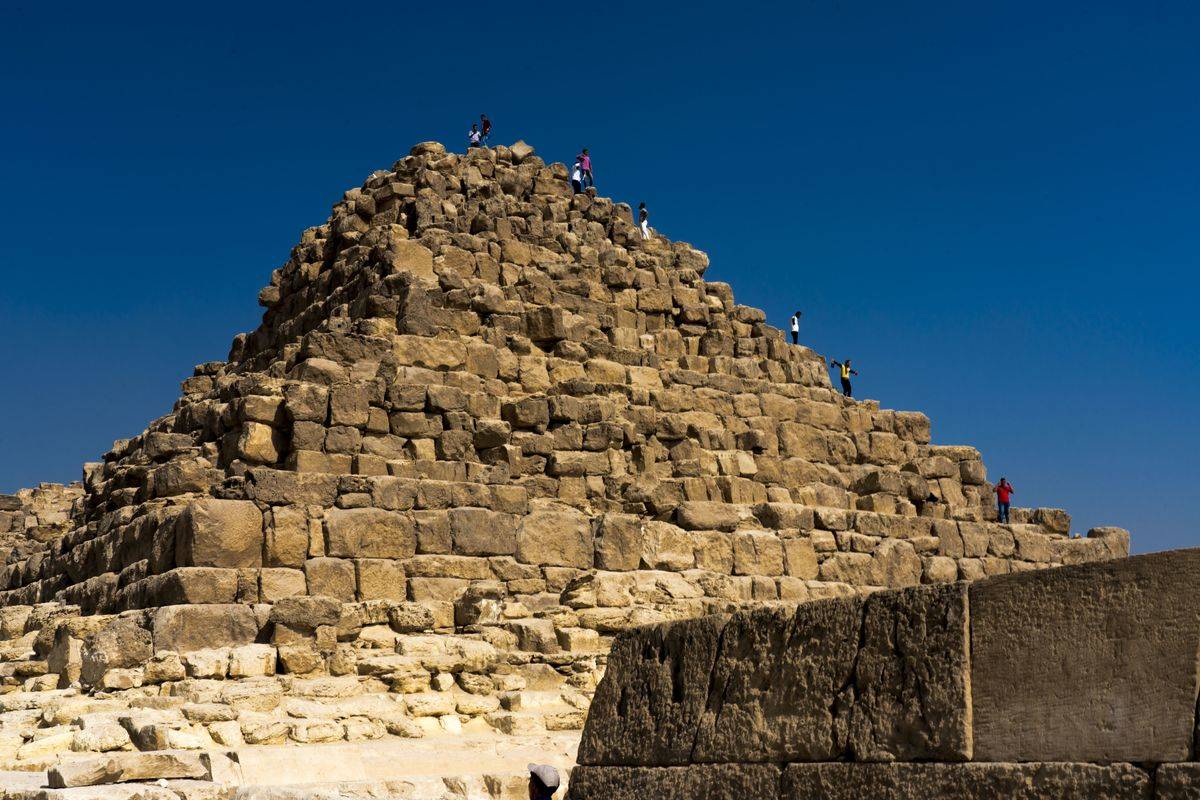
No One Knows What Glue Held The Pyramids Together
Built stone by stone, the pyramids are some of the most stable structures in the world. Modern scientists, however, still don't know how or why. The adhesive holding the stones together has yet to be broken down into its basics.
Scientists know that the glue holding the stones together is incredibly strong. That, unfortunately, is where their knowledge ends. The combination of ingredients used to create the adhesive remains a mystery. All that is known is what is seen. The glue between the stones is strong enough to make the pyramids nearly indestructible.
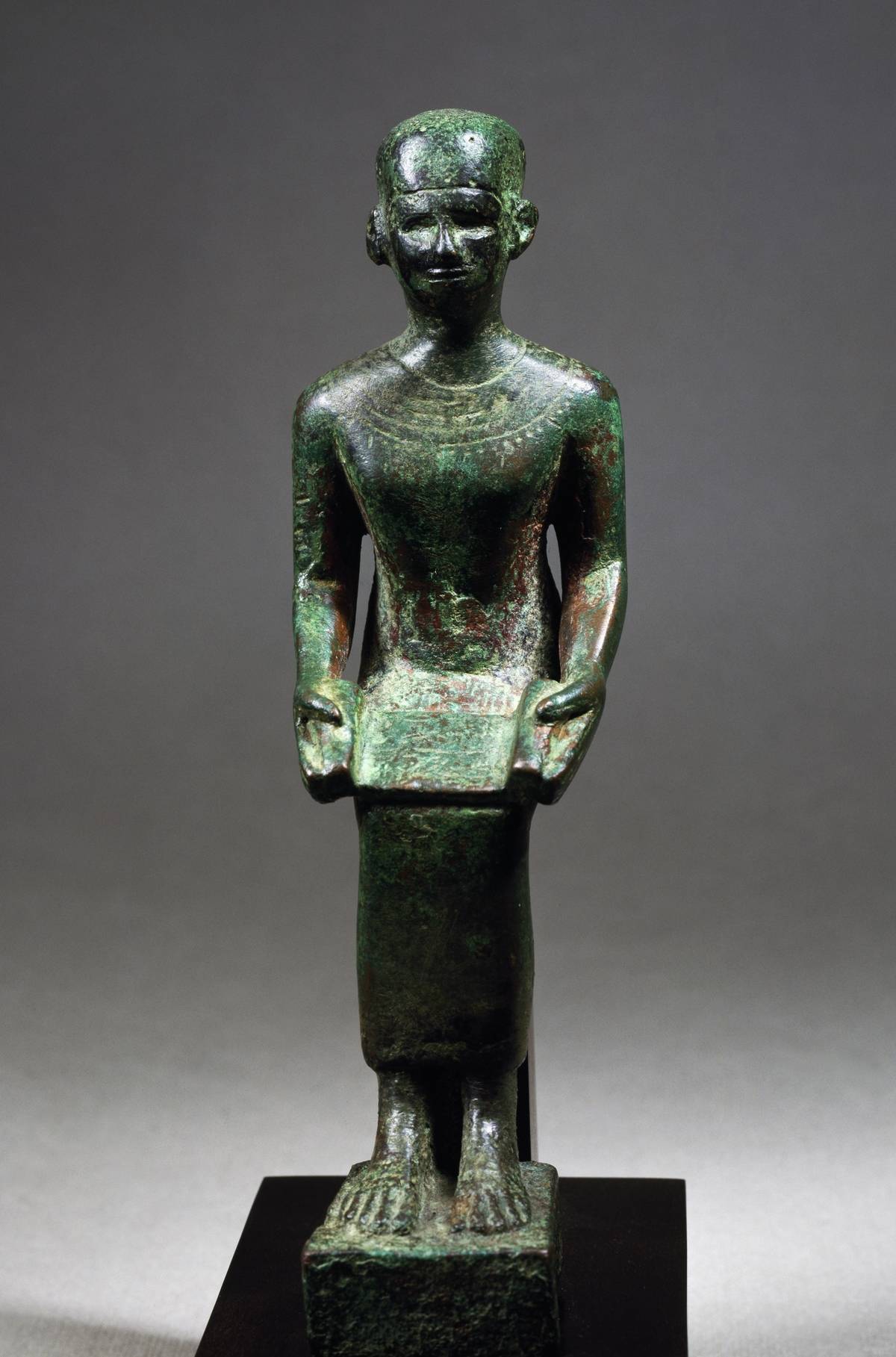
Imhotep Designed The First Pyramid
We're not talking about Imhotep from The Mummy movie franchise. The character might be named after a real Egyptian deity, but that is where the similarities end. The real Imhotep was a master architect during his time and chief minister to Djoser.
Imhotep is regarded as the architect of the first step pyramid. He was held in such high regard by Djoser that a statue bears his name in the King's court. Oddly enough, Imhotep was more than just an architect. He made his real mark in medicine and was worshiped as the God of Medicine in Egyptian lore.
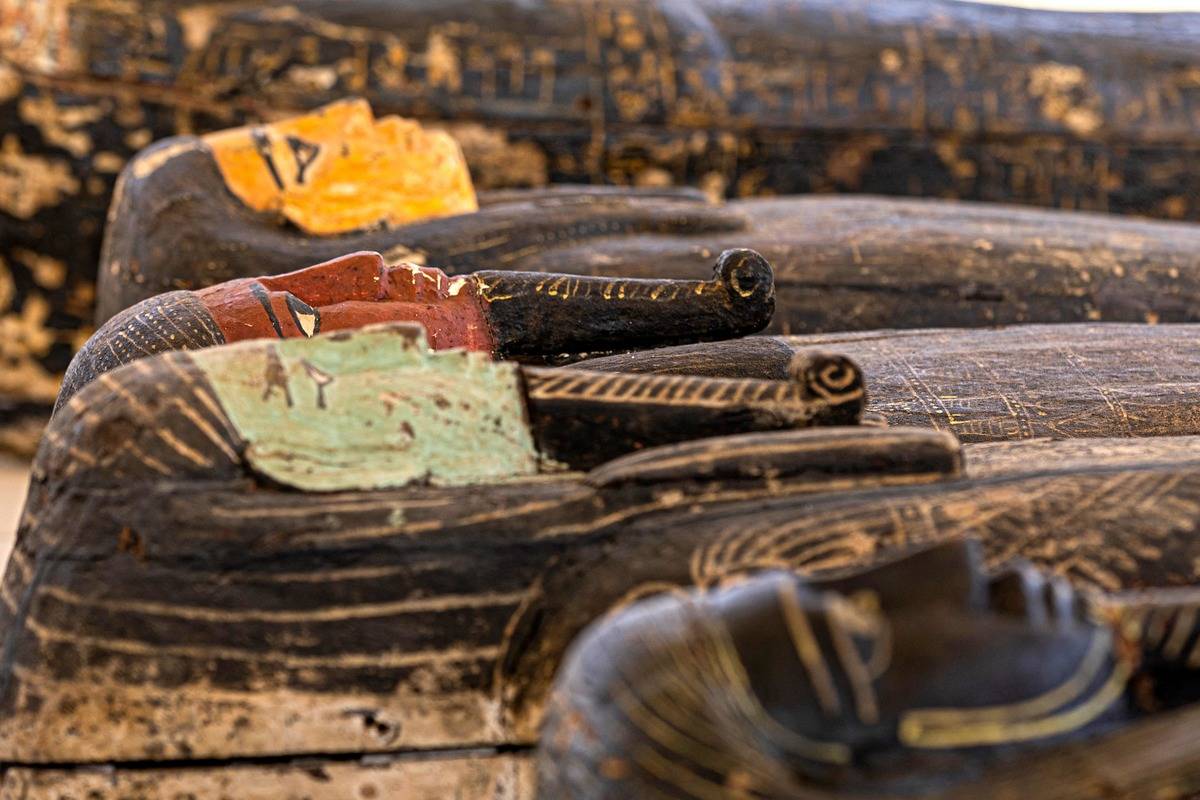
The Egyptian Afterlife Is Free From Pain And Sorrow
We already know that the purpose of the pyramids was to help guide souls into the afterlife. What we haven't learned yet is what Egyptians believed the afterlife held. Obsessed with life after death, Egyptians also believed that their land was God's chosen place for humans to live.
With that in mind, they imagined that what came after death was a mirror of the land of the living. The only thing missing was pain and sorrow. This belief is why Egyptians buried their loved ones with food, drink, and jewelry; everything they believed was necessary for the soul in its next existence.

Hieroglyphics Are Not In The Pyramids
Hieroglyphics will forever be associated with Egyptian culture. However, until recently there were no known hieroglyphics in the pyramids. Within the Great Pyramid, there are chambers only big enough for robots to explore. In 2002 a robot found a small chamber with nothing in it.
Another robot recently explored the Great Pyramid and made a miraculous discovery. This robot, using a "micro-snake" camera, found hieroglyphics, the first known in a pyramid. If scientists can decipher what these symbols mean, it could help solve several mysteries still surrounding the pyramids. One of those mysteries is how pyramids could tell time.
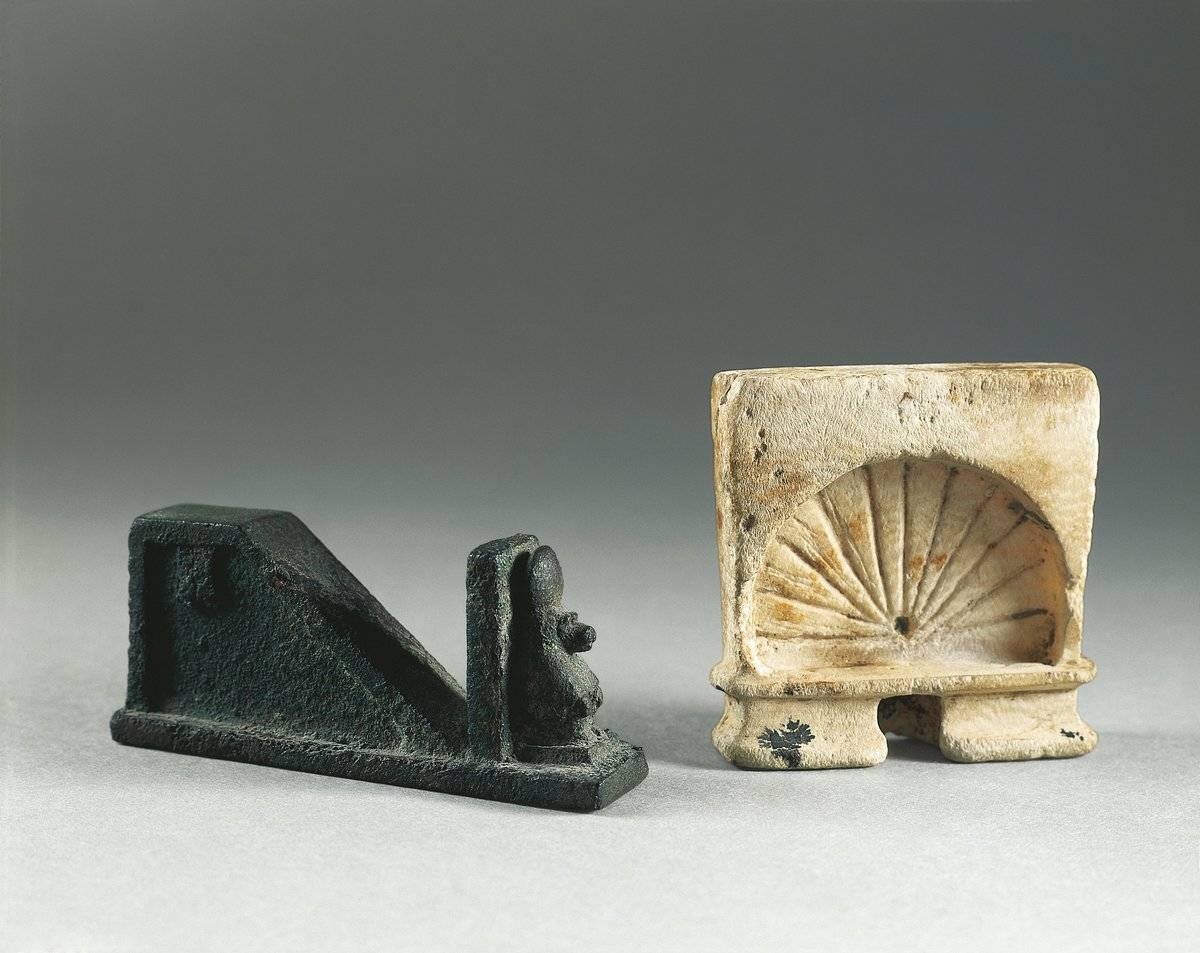
Pyramids Could Tell Time
One of the most significant mysteries still surrounding the construction of the pyramids why they were designed to tell time. The Great Pyramid cast no shadow at noon, indicating that it is more than just an ancient tomb; it is also a sundial. Not just any sundial though, one of the most complex ever built.
Sundials are one of the earliest forms of timekeeping. Designed to cast a shadow based on the positioning of the sun, Sundials are the most accurate way to tell time. To be able to build a pyramid as one of the most accurate sundials ever produced astounds archaeologists.
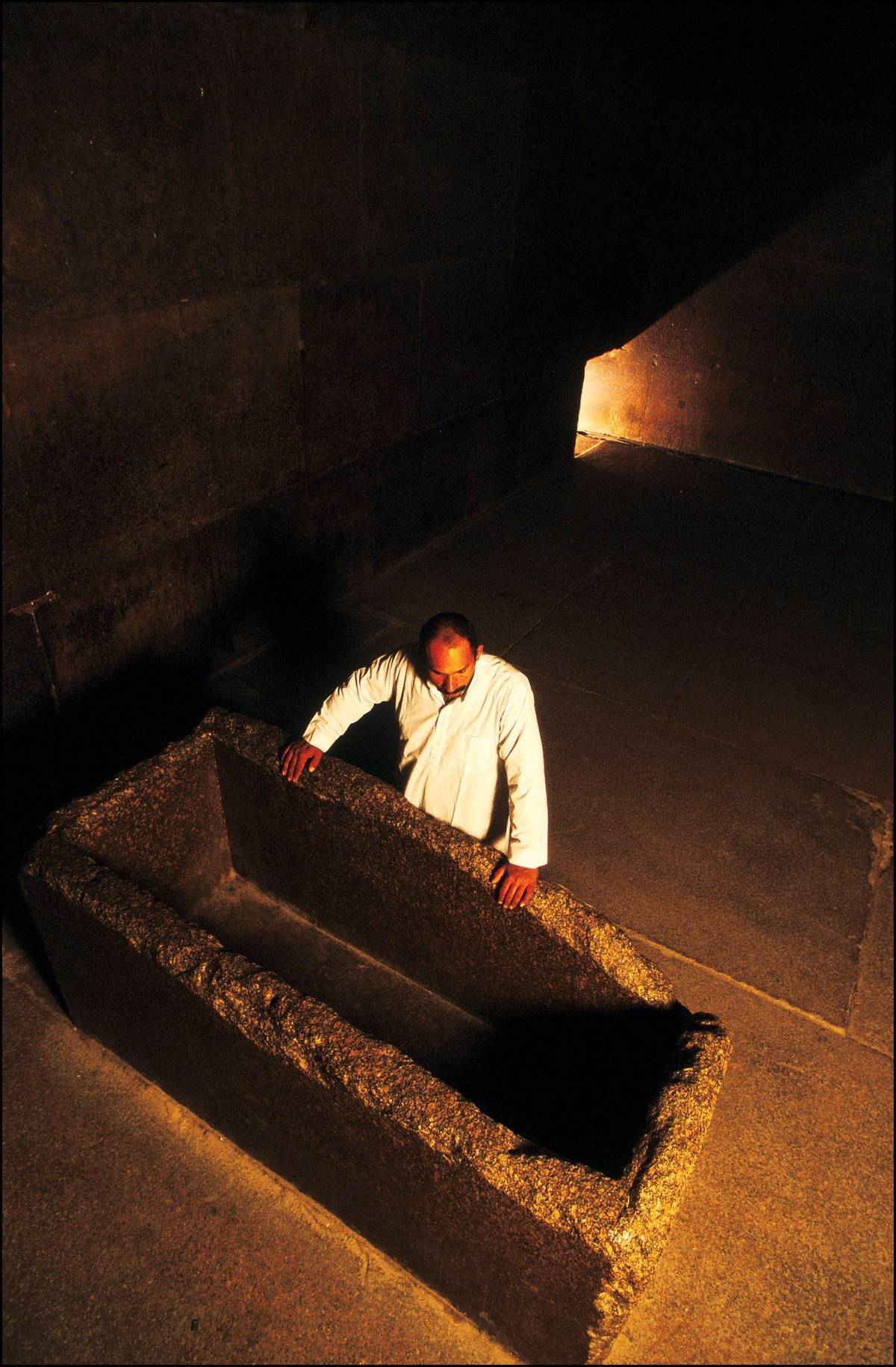
The Great Pyramid At Giza Was Not A Tomb
The biggest mystery surrounding the Egyptian pyramids remains the purpose of the Great Pyramid at Giza. The structure has been investigated countless times, and a mummy has never been discovered. When first explored by Arabs in 820 AD, the only thing found was a granite box known as the "coffer."
This lack of bodies contradicts the mainstream theory that pyramids were tombs to provide pharaohs and eternal resting place. If the Great Pyramid is not a tomb, then what is it? Someday maybe the mystery will be solved, until then we'll enjoy the guessing game!
More for You
7 Ways People Destroy the Value of Their Homes, According to a Real Estate Agent
19 Things People Treat As Safe That Actually Are Pretty Dangerous
Putin is using 'nuclear blackmail' — and Russia defeating Ukraine could spark global chaos and economic disaster, Jamie Dimon warns
How Much Beer You'd Have To Drink To Equal A Single Shot Of Liquor
Do I have to pay off my spouse's debts when they die? Here's what you're responsible for and what you aren't after a loved one's death
7 Things Stroke Doctors Say You Should Never, Ever Do
One of these pictures of me is real and the other is AI – but which is which?
Trump World rocked by Arizona fake elector indictments as Trump's legal peril snowballs
Billionaire forced to demolish Nantucket beach home
NATO Aircraft Activated After Waves of Russian Strikes
Scientists have discovered the maximum age a human can live to
19 Things That Will Happen When You Stop Drinking Alcohol
The meteoric rise and stunning fall of Prime, Logan Paul’s energy drink that was once resold for almost $1,500 a can: ‘A brand cannot live on hype alone’
Jay Williams slams D'Angelo Russell for being on his phone during team huddle: "I don't want him on my roster"
Best Movies Now on Netflix
Nvidia set to capture billions as Microsoft, Google and Meta boost AI spending
Liz Cheney's Message to Supreme Court After Donald Trump Hearing
John Jacob Astor IV was one of the richest men in the world when he died on the Titanic. Here's a look at his life.
This is one of the most advanced humanoid robots in the world
The Japanese dish that has become a tourist attraction for thousands: ‘It’s a way of life’

IMAGES
VIDEO
COMMENTS
Quick Facts (Main Pyramid). Date: 2560 BC Height: 150 meters (500 ft) Base Length: 150 meters (500 ft) Weight: 6 million tons No. of Blocks: 2.3 million Builders: 200,000+ Best Day Tours To The Egypt Pyramids. First of all, if you're on a tight schedule and want to skip the extra steps involved in arranging your own trip to the pyramids, or if you'd rather travel in a tour group for safety ...
The Egyptian Pyramids are located within the Pyramids complex on the Giza plateau approximately 25km (15 miles) south-west of Downtown Cairo. ... As you travel around Egypt, you will notice that all tombs are located on the West Bank of the Nile. 14 Top Tips for Visiting the Egyptian Pyramids of Giza 1. When is the best time to visit the ...
According to the official Egyptian tourism website, the site opens at 9 a.m. every day and closes at 5 p.m. Ticket prices are listed as 60 Egyptian pounds for general admission, 100 Egyptian pounds for entry into the Great Pyramid, 30 Egyptian pounds for entry into the Pyramid of Khafre and 25 Egyptian pounds for entry into the Pyramid of ...
Egypt's most famed and feted structures, these ancient tombs of kings guarded by the serene Sphinx have wowed spectators for centuries. Pyramids of Giza. Today, the Pyramids of Giza continue to work their magic on all who visit. No trip to Egypt is complete without time spent here at one of the world's most famous tourist attractions.
0.21 MILES. Along the Great Pyramid of Khufu's east face, three small structures some 20m high resemble piles of rubble. These are the Queens' Pyramids, the tombs of…. The last remaining wonder of the ancient world; for nearly 4000 years, the extraordinary shape, impeccable geometry and sheer bulk of the Giza Pyramids….
The pyramids of Giza and the Great Sphinx are among the most popular tourist destinations in the world, and indeed already were even in Roman times. Each of these spectacular structures served as the final resting place of a king of the 4th Dynasty (c.2613-2494 BC). The Great Pyramid of Giza was built for king Khufu (c.2589-2566 BC), and the other two for Khafre and Menkaure, his son and ...
The Pyramids of Giza are without a doubt Egypt's most iconic destination. The Pyramids are a remnant of Ancient Egypt, built almost five thousand years ago, and the oldest of the Seven Wonders of the World. These ancient structures are not only one of the world's greatest wonders, but one of its biggest mysteries, too: historians still don ...
Historical Significance: Beyond their awe-inspiring presence, the pyramids serve as tombs for pharaohs, offering a glimpse into the profound cultural and religious beliefs of ancient Egypt. Exploring their chambers and hieroglyphics provides a window into this ancient civilization. Sphinx Encounter: Adjacent to the pyramids stands the Great Sphinx of Giza, a colossal statue with the body of a ...
The Great Pyramid, the tomb of King Khufu (c.2589-2566 BC), with its original height of 146.5 meters, was the tallest structure in the world for 3,800 years. It remains the last surviving member of the Seven Wonders of the Ancient World, and took an estimated 10 to 20 years to build. To this day, it is not entirely certain how this was done. The Great Pyramid is made of local limestone, but ...
The pyramids of Egypt fascinated travellers and conquerors in ancient times and continue to inspire wonder in the tourists, mathematicians, and archeologists who visit, explore, measure, and describe them. Tombs of early Egyptian kings were bench-shaped mounds called mastabas. Around 2780 BCE, King Djoser's architect, Imhotep, built the first ...
Pyramids of Giza, three 4th-dynasty (c. 2575-c. 2465 BCE) pyramids erected on the west bank of the Nile River near Al-Jizah (Giza), northern Egypt. In ancient times they were included among the Seven Wonders of the World. Learn more about the Pyramids of Giza in this article.
Welcome to the ultimate guide to visiting the Pyramids of Giza, one of the most iconic ancient wonders of the world. Located on the outskirts of Cairo, Egypt, the Pyramids of Giza are an architectural marvel and a testament to the skill and ingenuity of the ancient Egyptians. This ancient necropolis holds the Great Pyramid of Khufu, the Pyramid ...
Grab Breakfast or Lunch at 9 Pyramids Lounge. Another thing to do when you visit the Pyramids of Giza, is to grab a bite at 9 Pyrmaids Lounge. This is one of the best places to eat while being in front of the Pyramids. Reservations are usually required, so if you want to make this happen, do it in advance.
Tourism is Egypt's second largest source of revenue, bringing in $13 billion in 2010. The Great Pyramid at Giza, after all, is one of the seven ancient wonders of the world. To visit the ...
In 2016, teenage tourist Andrej Ciesielski received a lifetime ban from Egypt after posting photos and videos of his pyramid climb on social media. In 2019, a law banning climbing on Egypt's antiquities was introduced, carrying with it penalties of at least one month in prison and fines of more than $6,000.
Many of these tourists took pictures in front of the ancient ruins or the Great Sphinx, some of them even climbed all the way to the top of the pyramids. British tourists. 1900. Scores of photographers, seeking to establish their studios, began arriving in Egypt following the tourist gaze.
Tourists exploring Egypt's Giza Pyramids can now enjoy a great meal afterwards, with the opening of the first-ever restaurant on Pyramid Plateau. The 9 Pyramid Lounge, which opened in late ...
Join National Geographic Expeditions on a group tour of Egypt. During our trip we'll visit many famous locations such as the Giza Pyramids & Nile River! 11 Days / 10 Nights
The Egyptian pyramids are ancient masonry structures located in Egypt. ... The Giza pyramid complex has been a popular tourist destination since antiquity and was popularized in Hellenistic times when the Great Pyramid was listed by Antipater of Sidon as one of the Seven Wonders of the Ancient World. Today it is the only one of those wonders ...
History Income from tourism (1982-2003) The number of tourists in Egypt stood at 0.1 million in 1952. Tourism became an important sector of the economy from 1975 onwards, as Egypt eased visa restrictions for almost all European and North American countries and established embassies in new countries like Austria, Netherlands, Denmark and Finland.In 1976, tourism was a focal point of the Five ...
The number of tourists visiting Egypt has plummeted from 14.7 million to 5.4 million in 2016, according to the United Nations World Tourism Organisation, or UNWTO, costing the country billions.
Before your trip to Egypt, ensure your cards are ready for international use. Enable international transactions through your bank's app or net banking portal. Alternatively, visit a branch for ...
We travel deeper into the stars. Unas' Pyramid Texts, on the walls of his burial chamber, lay out protections against serpents and dangers. They also introduce offerings, to sustain the King's soul and nourish the gods. Includes passages in English translation and ancient Egyptian. Date: c.2320 BCE…
Millennial mummies, mouthwatering food and thousands of histories are waiting: welcome to Egypt! Get to know this ancient civilization and wonder at some of humanity's most impressive monuments. Enjoy breathtaking views over the Nile, the oldest Pyramids of the world and stories of treason and love. Ready for the trip of a lifetime? In an effort to make your trip a streamlined process ...
This is the real history behind who built the pyramids of ancient Egypt. The Mystery Behind Who Built The Pyramids. Egypt is all but synonymous with pyramids, given that more than 100 of the ancient structures dot the country's landscape. The first, and largest, was the Pyramid of Djoser. Construction of the tomb began around 2667 B.C.E.
Billionaire Ankur Jain and former WWE wrestler Erika Hammond tied the knot Friday in an over-the-top ceremony that took place in front of the Great Pyramids in Egypt. "We're New Yorkers and ...
Northwest of Memphis, the Pyramid of Djoser is believed by the scientists to be the oldest Egyptian pyramid. Erected during the 27th century BC, the pyramid is surrounded by a courtyard and ...